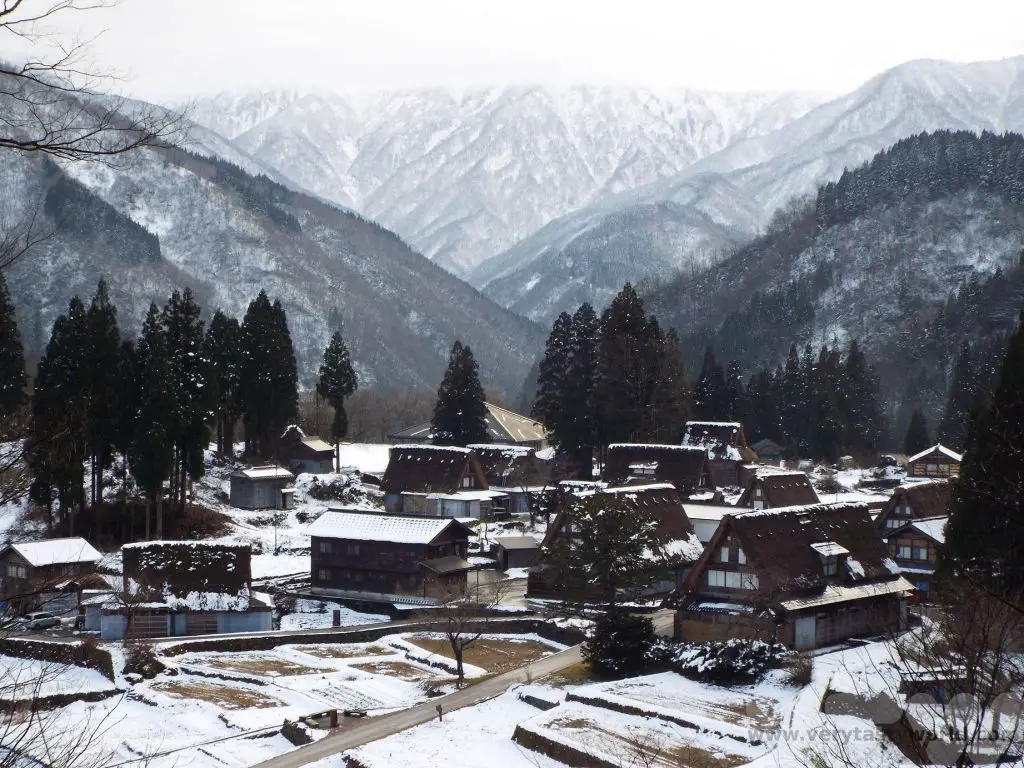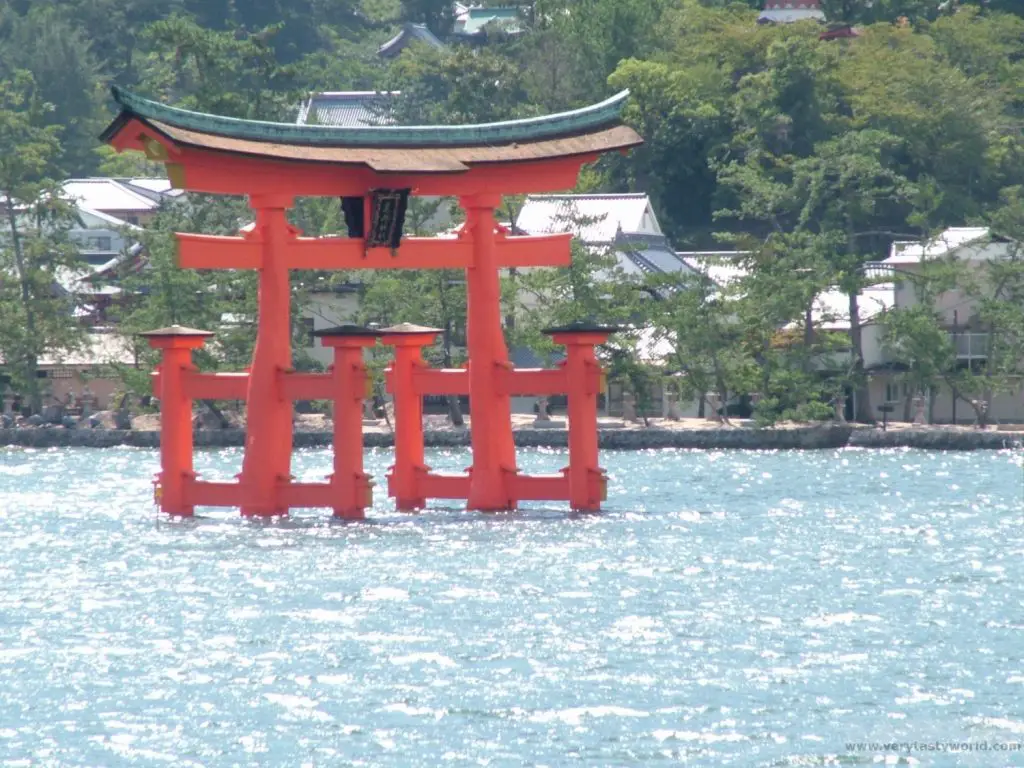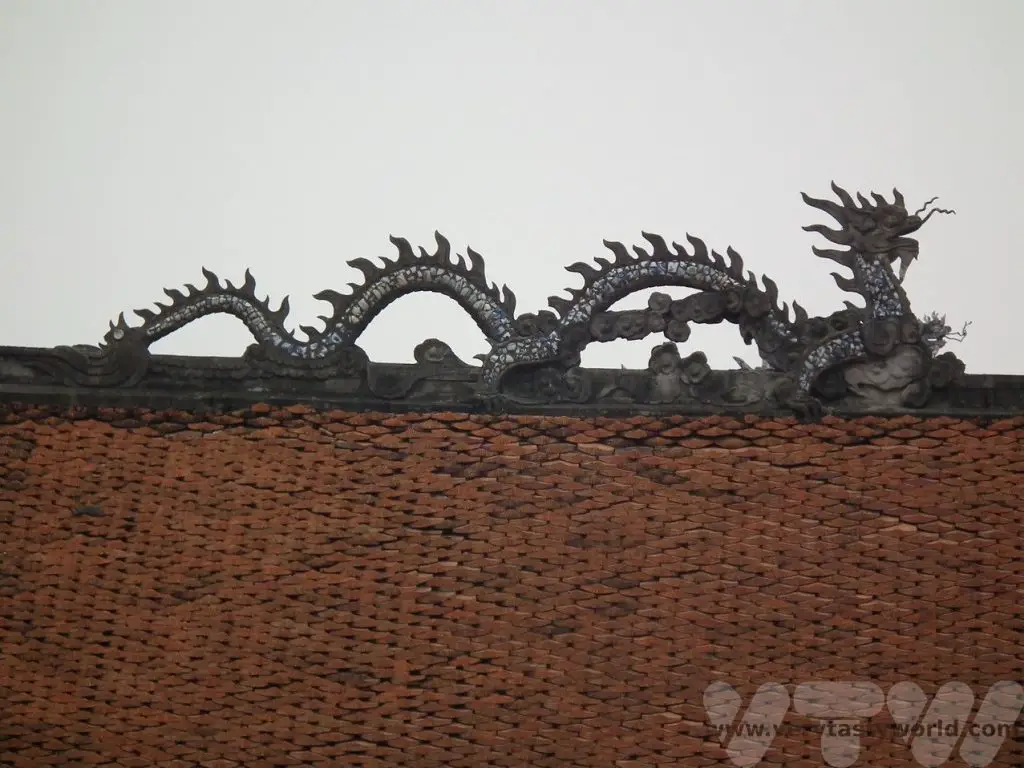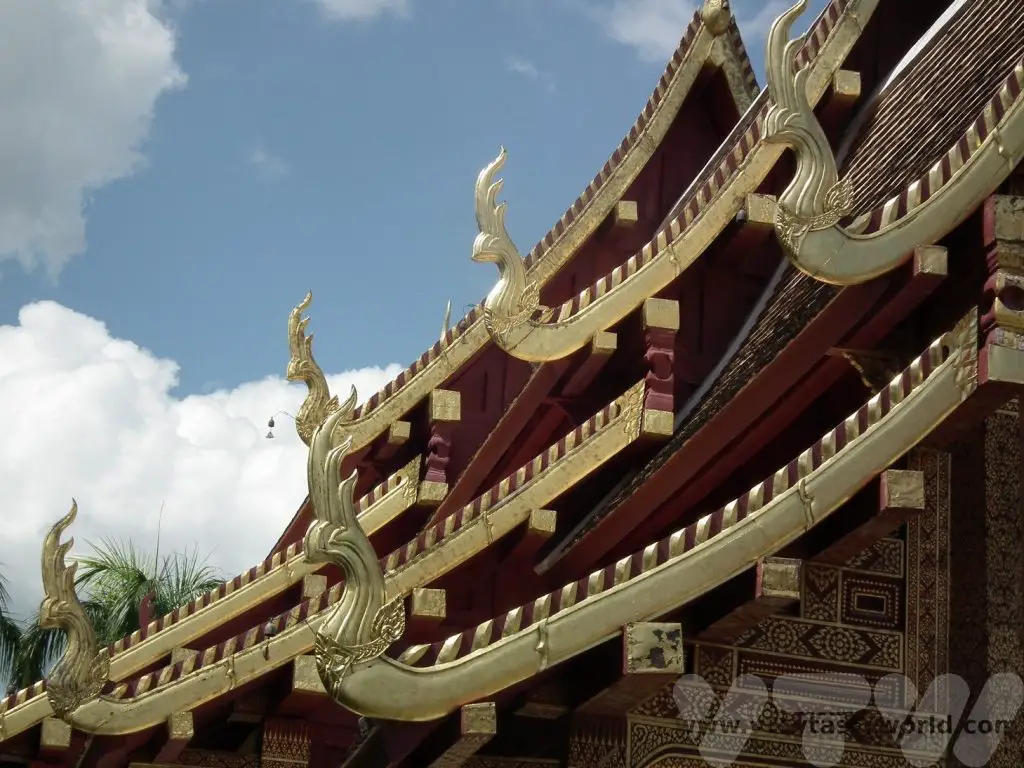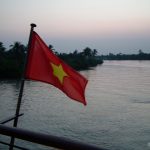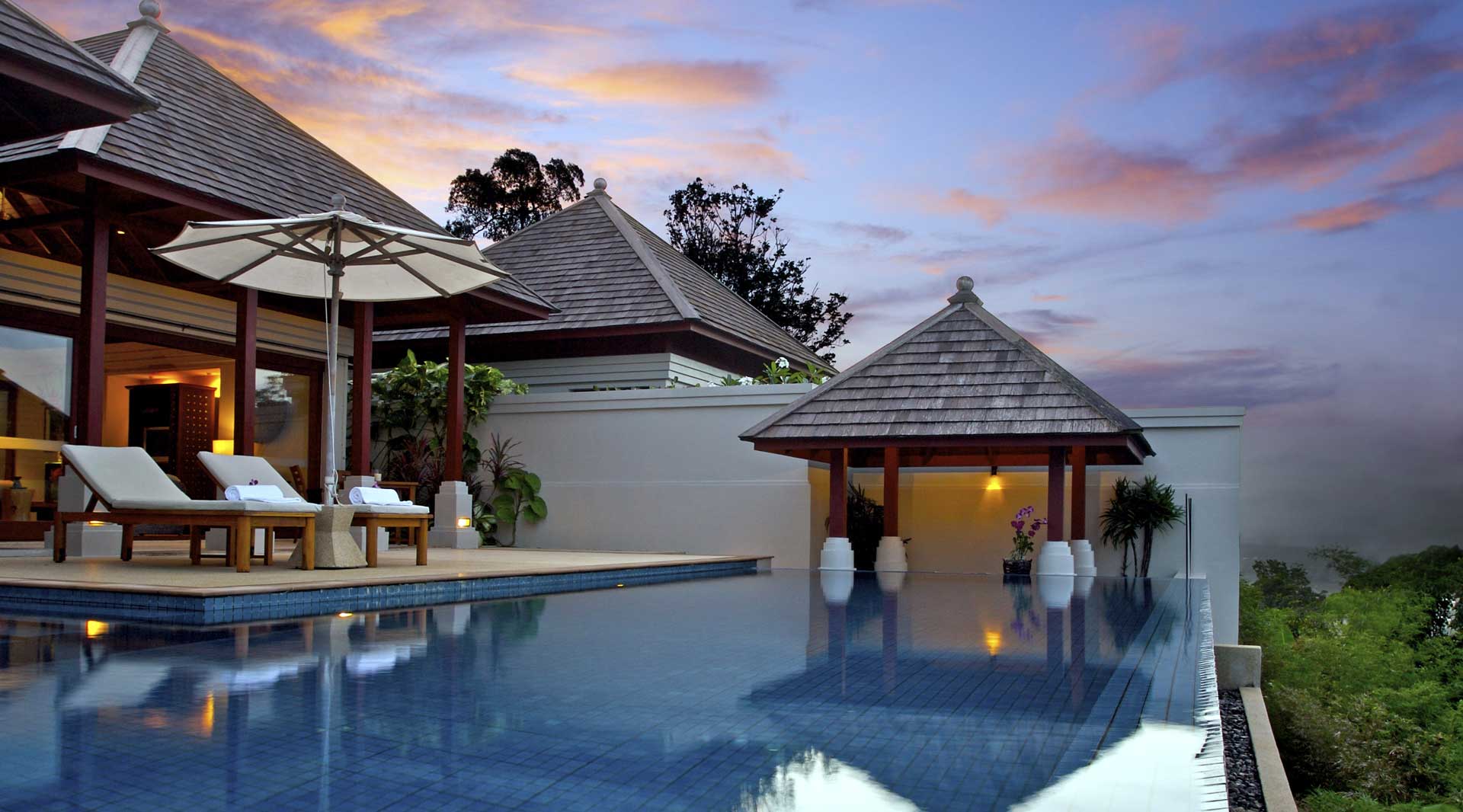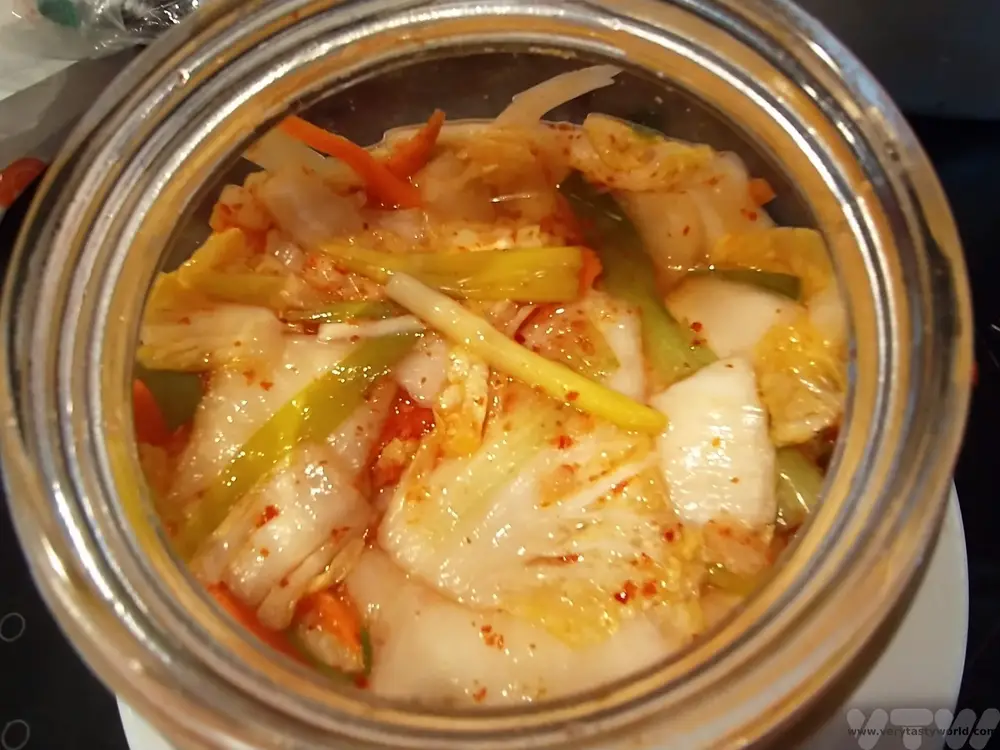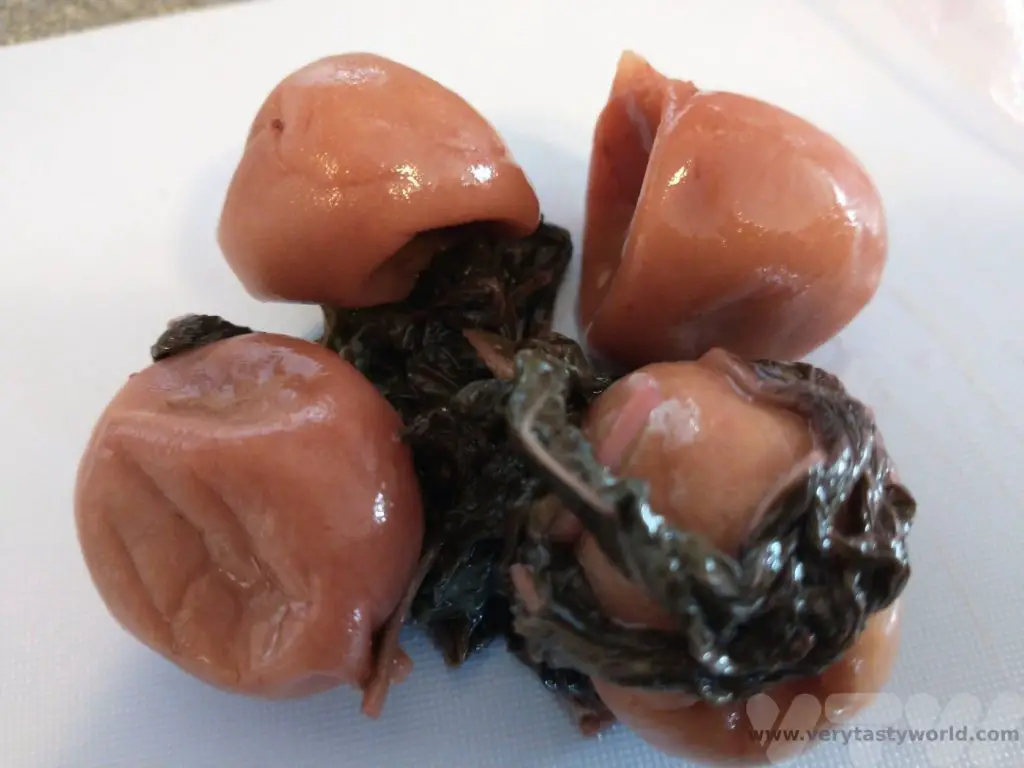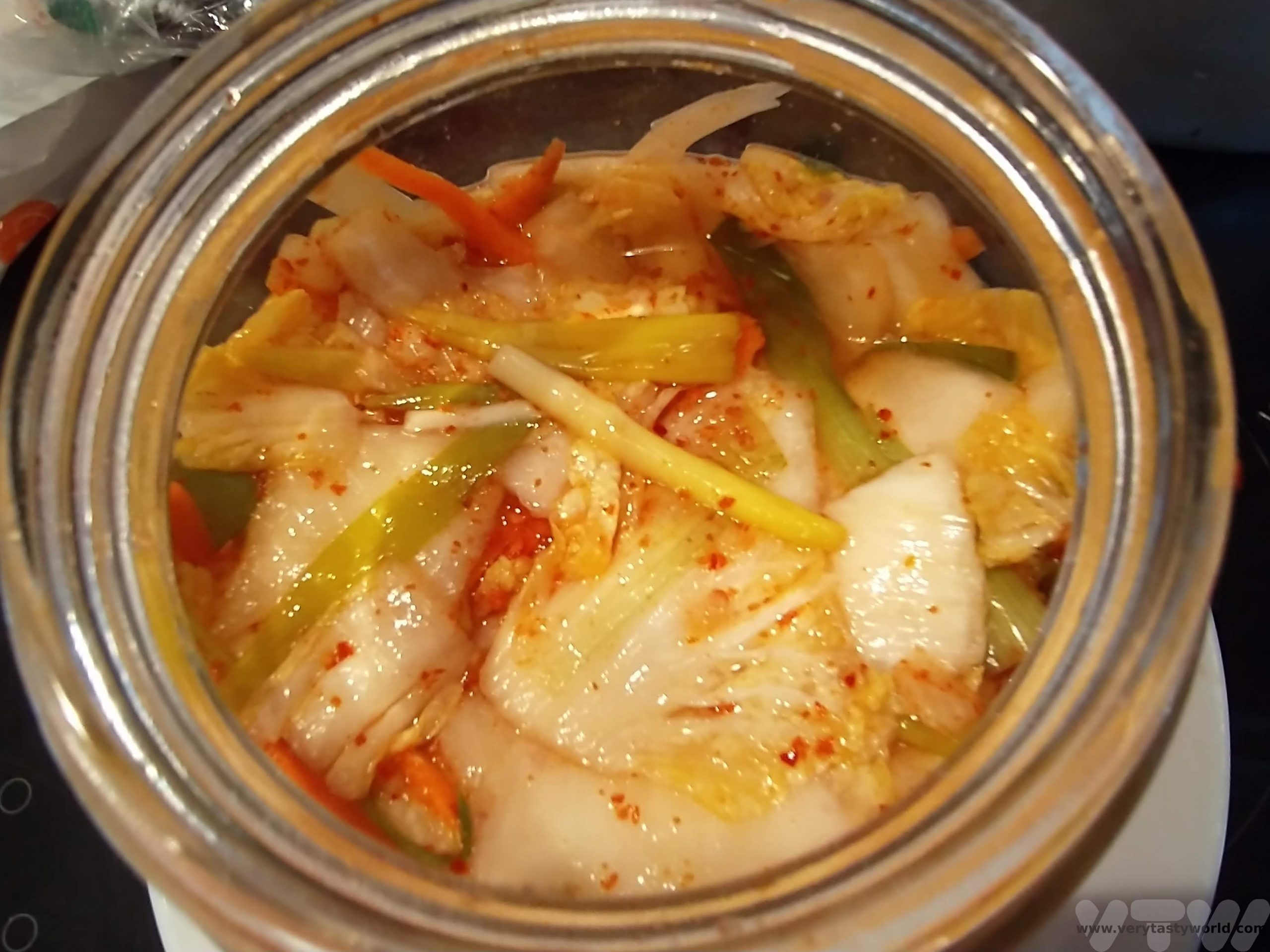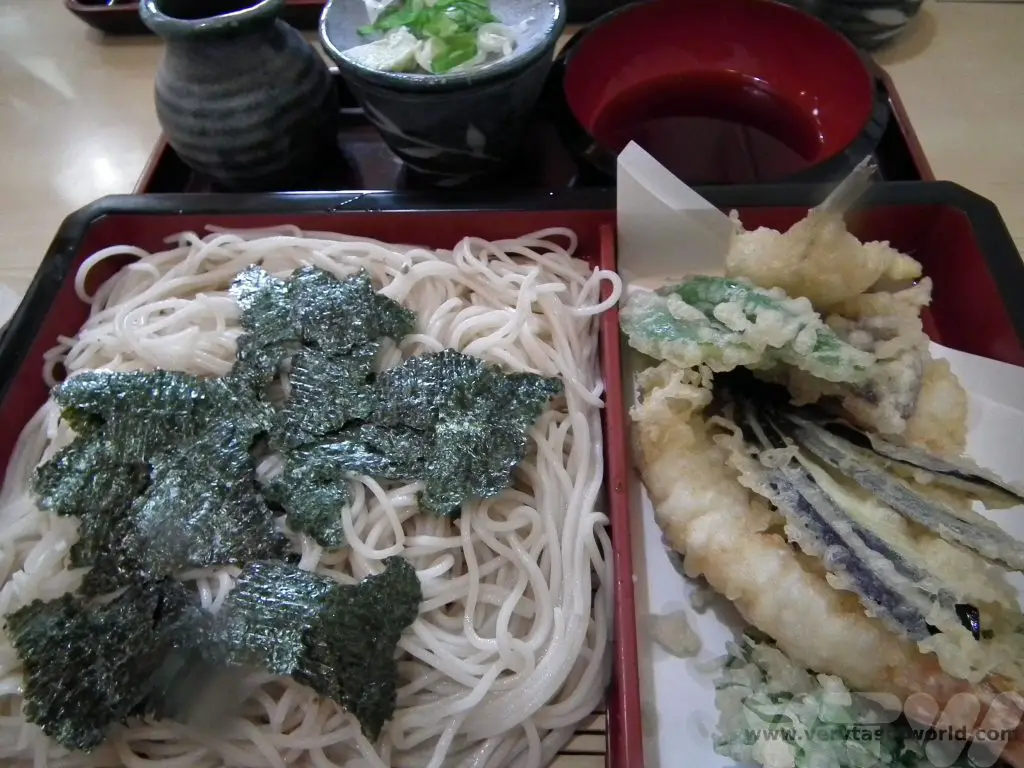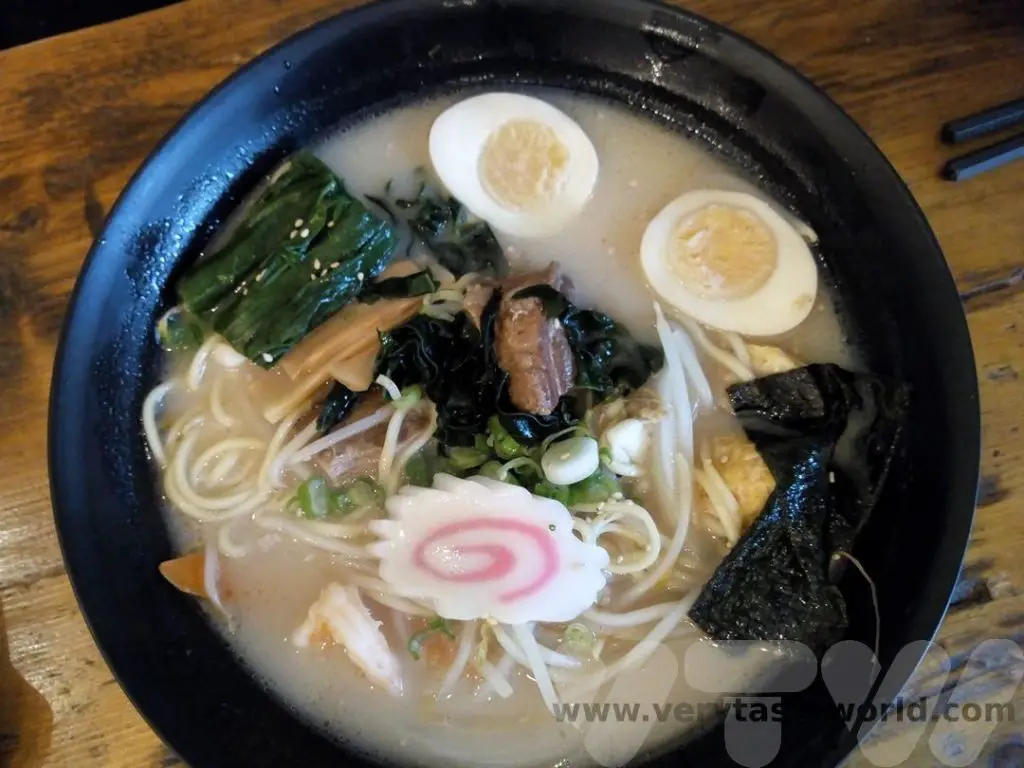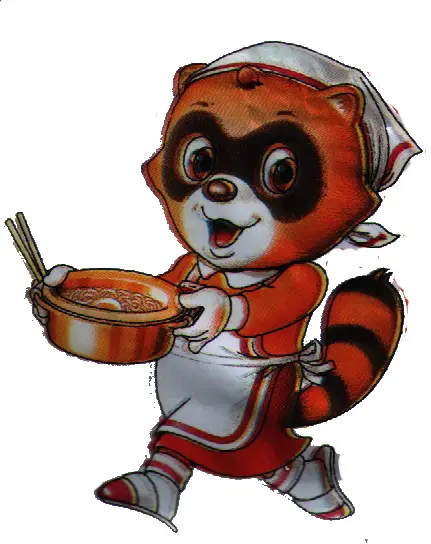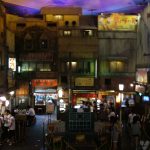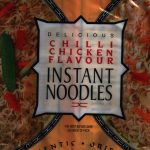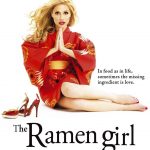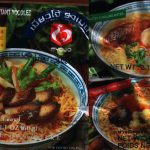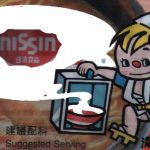An Essential 2 day Gyeongju Itinerary
Gyeongju in South Korea is often described as a ‘museum without walls’ which may sound like a cliché but it couldn’t be more appropriate. It is a city with an enormously rich history that has so many fascinating sites to explore. We spent some time in Gyeongju on our recent trip to South Korea. We could easily have spent longer. Here’s our essential 2 day Gyeongju itinerary which will ensure that you see the highlights of this amazing city and leave you with a desire to see much more.
Please note that this post contains affiliate links. If you click through and decide to make a purchase we will make a small commission, at no extra cost to you, which will help towards the costs of running this site.
History of Gyeongju
Gyeongju has a long history that dates back over two thousand years. It was established in 57 BCE as Saro-guk when a number of villages in the area were united by leader Park Hyeokgose, the founding monarch of the Silla, one of the Three Kingdoms of Korea.
The city expanded over the years and eventually became the capital of the region, home to the court of the Silla people, who were the wealthy elite of the kingdom. They ruled for nearly 1000 years. Silla was known as the region of gold, and many gold objects have been found, reflecting the status of the kings.
By 668 CE the Silla had established a legal code and had adopted Buddhism to consolidate its political foundations. Gyeongju had a thriving society, prosperity was at its peak and it is estimated that the city’s population may have reached as many as one million people.
Sadly the city’s fortunes declined in later years during the Goryeo dynasty and then the Joseon Dynasty when the country’s administration moved further north. The city also suffered losses during the Mongol invasion in the 13th century and during the Imjin War with the Japanese (1592–1598). But a wealth of remarkable historic buildings and architectural treasures remain.
Naturally, the city has received UNESCO world heritage status. In UNESCO’s words: Gyeongju Historic Areas contain a remarkable concentration of outstanding examples of Korean Buddhist art, in the form of sculptures, reliefs, pagodas, and the remains of temples and palaces from the flowering culture of Silla dynasty, in particular between the 7th and 10th century.
How To Get To Gyeongju
The city is located in south-eastern Korea and can be reached in around 2.5 hours from Seoul and 1 hour from Busan using the fast and efficient KTX train services. However, you don’t arrive in the city centre, but at the new station Singyeongju which is located around 10km away. We have a post about how to travel to Gyeongju.
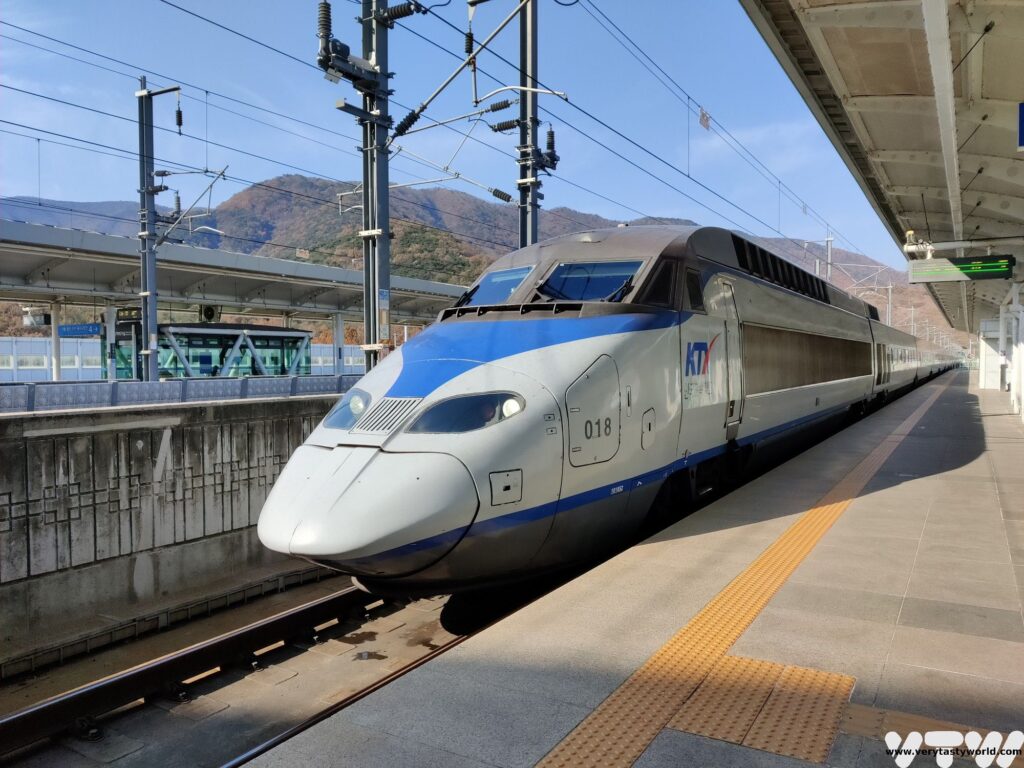
Although there are a vast number of historic sites to visit in the region, many of Gyeongju’s attractions are within walking distance of the city centre.
Most sites are free to enter but some have a small charge, usually around 2000 Won (about $2). Many sites can be visited throughout the day and into the evening but some have opening hours, which vary from location to location. The itinerary has a fair amount of walking, although you could use buses 10 and 11 which run on a loop and stop by some of the main attractions. Taxis are also available.
There are tourist information booths at many of the main sites. You can pick up leaflets and brochures which not only have handy maps and information about the site, but you can also collect stamps at various locations. Look out for the huts with the inkpad and stamp. Gotta collect ‘em all!
We got chatting to many of the people who were manning the booths – all had great English – and they were very keen to give us information about the site and advise on other historic areas to visit.
2 day Gyeongju Itinerary: Day 1
The first day’s attractions are within walking distance of the city centre, although you will certainly get the steps in. The main sites lie to the south of the city centre.

Day 1 Morning
The Daereunwong Tomb Complex
This complex is the site of ancient Silla burial mounds. They are tumuli that form a distinctive part of the landscape. They are considered sacred and should be treated with respect. This complex is free to enter and you can wander around. It contains the tombs of some 50 Silla Kings, including King Michu.
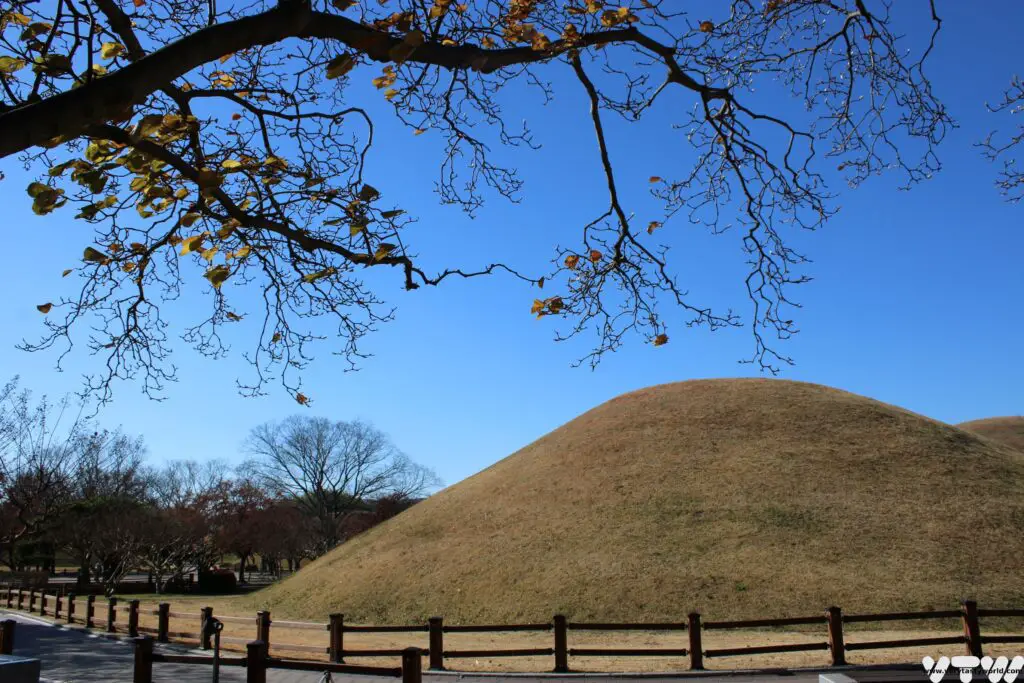
You can enter the Cheonmachong Tomb (a small fee applies). It is known as ancient tomb 155 and was excavated in 1973. Inside was a body wearing a gold crown which had been buried with a variety of artefacts.
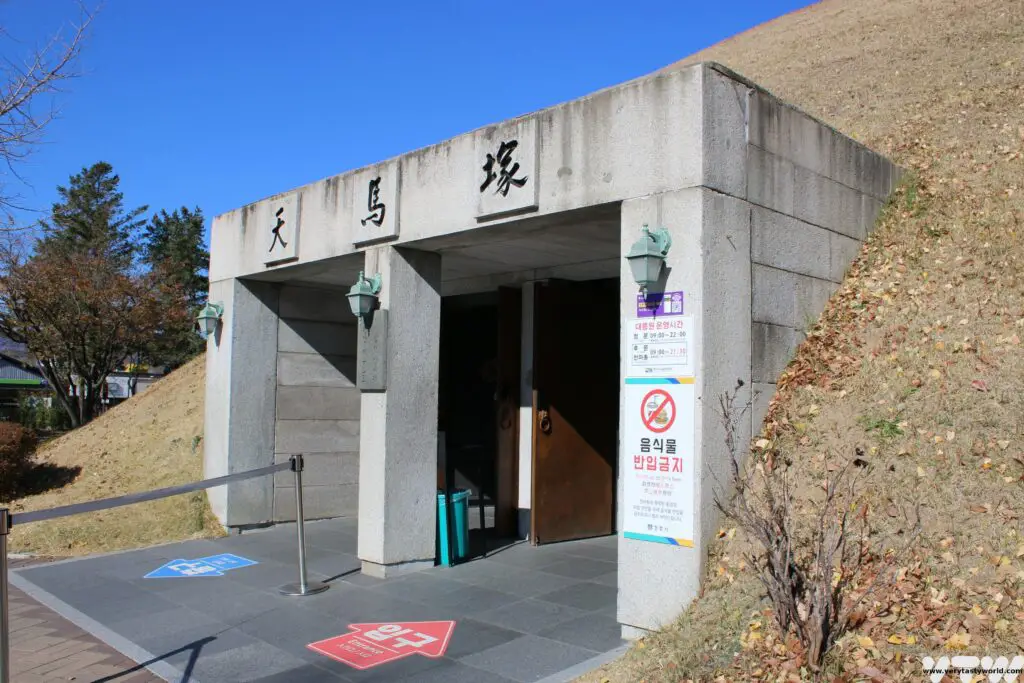
Many Silla artefacts are displayed inside the tomb and you can marvel at the craftsmanship of the intricate and delicate goldsmiths. The Silla were clearly a wealthy people and the crowns and jewels they wore reflected their status.
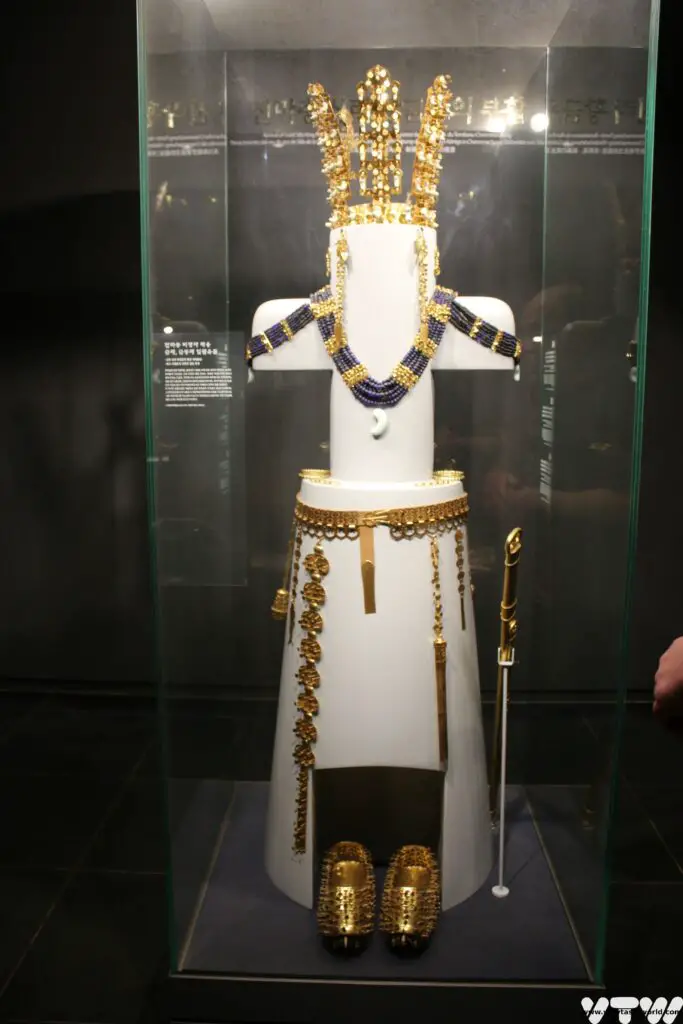
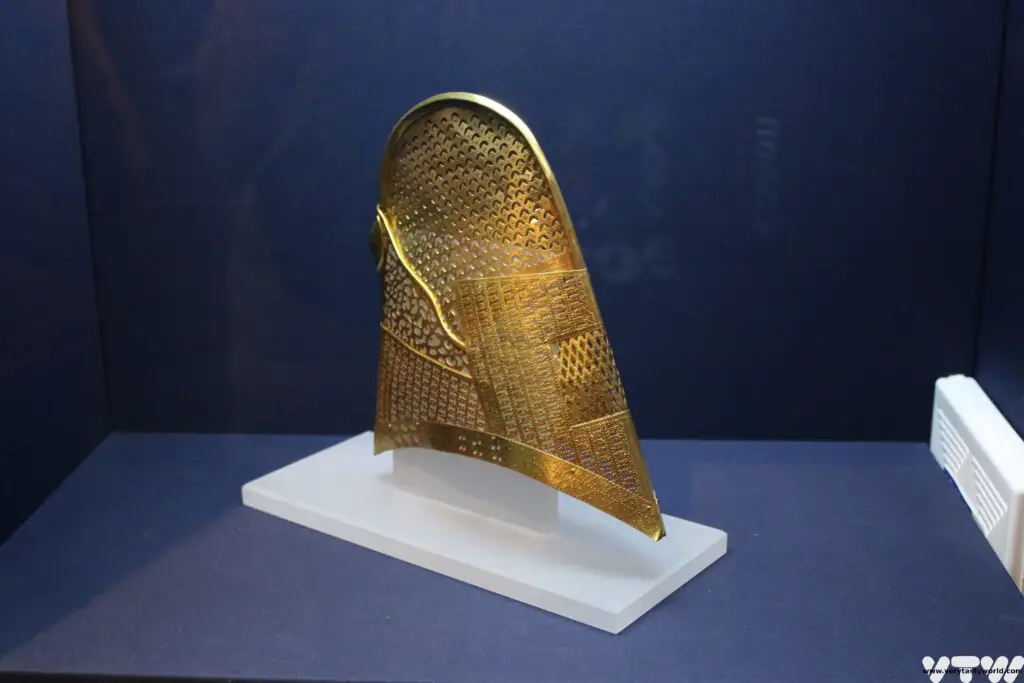
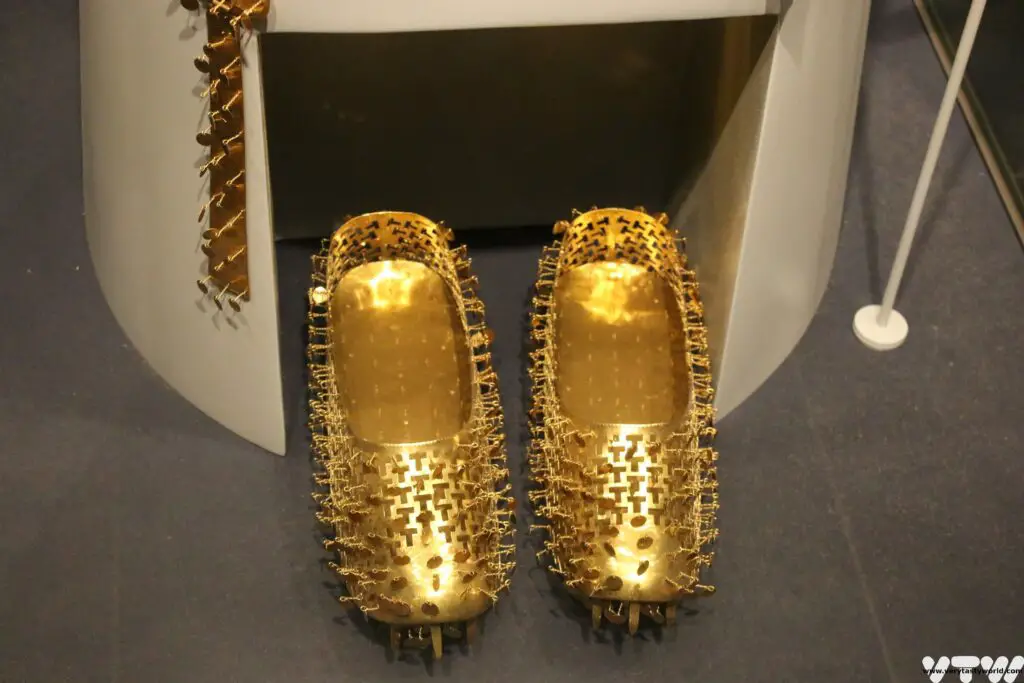
Exit this site to the south to visit the Gyeongju Eastern Historic Site
If you are feeling peckish, there are a number of restaurants in this area, located between the Daereunwong Tomb Complex and the Eastern site, where you can enjoy a snack or a light meal.
Gyeongju Eastern Historic Site
There are a vast number of fascinating sites to explore in this area, most of them are eminently walkable.
Cheomseongdae
This is the oldest surviving observatory in Asia (possibly even the world), constructed by the Silla in the 7th century. It is nearly 10 metres high and would have been used for astronomical observations. The square window halfway up the tower was also the entrance. The tower is comprised of 365 stones to represent each day of the year. It is thought that the number of the stones, and their placement, in the tower may represent astronomical figures but no one really knows what these might be so this theory isn’t certain.
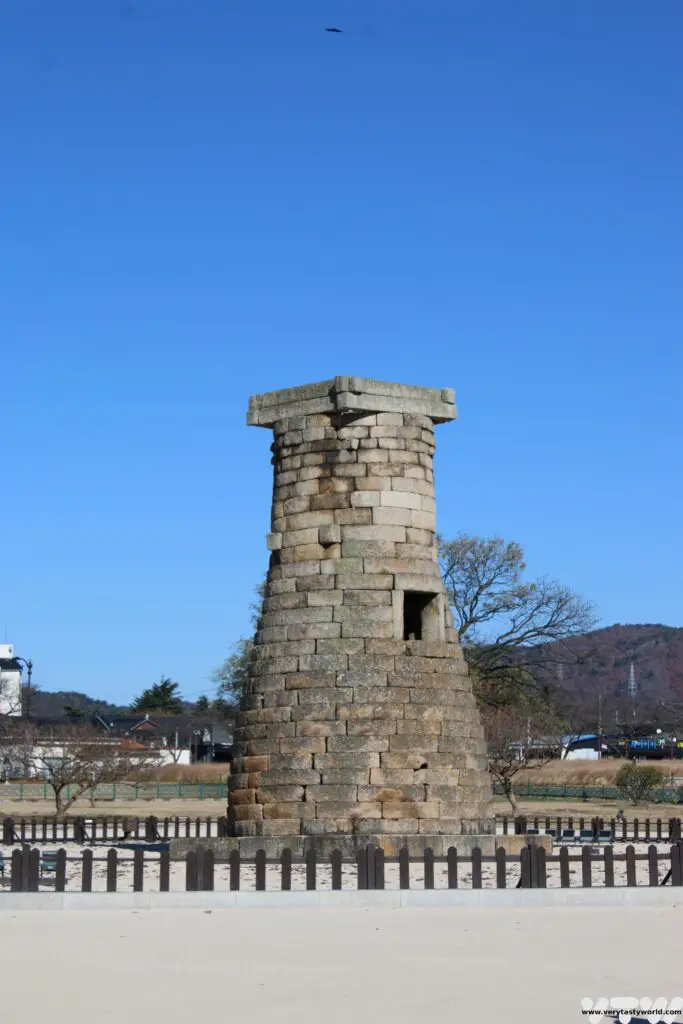
As you follow the main track, take a right turn just past Cheomseongdae to walk through a pleasant path to reach the…
Gyeongju Gyochon Traditional Village
This small village has a number of houses built in traditional style, some of which are residential properties but some are accessible to enter. Many of these date from the Joseon dynasty (1392 – 1897) rather than Silla. Of particular interest is the Confucian school which is still in use to provide education of Confucian practice.
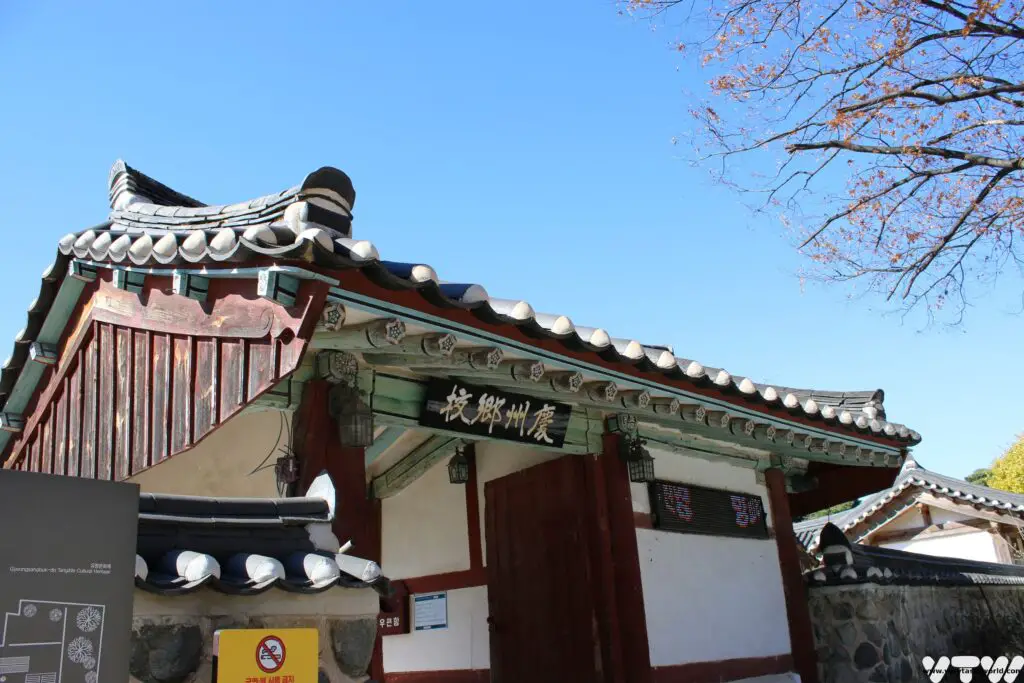
The Historic House of Rich Man Choe is a house dating back to approximately 1700, although is it is a reconstruction. The Choe family were rich through 12 generations and this house is representative of the buildings of the nobility of the Joseon Dynasty. Nearby the traditional village is the Jaemaejeoung well, situated by General Kim Yusin’s house. Next to the well is a tombstone dedicated to King Gojong (a Joseon king).
There are a number of cafes and restaurants here if you fancy having a bit of a rest from sightseeing. This is a good place to enjoy a spot of lunch.
Day 1 Afternoon
Woljeong Bridge
Moving further south from the traditional village, you will arrive at the river and the spectacularly beautiful Woljeong Bridge. This is a reconstruction of a Silla bridge that was originally built during the reign of the 35th Silla King, King Gyeongdeok.
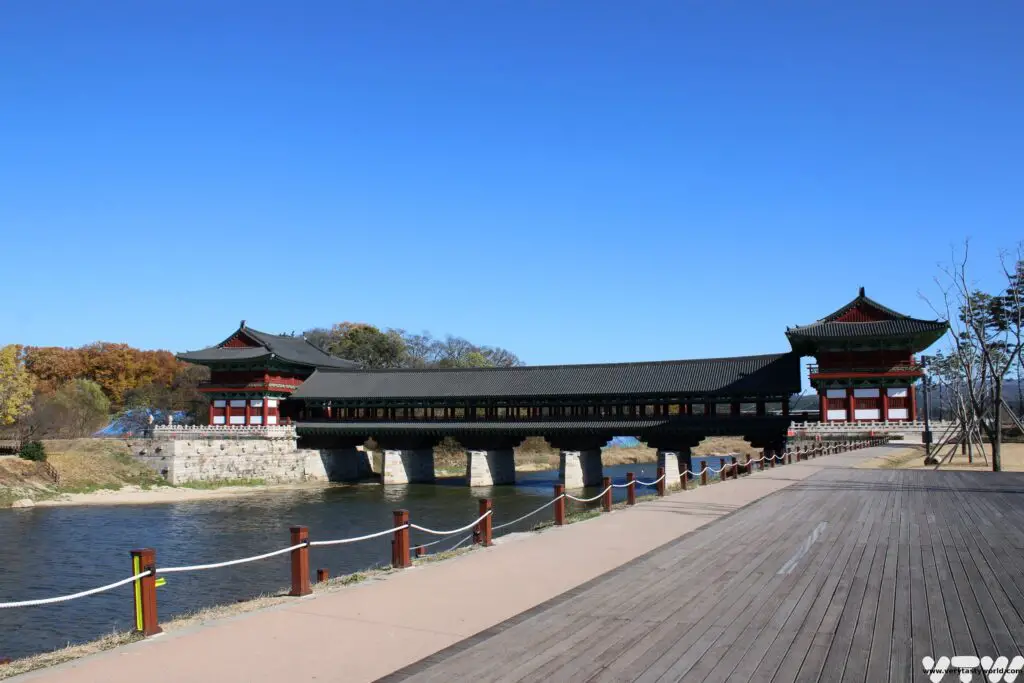
The bridge is covered all the way across, its pillars and roof highly decorated in red, green and blue.
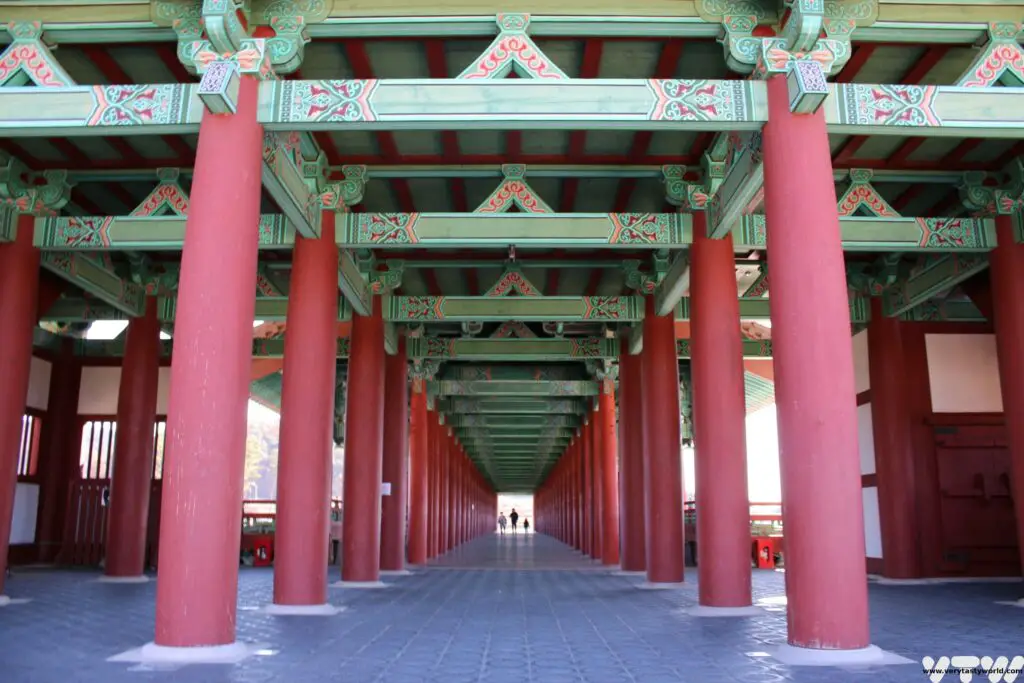
You can also climb the steep steps into the bridge towers to view exhibitions which include a number of historic artefacts.
Oleung Five Tombs Site
Beyond the bridge you can turn right and walk along the riverside until you arrive at a walled complex. Follow the wall along the river and turn left along the main road and follow the wall to reach the entrance. This site has a small fee to enter. It has four earthen mounds and a round grave. They are the tombs of a single king, King Park Hyeokgeose, who founded the Silla Dynasty.
He apparently ruled for 62 years and after he died, according to a legend, his body was ripped into five pieces and fell back to earth from heaven. His people tried to bury him in a single tomb but a giant snake prevented them from doing this, so five tombs were constructed. The tombs have not been excavated.
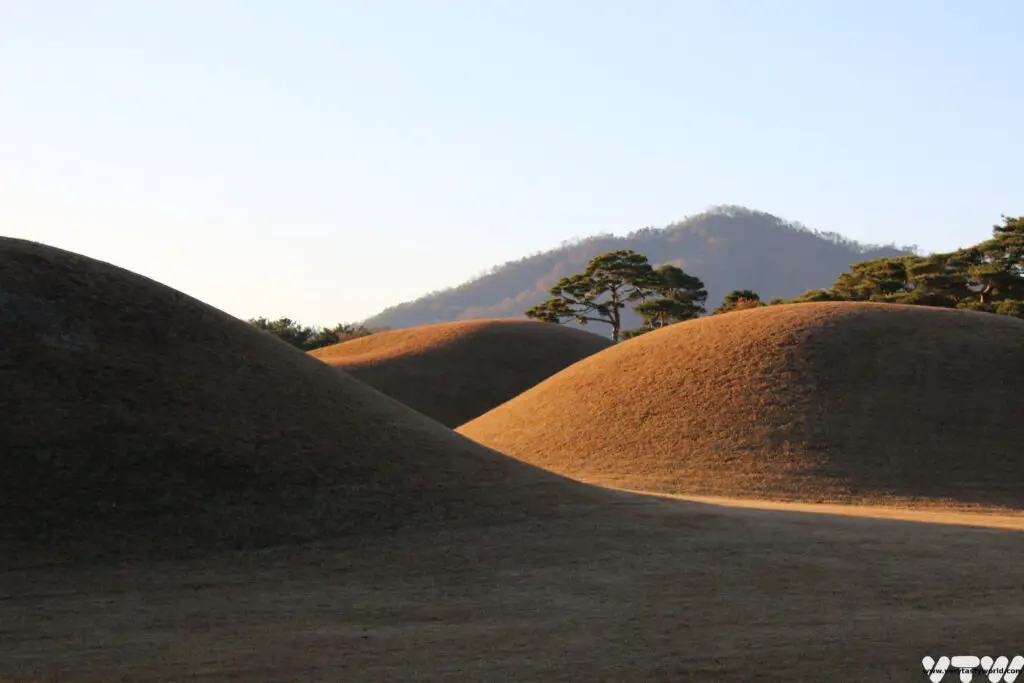
A lovely foodie moment happened after had left the site and were making our way back to the bridge. We were beckoned by a man who wanted us to meet his family and show us how they made kimchi. We were invited into his courtyard and he showed us a bathtub of cabbages which had been halved and brined. He, his sister and 84 year old mother were washing the cabbages. The following day each cabbage leaf would be smothered in a deliciously spicy paste and fermented. It was such an honour to be invited to this delightful family’s home and to see the kimchi making process.
Wolseong Palace
You can walk back along the river, cross the bridge and turn right at the traditional village to go across the park and see the remains of Wolseong. This was a Silla palace that was originally constructed in the 2nd century. No buildings can be seen, save a small ice-house, but the moat has recently been restored.
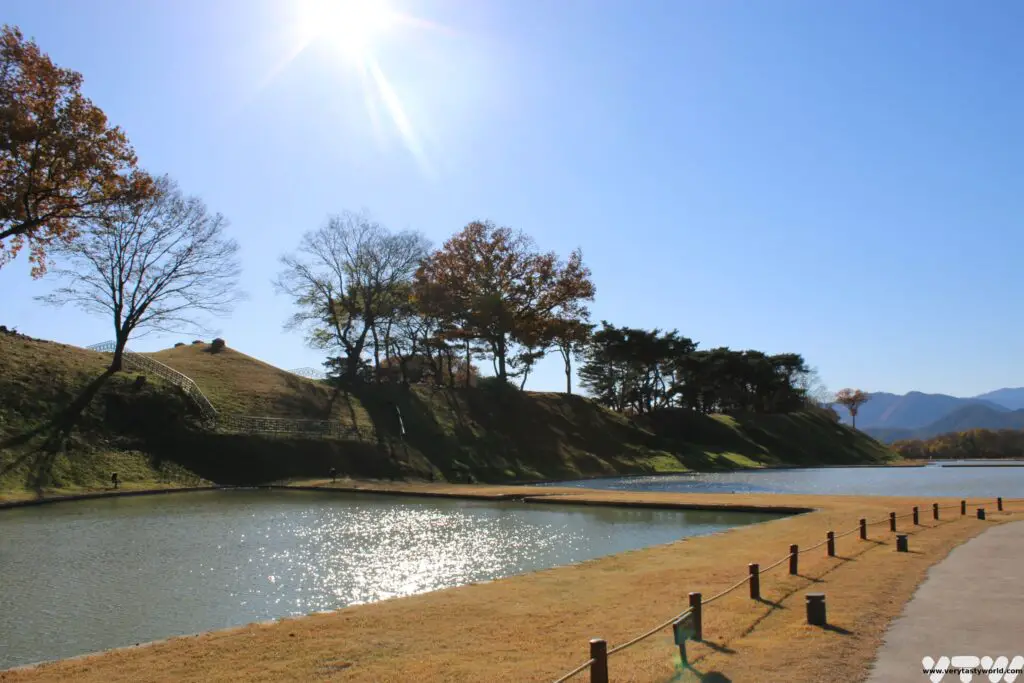
Donggung Palace and Wolji Pond
Follow the moat around and bear right. After exiting the park turn right and walk along the road, then cross to the Donggung Palace and Wolji Pond. This was a palace that was used by the Silla crown prince. The site has a beautiful pond (Wolji means “pond that reflects the moon”) which was constructed in 674 CE and is set in a lovely garden.
There is a small fee to enter the grounds. It’s possible to walk round the lovely lake to view its three islands. There are also some reconstructed lakeside buildings. It’s easy to imagine this as a place of leisure for the crown prince. It was extremely pretty, even in winter.
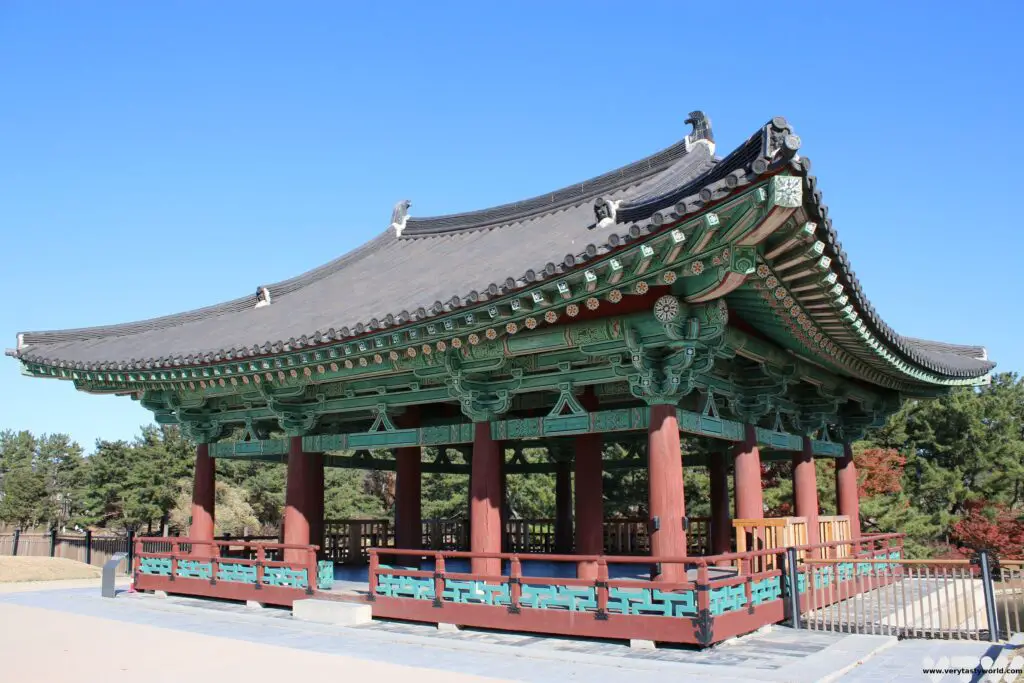
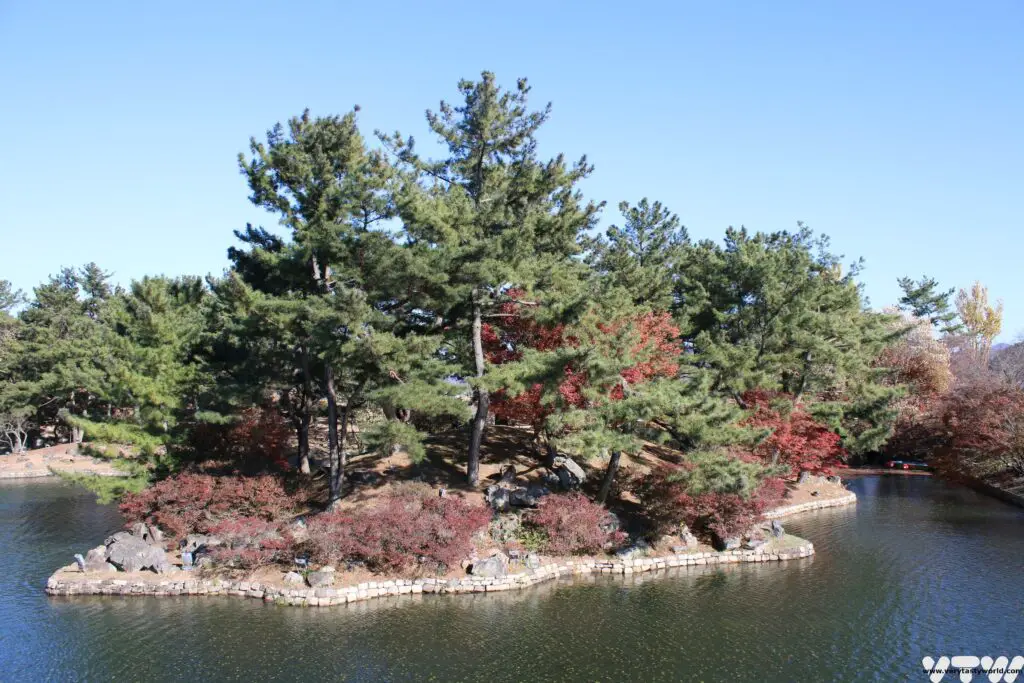
2 day Gyeongju Itinerary: Day 2
On the second day we suggest exploring some of the important historic sights outside the city.
Day 2 Morning – Bulguk-sa and the SeokGuram Grotto
You can catch a bus to visit the UNESCO sites of Bulguk-sa and the SeokGuram Grotto.
Bus numbers 10 and 11 go to Bulguk-sa (number 11 from the city centre is the quickest route) on a loop route.
Bulguk-sa is a historic temple complex set in a beautiful garden and is a triumph of Silla architecture. It was originally built between 751 and 774 and served as the centre for Silla Buddhism and was a place for prayer to protect the country from foreign invaders.
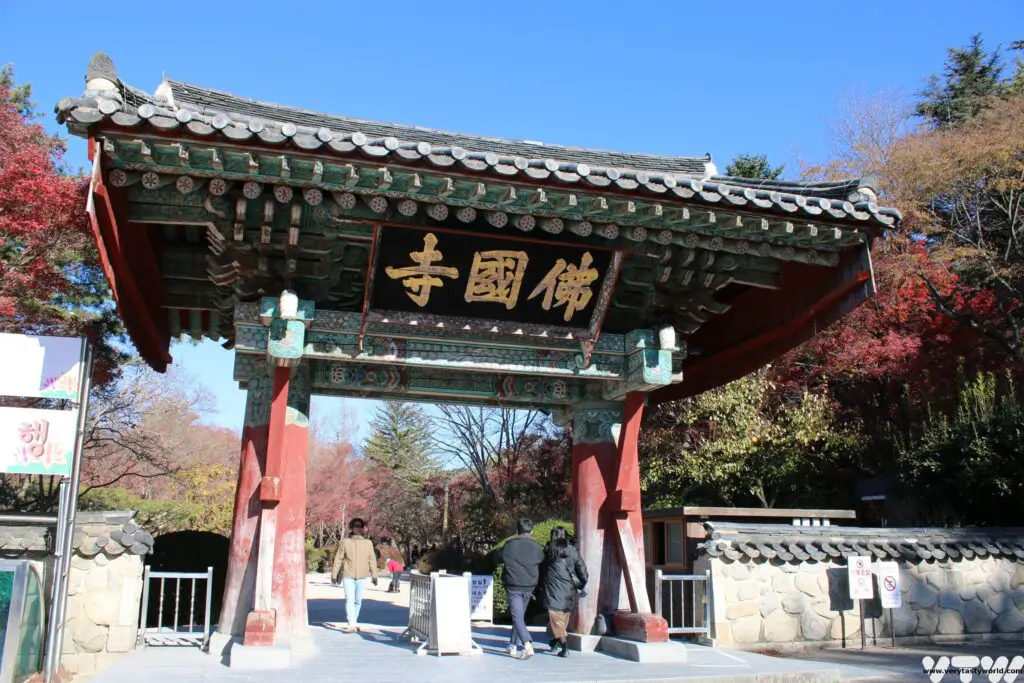
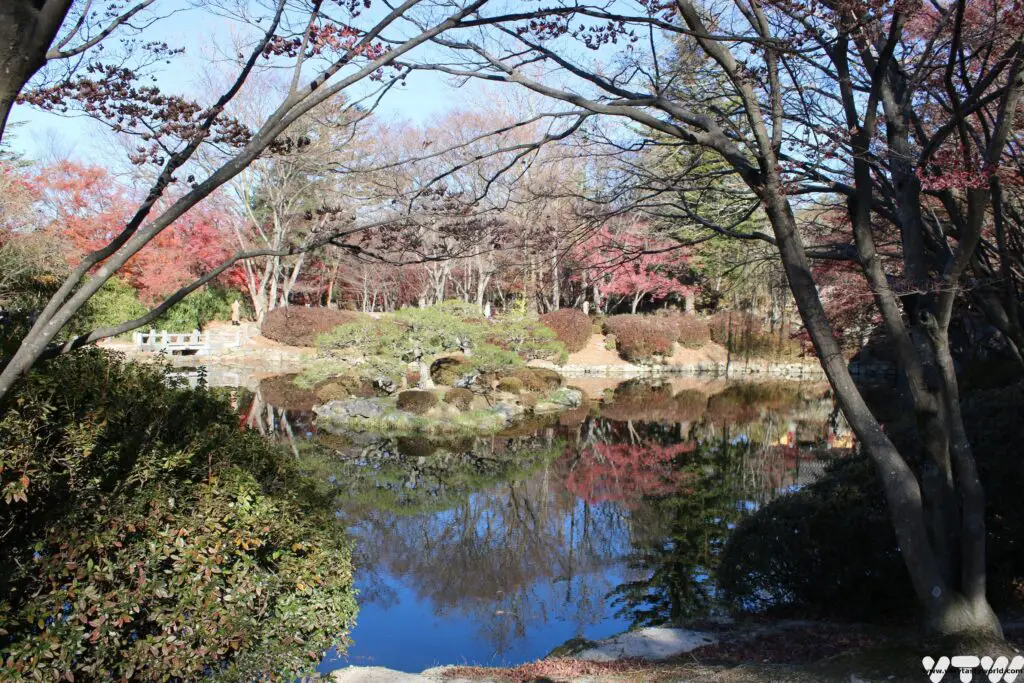
Unfortunately the buildings were destroyed by Japanese invaders in 1593 and have been rebuilt. The main Buddha hall was rebuilt in 1765.
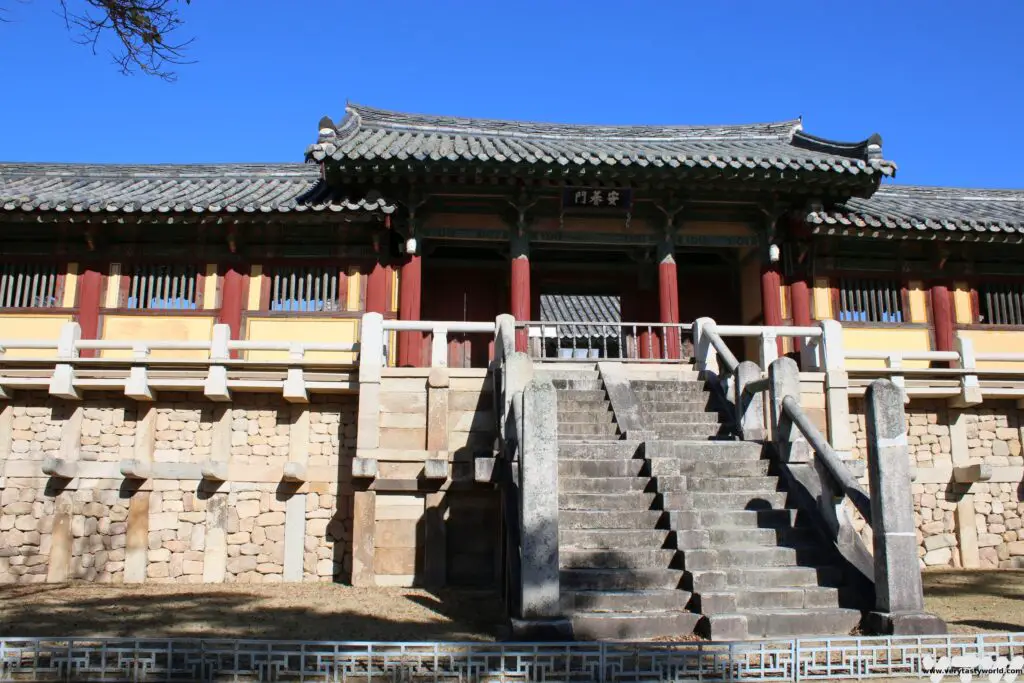
In front of the hall are two pagodas which survived the destruction are considered to be national treasures.
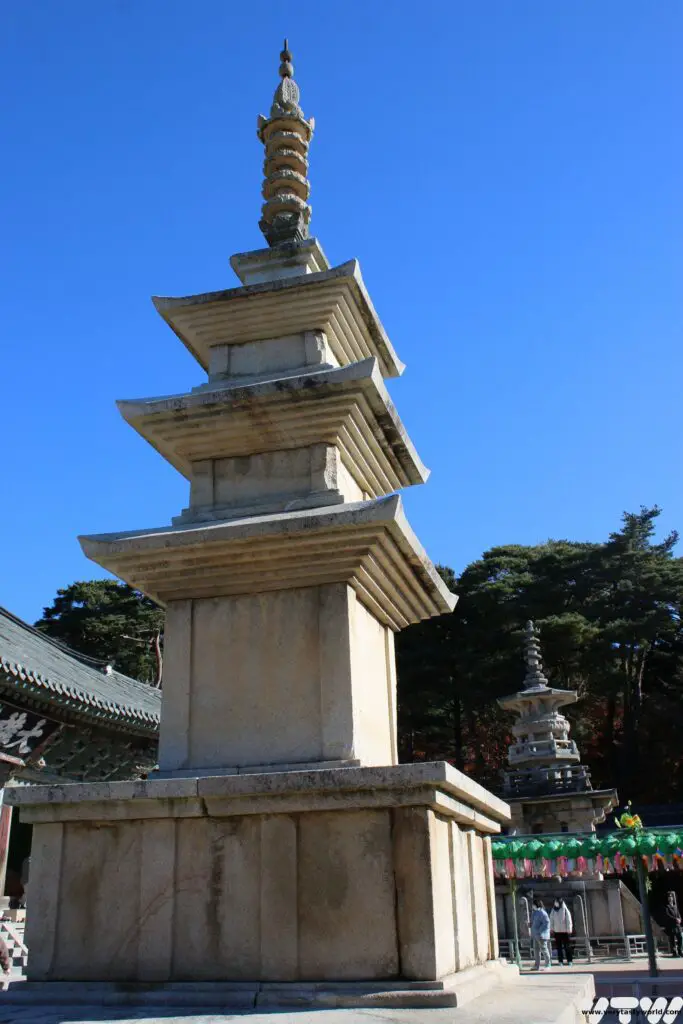
Dabotap , the Many Treasures Pagoda, is a typical Silla construction. The more ornate pagoda is Seokgatap, the Sakyamuni Pagoda, and it’s more reflective of the architecture of the neighbouring Baekje kingdom. In 1966 archaeologists discovered a copy of a sutra inside the pagoda which is an absolute treasure, considered to be amongst the world’s oldest woodblock printed books.
There are numerous other temple buildings and gardens to explore.
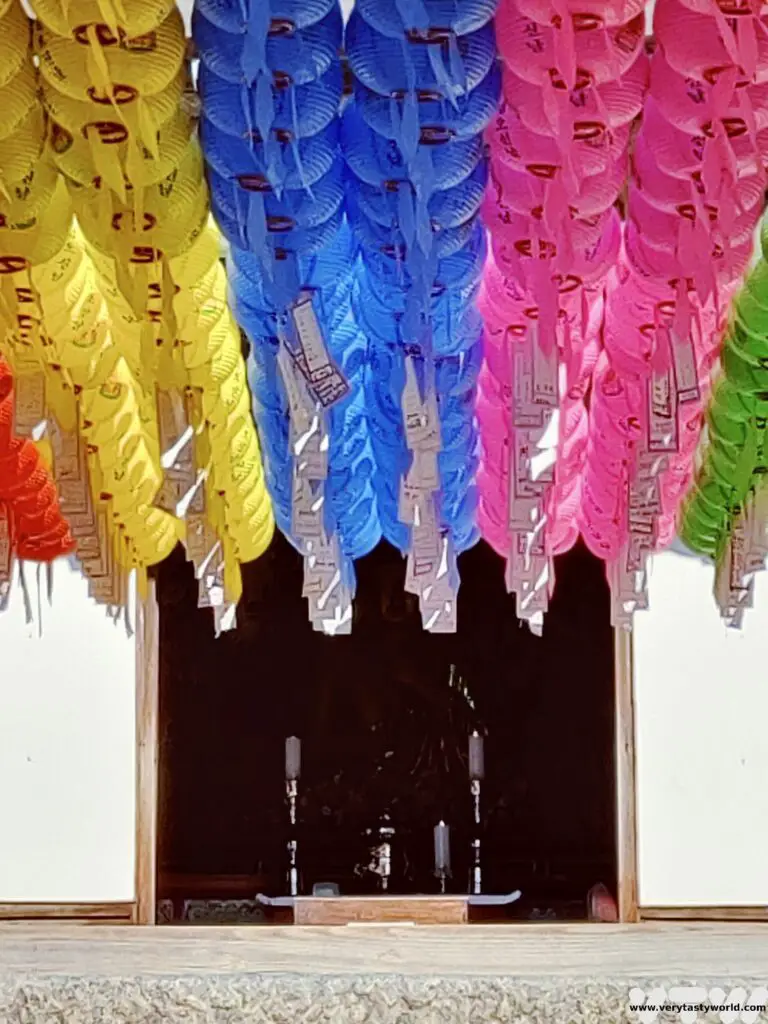
Bus number 12 will take you to the SeokGuram Grotto. If you’re feeling energetic, you can walk up the hill – it’s 2.2km to reach the grotto – but we’d recommend taking the bus as the road doesn’t have a great path for pedestrians. The bus stop to the grotto is at the bottom of the hill on the main road opposite the tourist information centre in the Bulguk-sa lower car park. The tourist centre will be able to give you a bus timetable.
The SeokGuram Grotto is another world heritage site. This is a cave temple, built in 751CE by the Silla people, which contains a Buddha. It is 3.23m tall, sculpted in granite and is considered to be one of the world’s most exquisite heritage carvings. The Silla cleverly designed the cave on a hillside where a stream runs underneath, perfectly regulating the humidity within the cave.
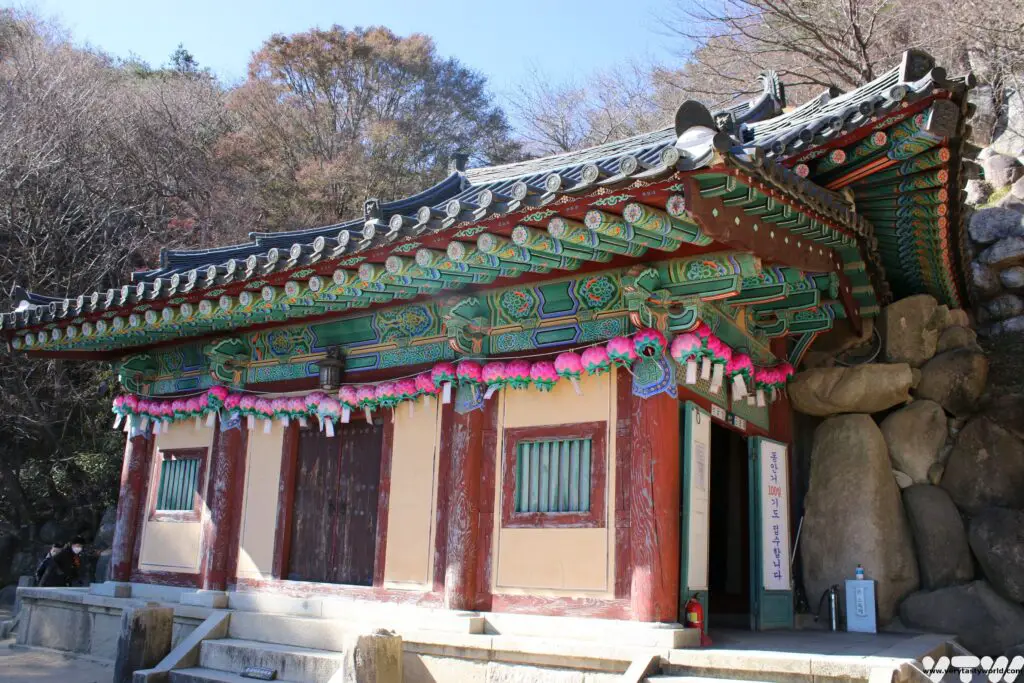
Visitors can walk into the cave and view the Buddha which is located behind a protective screen. There are deities that guard the main Buddha, two on each side. Photos are not allowed.
It is a short walk of around 1km along a pleasant, forested path to the SeokGuram Grotto from the entrance. At the very top of the stairs by the car park there is a traditional bell, which you can ring for a small fee of 1000Won. The money goes to charity.
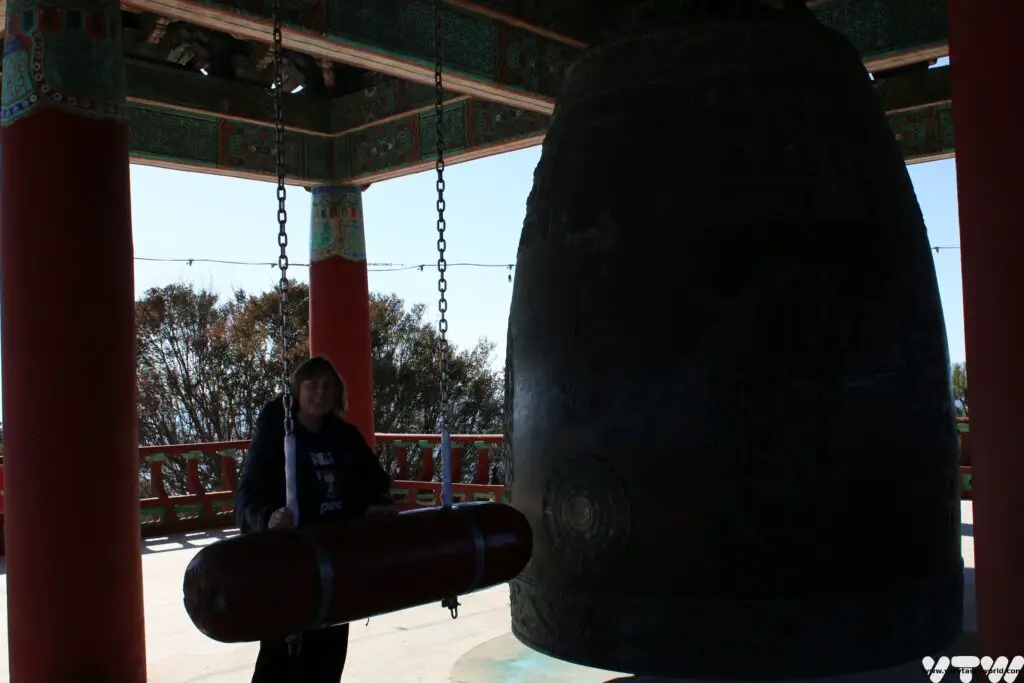
Day 2 Afternoon Choices
There are choices for how to spend the afternoon.
On the way back, the buses pass by the Lake Bomun resort area. If you looking for more modern activities Gyeongju has a popular theme park which is a major draw for younger people in particular. This area also has a K-Pop museum and a museum of contemporary art. You will pass by the park on the no 10 or 11 buses and they both stop there.
Alternatively you could spend the afternoon browsing the Gyeongju Museum (open 10m-6pm, free entry) which has extensive permanent and temporary exhibitions about the Silla.
The history gallery and Silla art gallery are notable highlights, both of which exhibit precious artefacts.
Evening at the Gyeongju Eastern Historic Site
We recommend revisiting the Gyeongju Eastern Historic Site in the early evening. It’s a place where locals and visitors spend time relaxing in the park. Kite-flying is a popular activity.
Many of the historic sites are lit up after nightfall and it is especially worth walking back to Cheomseongdae and the Woljeong Bridge.
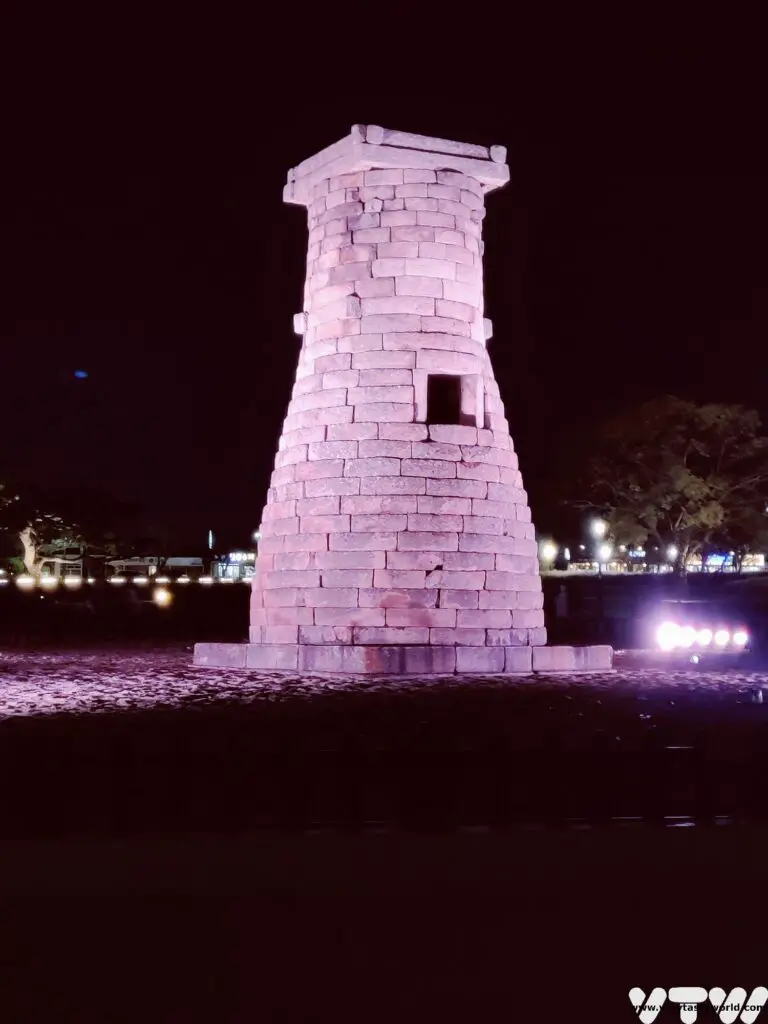
They are both impressive in the daytime but spectacular at night.
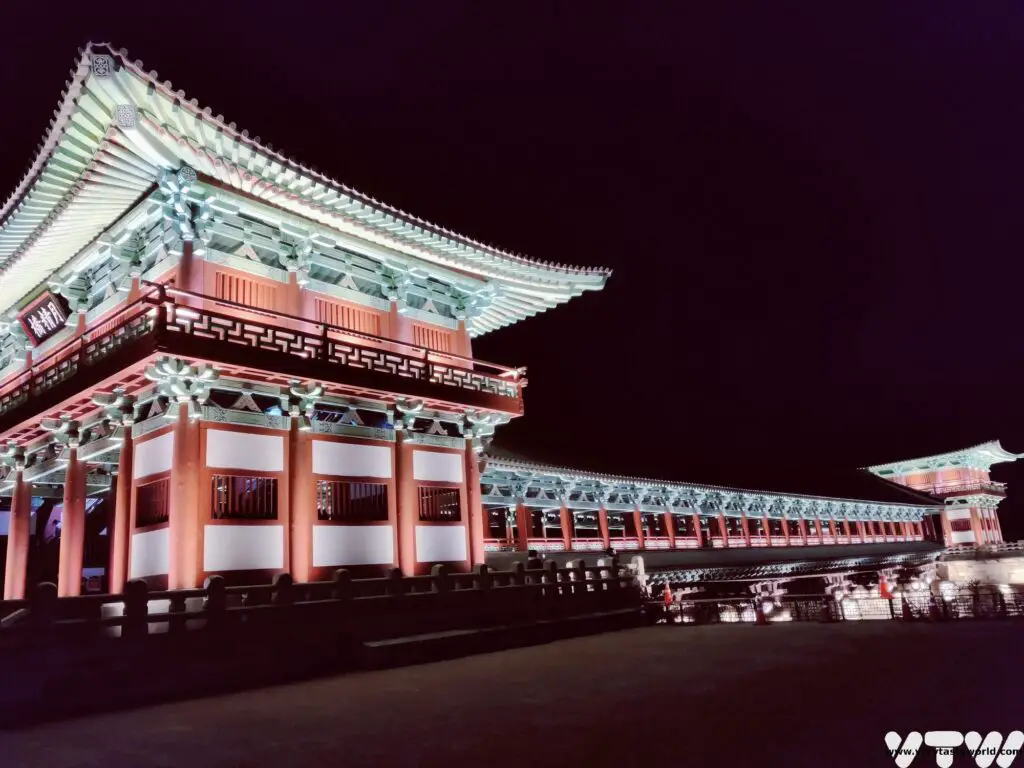
Gyeongju for Foodies
We ate very well all over Korea and the cuisine in Gyeongju was no exception. There are a plethora of restaurants in the city and around. Prices are very reasonable – most of the meals we enjoyed were around 10,000 Won (~$8) or less per person. There were a couple of excellent restaurants in the city centre or close to the Eastern Historic Site.
Sukyoung sikdang gyeongju on Gyerim-ro, opposite the The Daereunwong Tomb Complex, offered a home-cooked bibimbap (rice bowl) with lots of banchan side dishes and broth. This is a great option for vegetarians because all the dishes were vegetable based except for an additional order of fish (which we did order and enjoy). The sides comprised omelette, mushroom, water kimchi, radish kimchi, blanched vegetables, tofu. Barley tea was also served because it was a cold day. The proprietor also made his own makgeolli – a kind of rice wine.
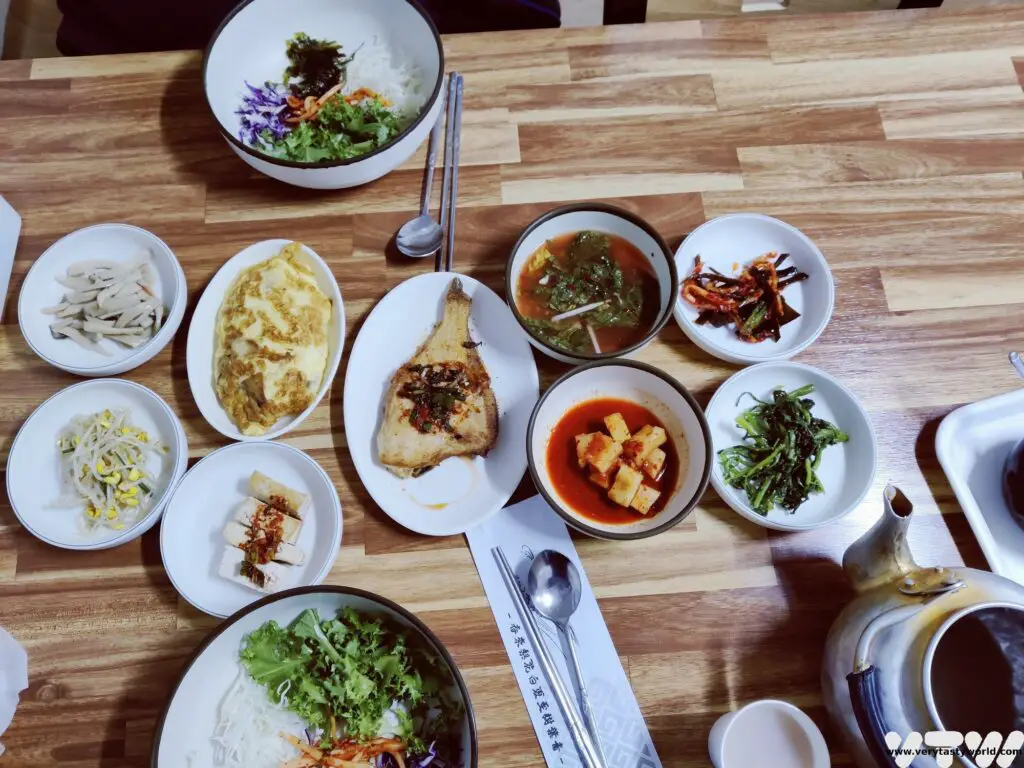
We stopped into 한식집 숟가락 젓가락 located on Taejeong-ro791 Becon-gil because we saw its sign with a huge number of dishes. This wonderful little restaurant offered a feast that was an absolute bargain. You choose a stew and then get rice, 11 side dishes and barley tea. All for 8000 Won each (about $6). And it was utterly delicious.
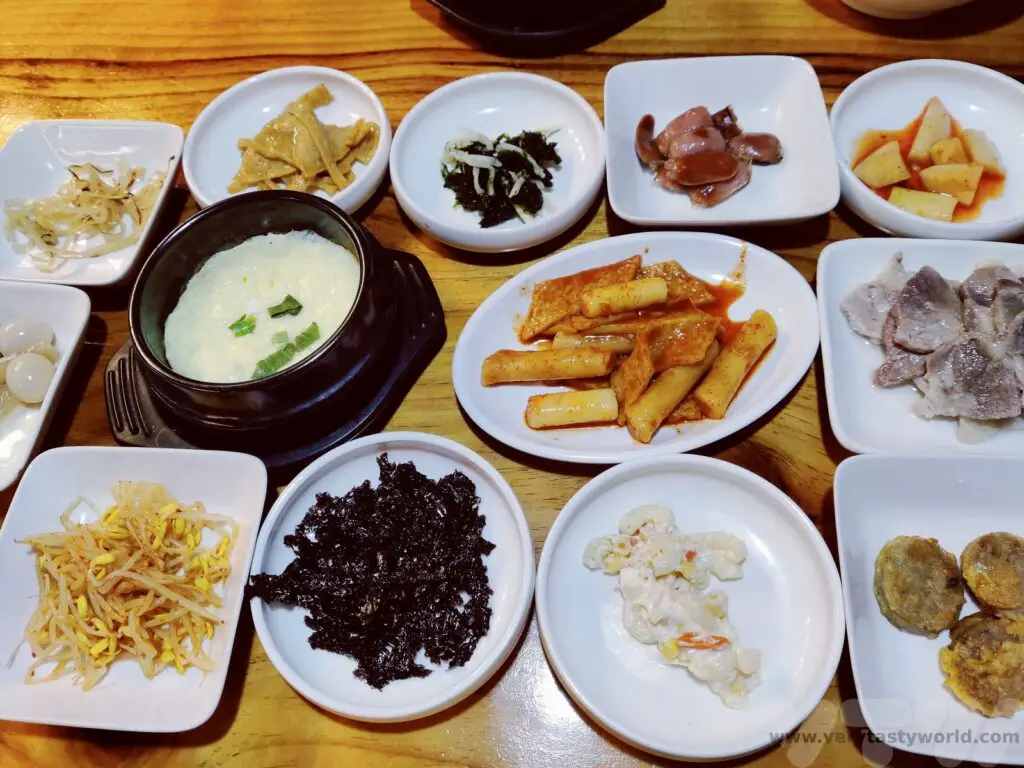
In town there is a dumpling restaurant 울타리없는만두 on Dongseoung-ro. The proprietor speaks good English and is delightful. We enjoyed two different types of dumpling. He steams them outside the shop – puts the dumplings in a basket, passes them through the window into the steamer, whereupon a rush of steam engulfs the side of the street and the dumplings cook in double quick time.
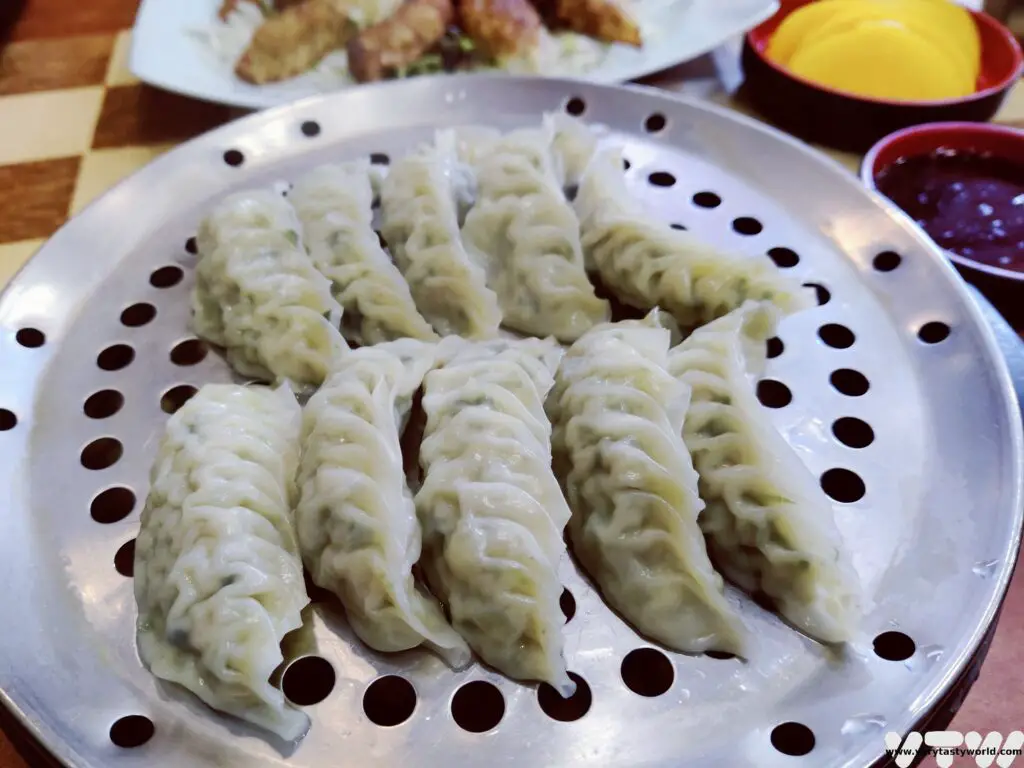
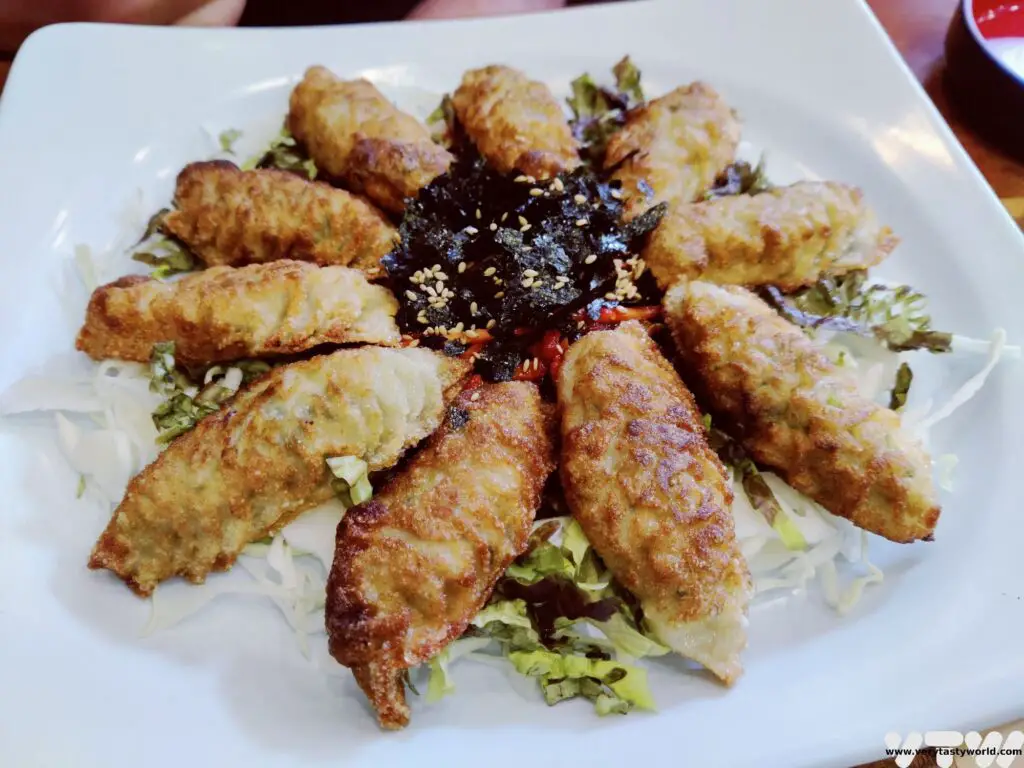
Seongdong Market, opposite the old railway station has a number of stalls if you are seeking street food. And we always advise seeking street food in South Korea – there are so many amazing dishes to try. The market also has an area with some restaurants that also serve a variety of banchan.
Gyeongju Specialty Food
Gyeongju has its own special bread known as hwangnam-ppan. We found it quite difficult to buy in individual portions as it is usually beautifully packaged in presentation boxes. (We were backpacking and didn’t feel that if we were carrying a beautifully packaged presentation box it would survive the rest of the trip!) However, one bakery sold us two single packs. Hwangnam-ppan is a sweet bread, which tastes like a scotch pancake. It’s soft and spongy in texture. The filling is a smooth, sweet red bean paste.
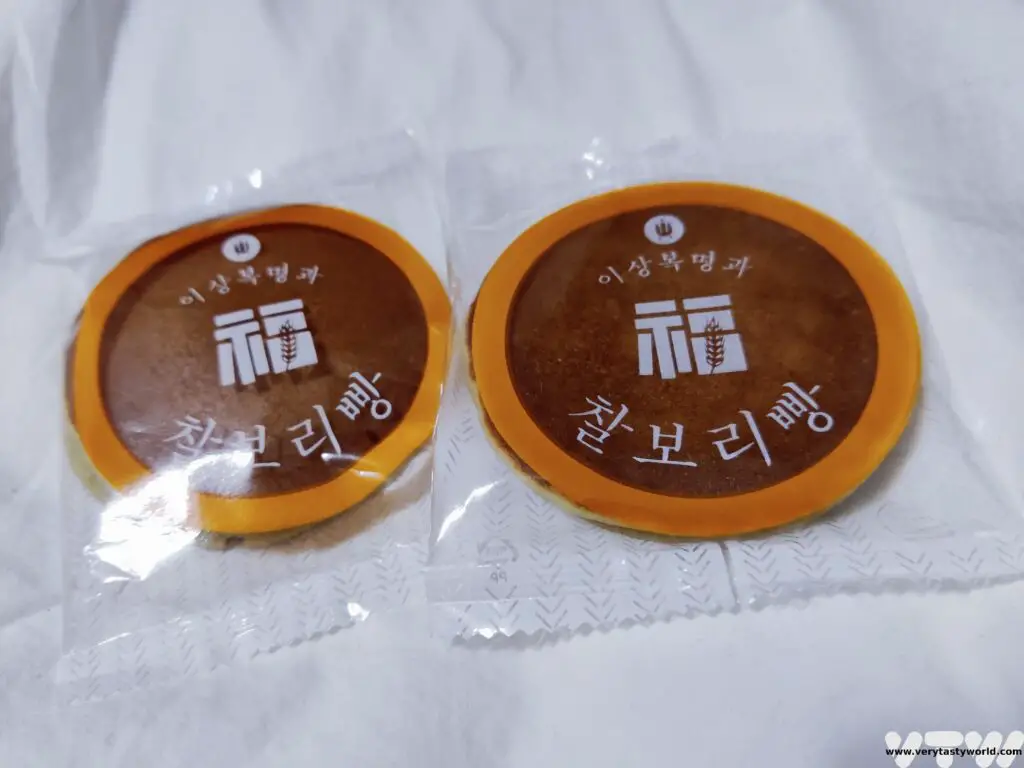
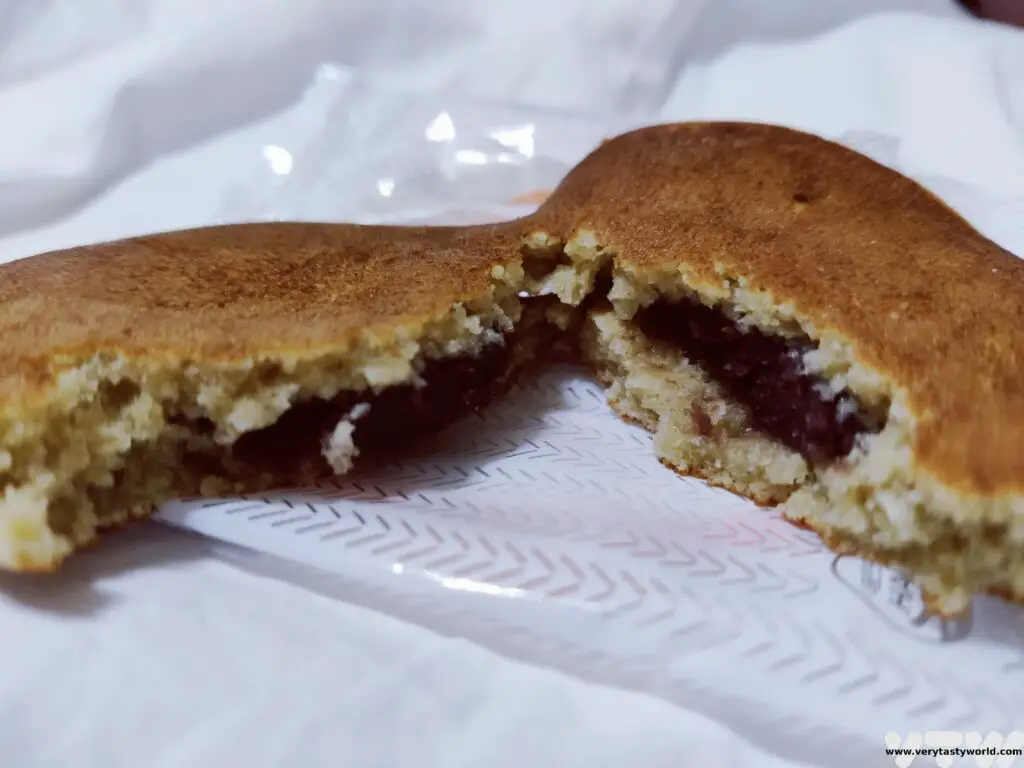
So, how did we do with collecting those site stamps? This is what we covered in two days.
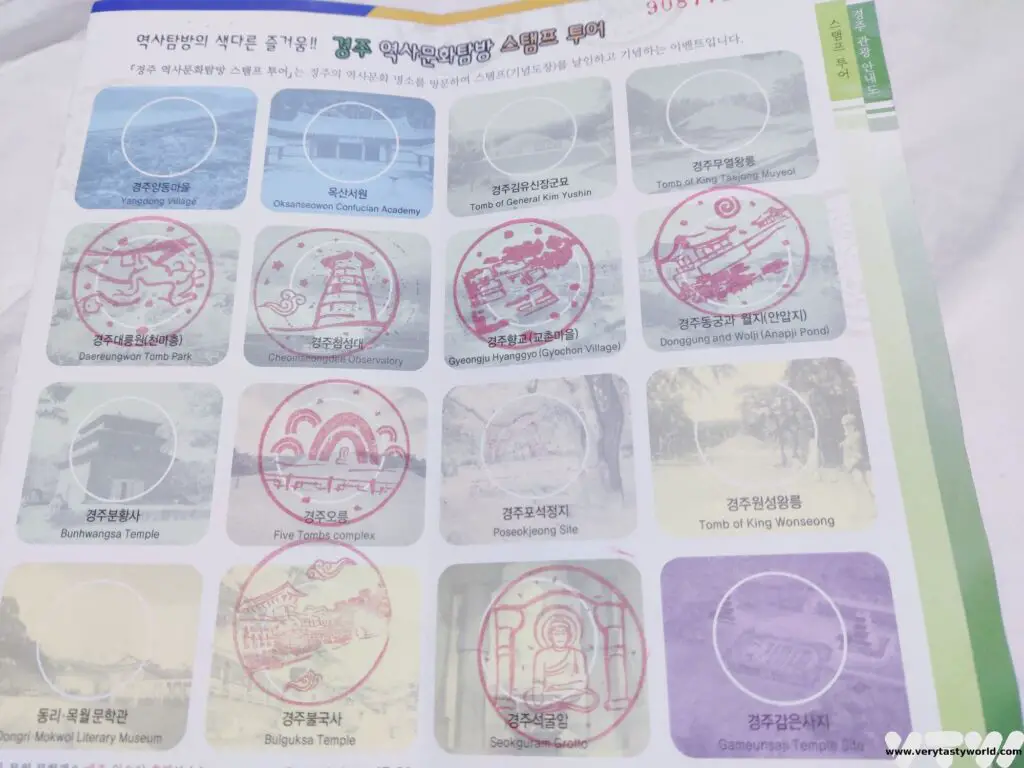
We can’t recommend Gyeongju highly enough. As you can see, our two day Gyeongju itinerary gave us a flavour of the highlights but there are many, many more places to see. We want to return and spend much more time exploring this remarkable region.
Related Posts You May Enjoy

- A One Day Hanoi Itinerary
- Mekong Meanderings
- A Chiang Rai Temple and A Country Retreat
- A Chiang Mai Tour in Northern Thailand
- Sunrise at Angkor Wat and Other Temples
- Mekong Delta River Cruise in Vietnam

Thanks so much for reading. We hope you enjoyed this article. If you’d like to keep up to date with new posts and recipes, please subscribe to our newsletter or follow us on social media – X, Facebook or Instagram. We always love hearing from you and would be delighted to read your thoughts about this article.
A Korean Table Setting – Eating Out in Korea
Korean cuisine is one of the finest in the world. It’s so good that UNESCO have acknowledged it. We have recently returned from a trip to this amazing country. We wanted to try as much local food as possible so ate at a variety of restaurants as well as spent time discovering the vibrant street food scene. Korean people are passionate about their cuisine. We also enjoyed learning about the importance of the Korean table setting. Here’s our guide to dining and etiquette in Korea.
Please note that this post contains affiliate links. If you click through and decide to make a purchase we will earn a small commission, at no extra cost to you, which will help towards the costs of running this site.
Our Korea trip took us to Seoul, Gyeongju, Busan, Daegu and back to Seoul, so we were able to taste dishes from all over the country. We found travelling through Korea to be very straightforward – the public transport system is excellent and very easy to use. You can buy a railcard which gives you access to the extensive rail network that will whiz you all over the country.
Dining was also easy in the main – many restaurants have multi-language menus or ordering systems. Everywhere we went, we discovered that the local people were delighted to help us learn about their delicious cuisine.
Dining Etiquette – The Korean Table Setting
The table setting is significant. Rice should be set to the left and soup to the right. (The other way round represents offerings to the dead.) The rough rule is that cold and/or dry foods are set to the left, and hot and/or wet foods to the right.
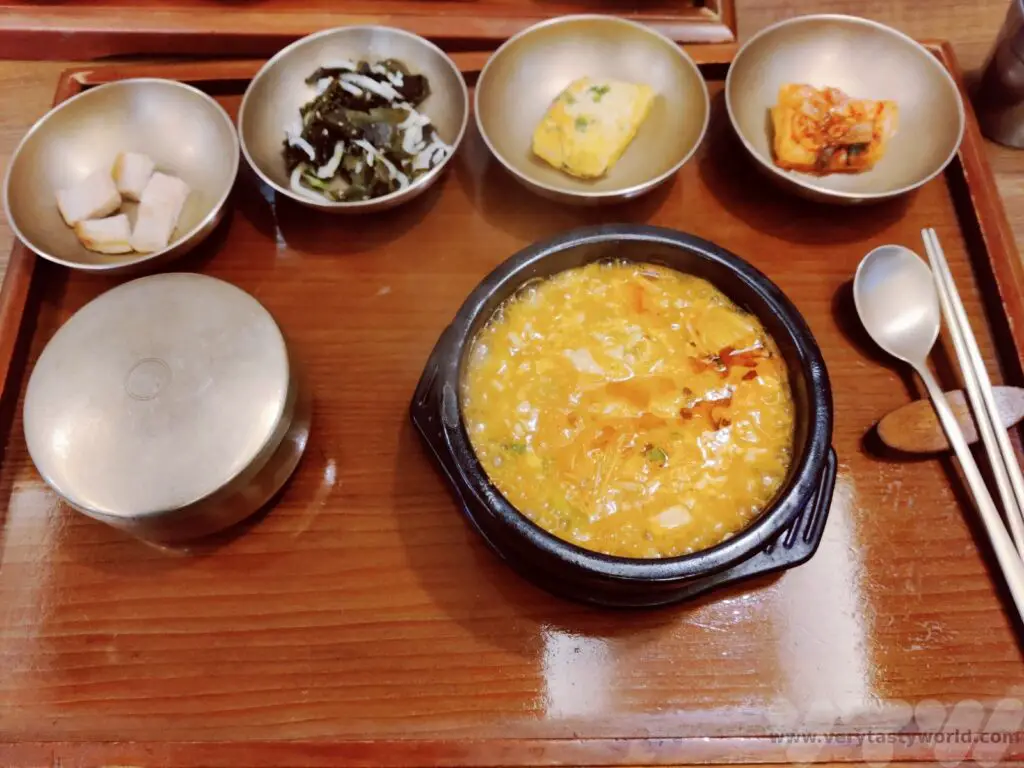
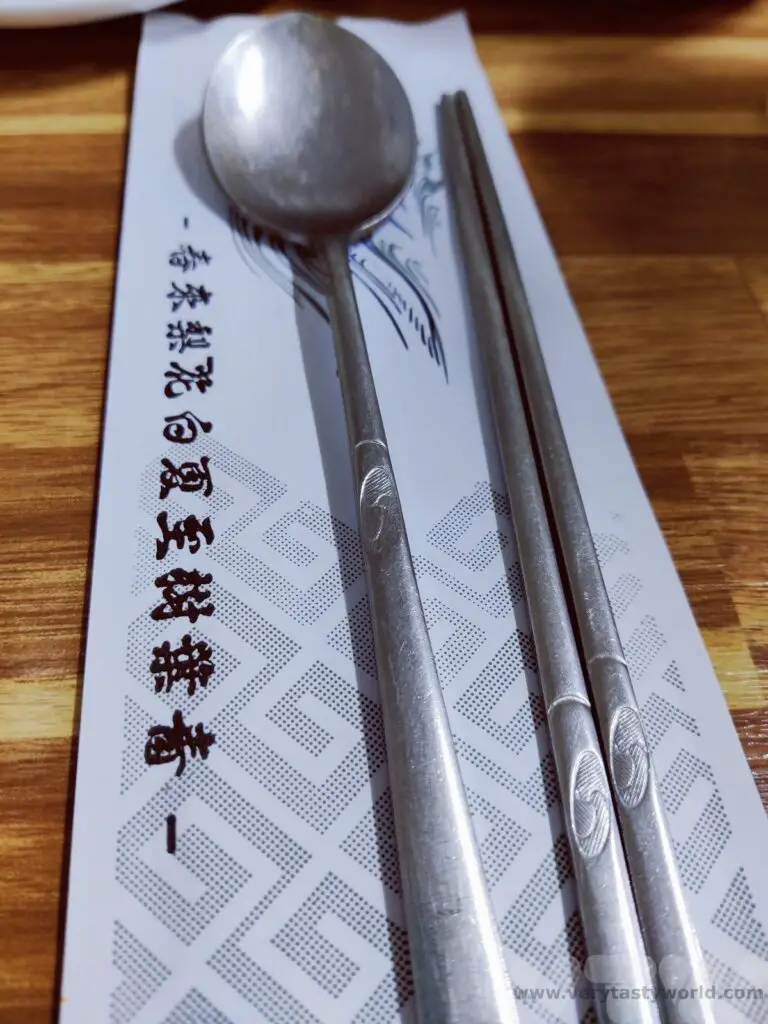
Koreans use chopsticks and a spoon to eat their food. Chopsticks are used to pick up specific items and the spoons used to scoop rice or eat soup.
Chopsticks in other Asian countries are usually made from wood but in Korea chopsticks are metal.
It is polite to use a spoon to drink soup – in fact, unlike many countries in Asia where it is okay to bring the rice or soup bowl to your lips, it is best to keep all bowls on the table. Use the spoon to bring rice or soup to your mouth.
There’s no formal way to eat rice. If served a stew with rice how you eat it depends on personal preference. Some people tip the rice directly into the stew, others scoop a spoonful of rice at a time and dunk it into the stew to pick up some of the flavour. And yet others never mix their rice with sauce and eat it plain.
Using a spoon and chopsticks is an efficient way to eat. In fact, over the course of our trip, we learned to use the spoon with our left hand and hold the chopsticks with our right – maximising eating potential! It’s absolutely fine to swap hands, put down the chopsticks down on the chopstick rest or on top of the bowl and pick up the spoon with the same hand. It’s considered that, as most people are right handed, another reason the soup is set to the right is so that it’s easier to use your right hand with the spoon to avoid spillage.
Don’t stick your chopsticks vertically into your food as that is the way that offerings are made to the deceased at funerals.
If you are eating with a group, the eldest members of the party will eat first.
When it comes to drinks it’s polite to order just a suitable number of bottles of beer, soju (a clear distilled spirit which normally has the strength of fortified wine) or makgeolli (a cloudy rice wine which has a similar ABV to beer) and share rather than order one for each person. You can always order another. You shouldn’t pour your own drink but pour for others using both hands. The recipient should hold the cup or bowl with both hands to receive.
Before starting to eat, say, ‘jalmeokgesseumnida’ which means ‘eat well’. If you get it wrong you won’t be ostracised but the correct etiquette will be appreciated.
One of the most delightful things we found about dining in restaurants was how keen the local people were to show us how to eat the food. For example, if you order bibimbap – mixed delicious things served over rice – you receive a bowl of beauty then dig in with the spoon and mix it all together before scoffing. Even if we couldn’t speak much Korean, the restaurant staff would demonstrate what we should do with each dish. It was very helpful.
Restaurant Dining
Many restaurants offer a self-ordering process where you walk up to a machine and place the order. Pretty much every restaurant we visited that had self-ordering had an English language option, as well as Japanese and Chinese. We found that most restaurants had an English menu which was sometimes quite basic but absolutely fine. Where restaurants didn’t have an English menu, we either guessed (we had learned to read Hangul before travelling so could tell what we were probably eating but didn’t know how it was cooked, but that’s okay as we eat pretty much anything) or we pointed to pictures of the food.
If you have ordered using a machine, order the food and either wait for it to arrive or for the number on your ticket to be called out. Keep an eye out at the serving hatch if you don’t know your number – the staff will most likely know that the food is for you and will beckon you over.
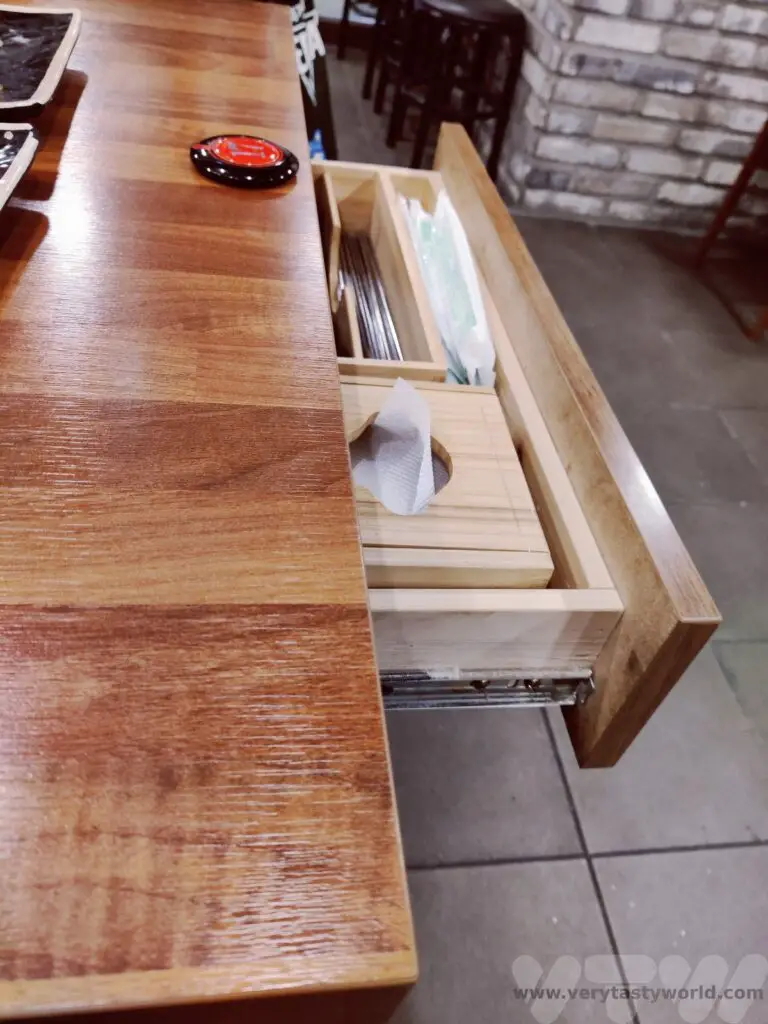
If you can’t find chopsticks and spoons on the table, they will almost certainly be available – either in a box or, rather cleverly, in a drawer under the table. The Golden Rule for a Korean restaurant: always look under the table.
Also, if you want to call over the waiting staff, there is often a button on the table which you can press.
Water is always provided and it’s free of charge. Many restaurants will bring you a bottle or jug of water and some cups but you may have to help yourself. If this is the case there will be a water dispenser and cups available somewhere in the restaurant.
Korean meals always come with banchan – side dishes. Sometimes these will be brought to the table and other times there will be a self-service bar where you can pick up a dish and fill it yourself. Look out for broths as well – there is often soup or broth in a large vat somewhere in the restaurant. It will be a rare meal when you aren’t supplied with kimchi, the ubiquitous and delicious spicy fermented cabbage, which is Korea’s national dish.
At some restaurants the bill was placed on our table when the food was delivered, at others we paid in advance using the machine and yet others the bill was calculated afterwards. You don’t request the bill – just saunter up to the payment area and pay. Cash is fine, cards were accepted in most places. Tipping is not expected nor required. Indeed, like Japan, tipping can sometimes be considered rude.
The Joy of Banchan
One of the most amazing things about Korean dining is banchan – the side dishes. The variety of banchan is quite remarkable. And they aren’t just thrown together. As much care is taken in preparing the banchan as the main dish.

And the very best thing about banchan is that you can order more for free! (It would be a bit rude to ask for more of the dish you have ordered or extra rice, unless you are happy to pay more.)
Of all the banchan, kimchi is the most famous. This crunchy, spicy fermented cabbage dish will be eaten with almost every meal. Even our airline meal to Korea included a packet of kimchi.
It is such a fundamental part of society that it has its own day – 22nd November – and families get together every year to make kimchi. Kimjang: Making and Sharing Kimchi was inscribed on the UNESCO Representative List of the Intangible Cultural Heritage of Humanity.
Korean households usually have two refrigerators – one for normal food and the other, which is set at a specific temperature, for a year’s worth of kimchi! We have been making kimchi for years and have an easy kimchi recipe.
Quintessential Korean Dishes to Try
Bibimbap
This is one of the most well-known of Korean dishes. It is a rice bowl topped with all sorts of delicious ingredients – from vegetables to marinated meat – sometimes garnished with a fried egg. Gochujang, the spicy (not overly spicy) chilli sauce forms the basis for the flavour. Sometimes the bibimbap is presented with the toppings on the rice but in ‘fast food’ bibimbap restaurants the toppings will be placed in the bowl and you will be served the rice separately, to put on top yourself.
The best way to eat bibimbap is to admire it first then get your spoon in and mix it all together, add some sauce, mix some more and then scoff.
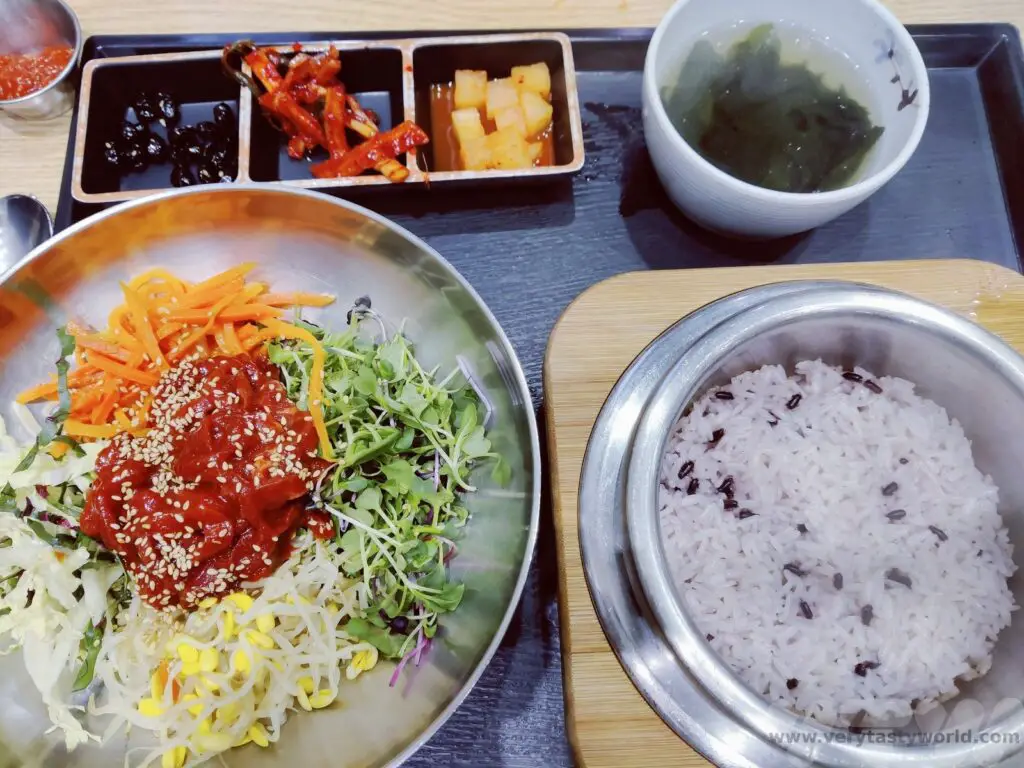
Sharp-eyed readers will notice that in the picture above the rice is served to the right. This is because we were given a tea pot and , after transferring the rice into the bowl of goodies, we then added hot stock to the rice crust inside the bowl to make a lovely soup.
Gimbap
They may look like Japanese sushi maki (sushi rolls) but gimbap (gim = seaweed, bap = rice) are very different. They are not seasoned with vinegar but sesame and they are sauced internally. Whereas maki often largely comprise raw fish, gimbap includes a vast array of ingredients – there is much more filling than rice. You can expect pickles, fresh vegetable, meats/fish or omelette all lovingly wrapped in a seaweed casing. You don’t dip them in soy sauce or wasabi. Many gimbap outlets in the cities are open 24 hours so this makes a great breakfast option.
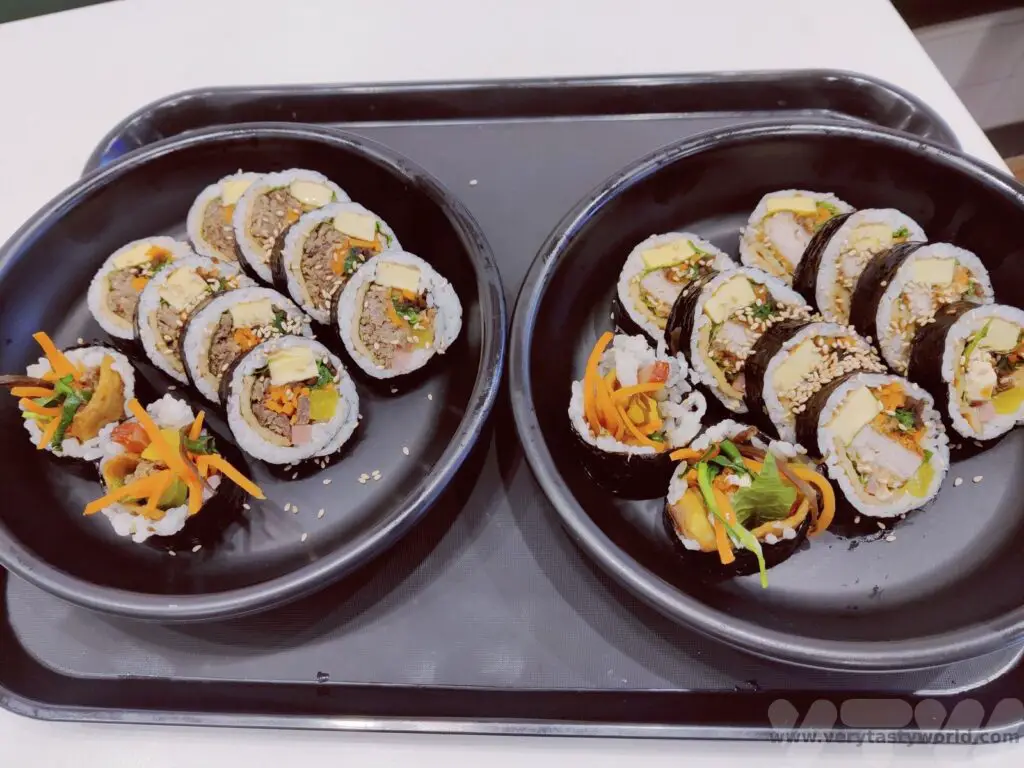
BBQ
Another essential meal to enjoy while visiting Korea is BBQ – luscious cuts of meat, sizzling on a hot plate, cooking over fire (sometimes butane but charcoal is traditional which adds a delightful smoky element).
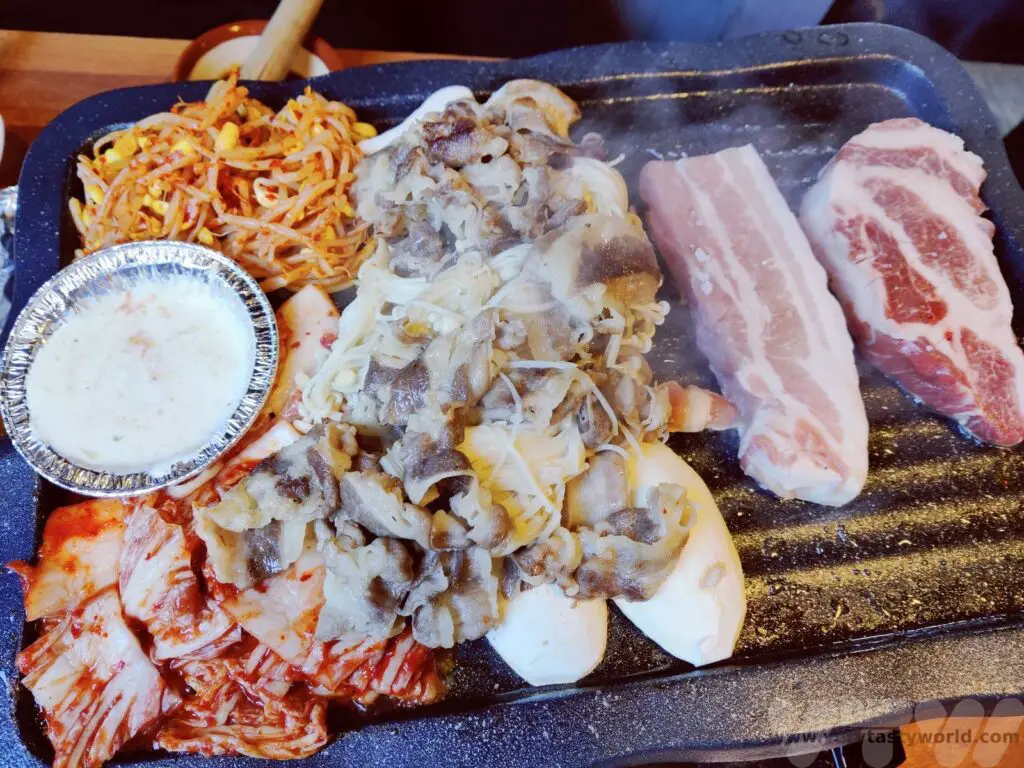
And BBQ is where another brilliant Korean table setting element comes into its own: the scissors! Korean kitchen scissors are the absolute best, they have thicker blades than ordinary scissors and cut food quickly and efficiently.
The meat is initially seared and cooked as a full joint. Then, as it cooks, tongs and scissors are used to cut the meat into bite-sized strips.
If you aren’t confident doing the cooking, the staff are absolute experts and will know exactly what to cook and in what order, so you can sit back, sip a soju and enjoy the show. But if you fancy having a go it’s fine to go for a DIY approach.
Ssam, which means ‘wrapped’, is a great way of enjoying BBQ. As well as banchan, a number of different leafy vegetables will be supplied – lettuce leaves or herbs such as perilla (below). You pick up a juicy piece of bbq meat with your chopsticks, place it on the leaf, add some kimchi and a dab of sauce, then wrap it up and pop it into your mouth – delish! If you run out of leaves, you can always ask for more.
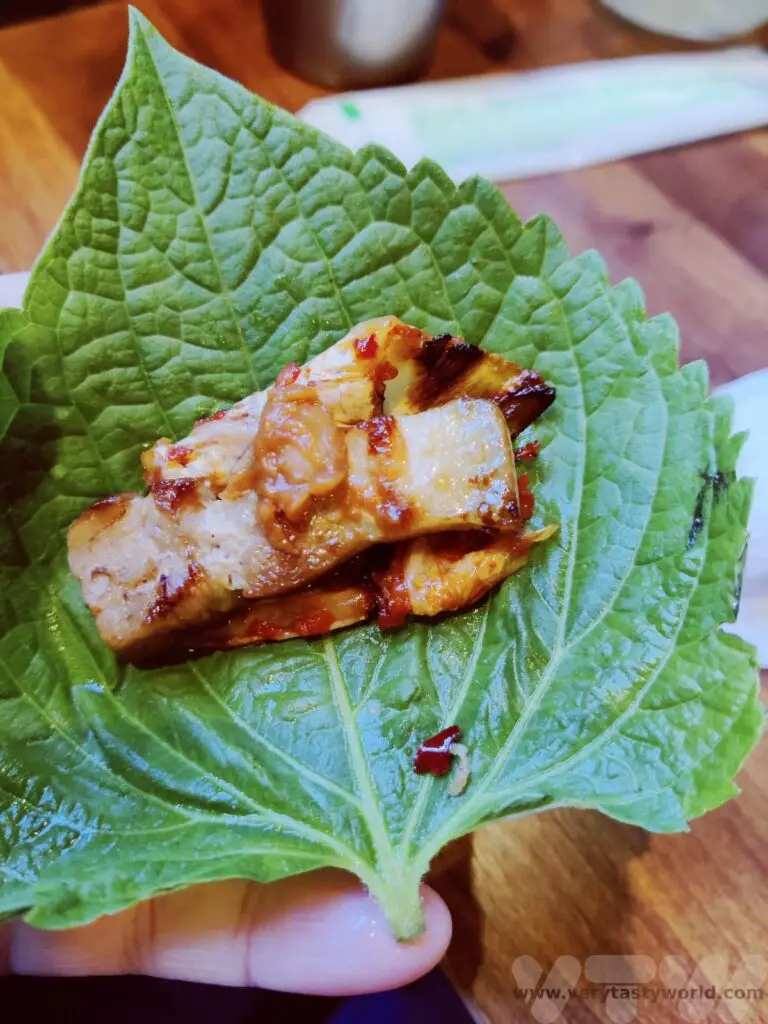
Chimaek (Chicken and Beer)
KFC is an essential item to try when visiting Korea. Not that KFC, of course, but Korean fried chicken. Chimaek 치맥 derives from chikin = fried chicken (unsurprisingly) and maekju = beer.
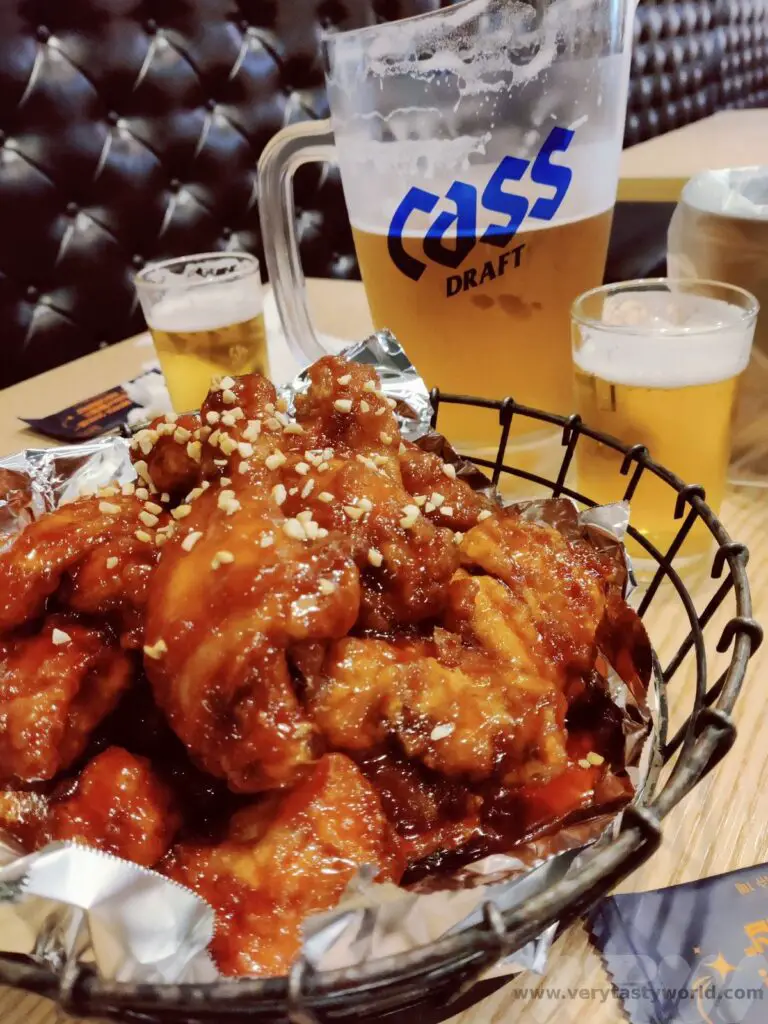
A very sociable way to enjoy fried chicken is to scoff it with beer and enjoy it with friends. When we visited a chicken and beer restaurant in Busan a single order provided a whole chicken’s worth of deep-fried joy, in a spicy sauce. Local beers are much cheaper than imported.
Bulgolgi
Bulgolgi is very popular dish comprised of marinated thinly slices of meat, usually beef, cooked on a griddle. The name translates as fire meat (bul = fire, golgi = meat). Some restaurants will offer a set menu where bulgolgi forms the centrepiece of the dish and you have multiple banchan to accompany, other restaurants let you cook the meat at the table. Just use your chopsticks to pick heavily flavoured, succulent pieces of meat.
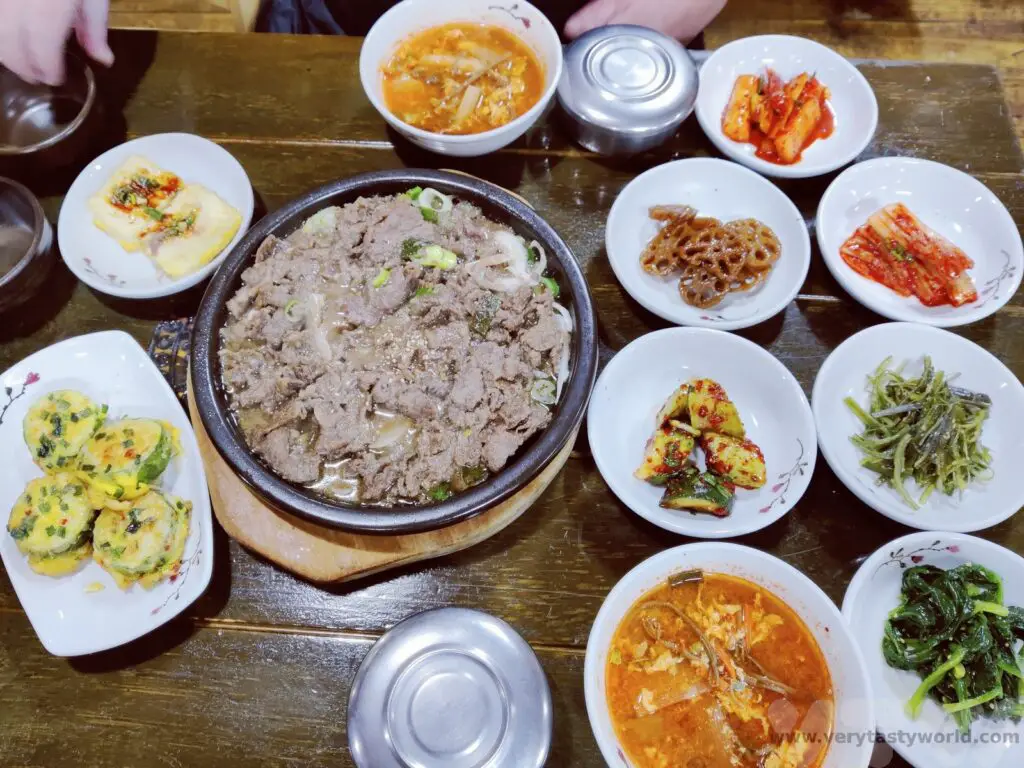
Jjigae (Korean stew)
We visited in November and temperatures were dropping fast as winter approached. Jjigae is comfort food – warming and delicious. There are many varieties available – meat, tofu and vegetables – seasoned with a variety of sauces. Gochujang (chilli paste) and doenjang (soy bean paste, a bit like miso) are popular options. Stews will always be accompanied by rice and banchan. It makes for a feast.

Pajeon (Korean pancakes)
Pajeon is a celebratory food. These are pancakes that incorporate vegetables (largely spring or green onions) and other delectable fillings such as seafood.
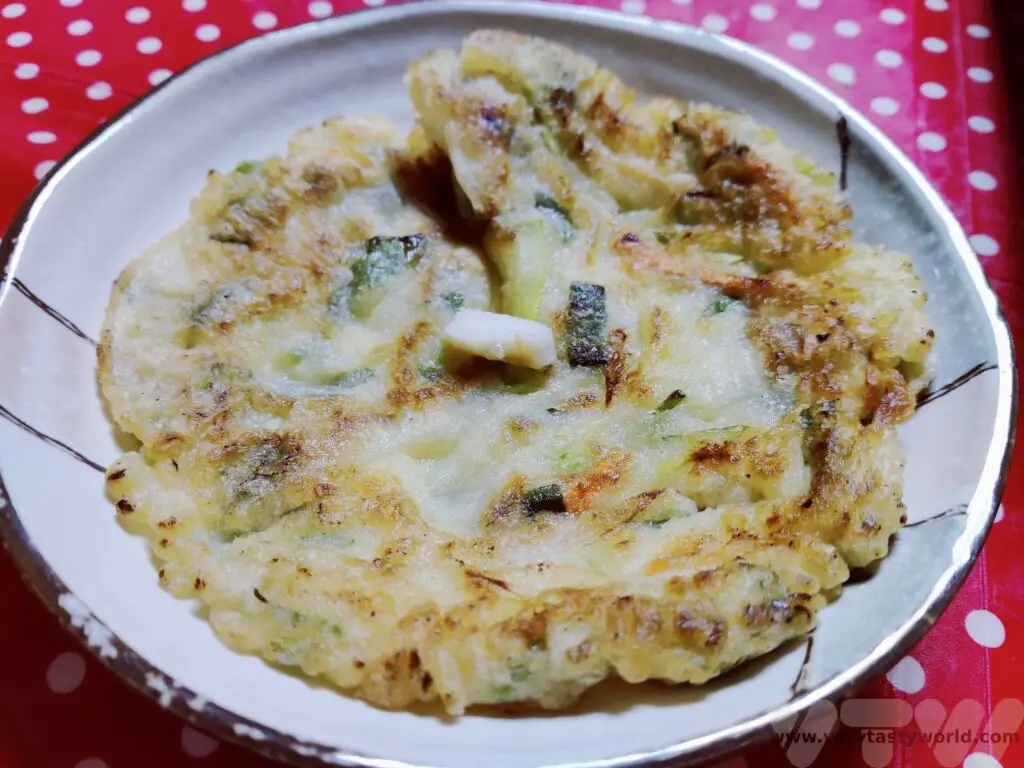
Eomuk – Fishcakes
Minced fish with vegetables and seasonings is another popular dish. These are available in shops/restaurants but are also widely available as street food.
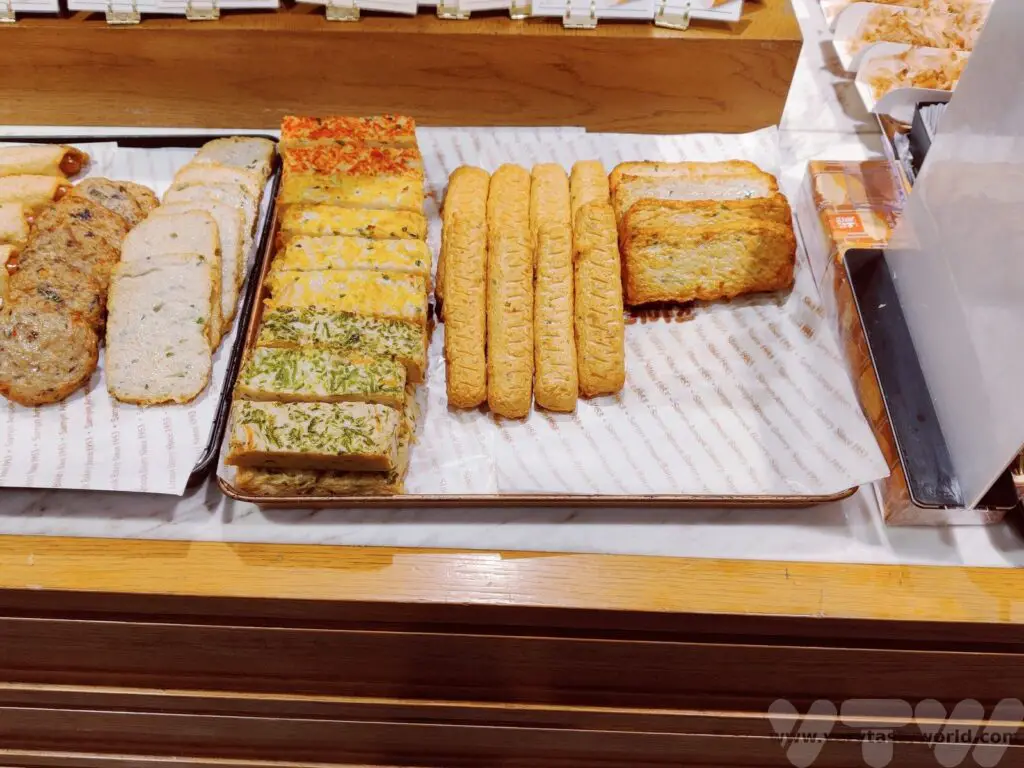
Dining At The Market
Both Seoul and Busan have large and extensive fish markets and it is possible not only to visit them but you can also eat incredibly fresh fish in the restaurants on the upper floors.
If you want, you can buy the fish in the market and then take it upstairs to be cooked to your liking. There will be a table charge (which may be reduced if you decide to order the restaurant’s fish stew) and a cooking charge.
In Busan, the Jalgachi market is the largest in South Korea and has multiple restaurants on the first floor, which all have the same menu. In Seoul some of the restaurants in the Noryangjin fish markets will help you – either by explaining the process, or by offering a picture menu where you can choose your fish/shellfish (they will give the market price) and they will go downstairs to buy the fish for you.
We enjoyed a plate of raw wild fish, sashimi style with eye-wateringly fiery wasabi. It was very different to the Japanese sashimi we have eaten in the past. It didn’t melt in the mouth but had a much firmer texture. The sashimi was accompanied by wonderfully sweet pan-fried rockfish, fresh crab and deliciously umami fish stews.
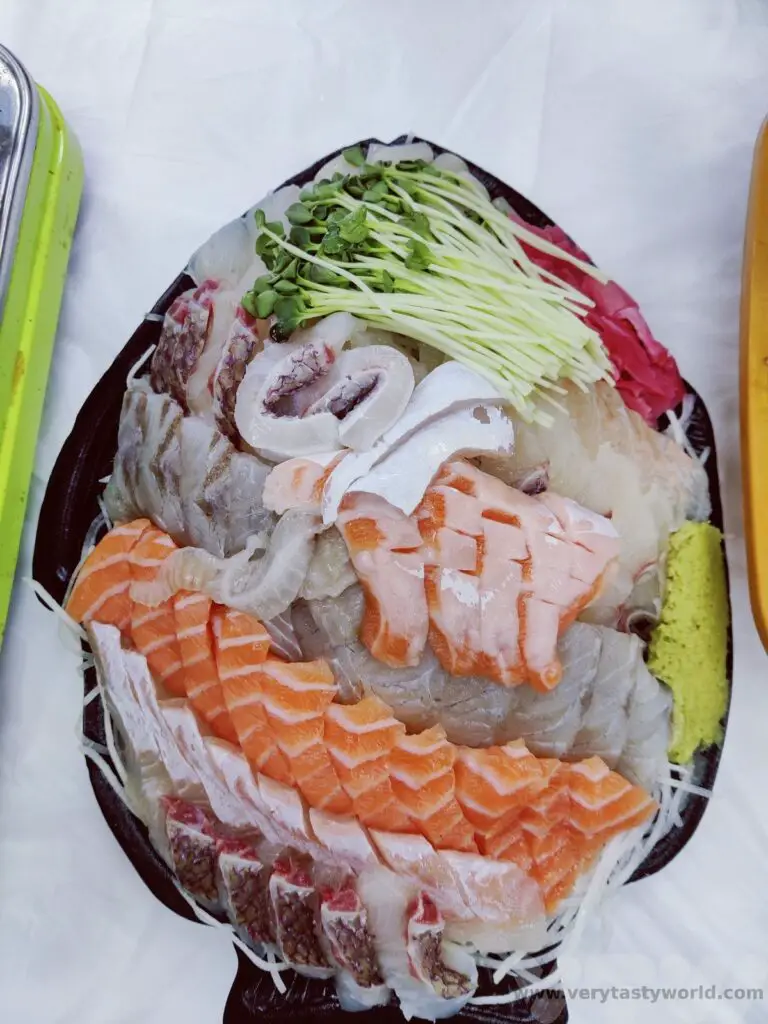
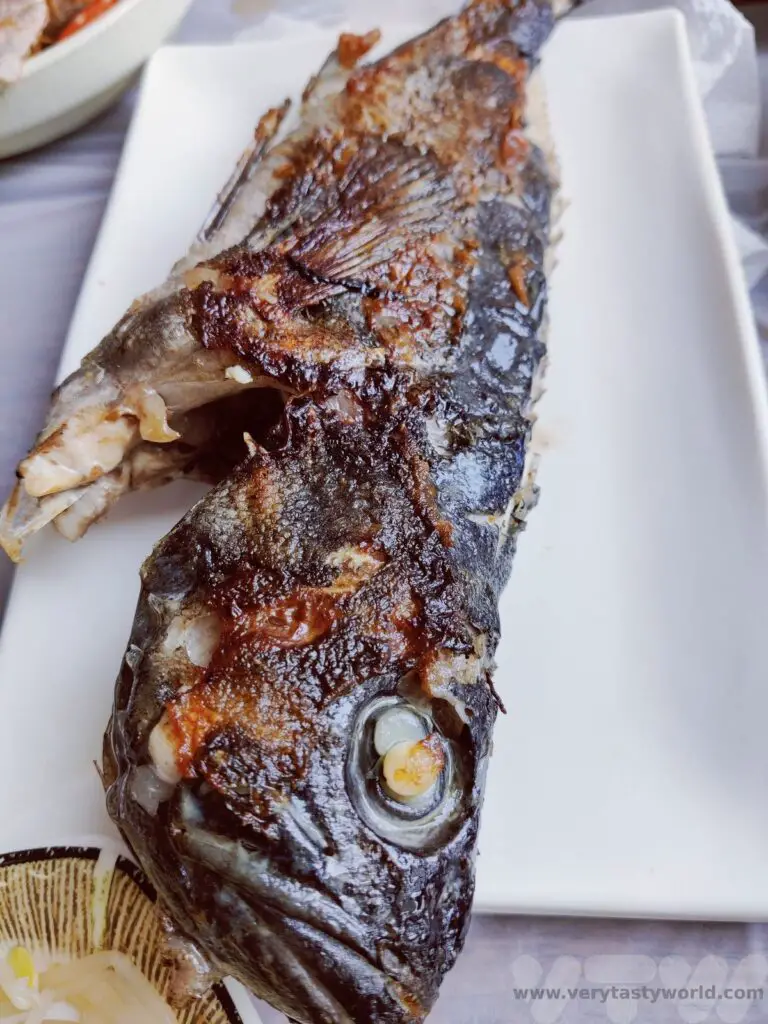
If you’re eating crab those amazing Korean scissors come into play – they will easily cut through the hard shell then you can use a chopstick to pick out the sweet and succulent crabmeat.
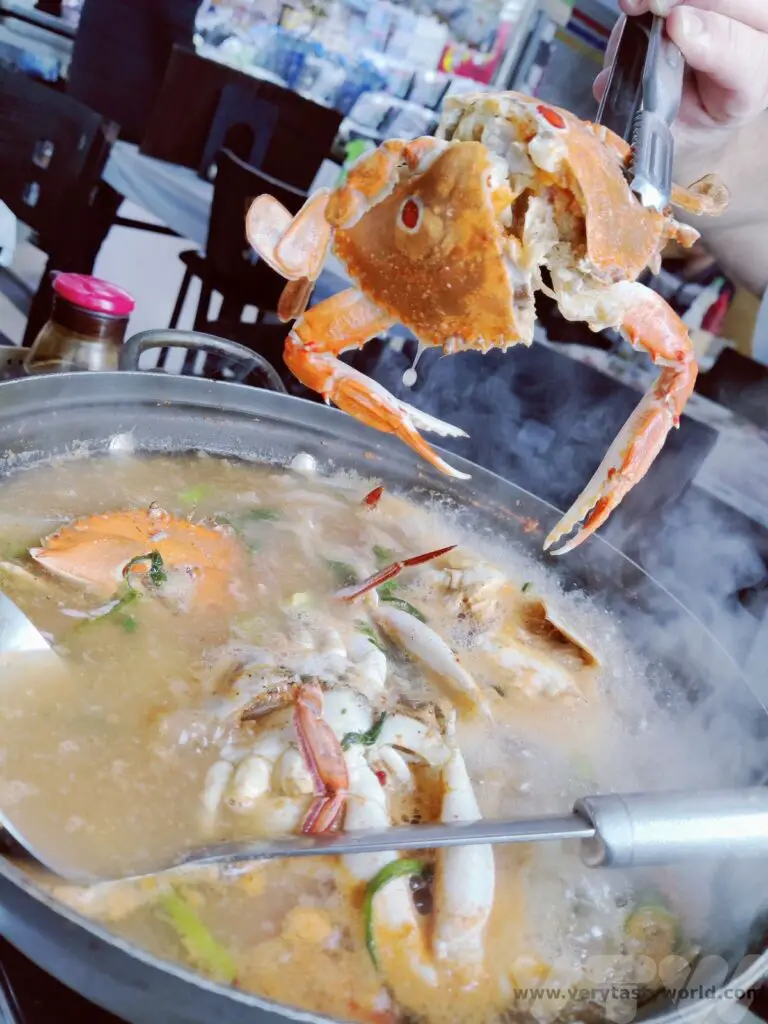
Street Food
The very first Korean food we tried was at a local market which we had decided to explore just as we had arrived in the afternoon in Seoul. Feeling tired and slightly woozy after a 16 hour journey, we sauntered up to a market stall and bought a fishcake for a mere 1000 won (less than $1). This undulating slice of fishy goodness woven along a wooden stick and served in a cup with a generous splash of stock was sublime – warming and packed with umami. We were instantly sold on street food.
We decided to have breakfast at Seomun market in Daegu one day. There was a wide variety of food on offer. Some of the fishcakes keep warm in a broth – watch out for the red-tipped sticks as those will be the spicy ones!
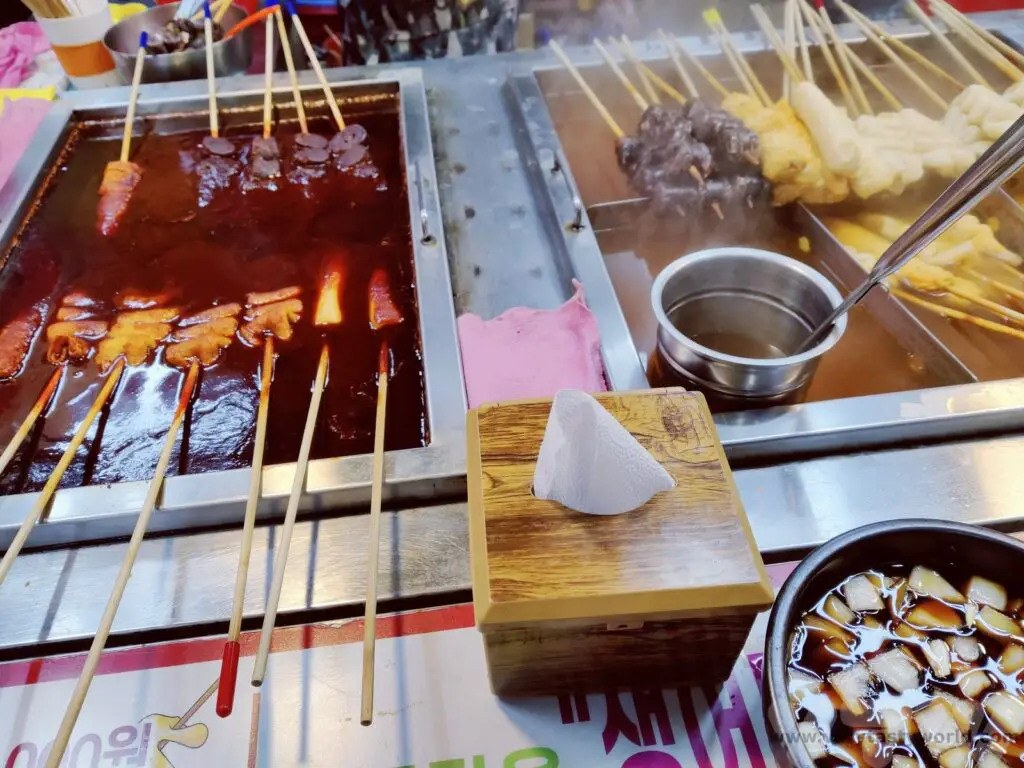
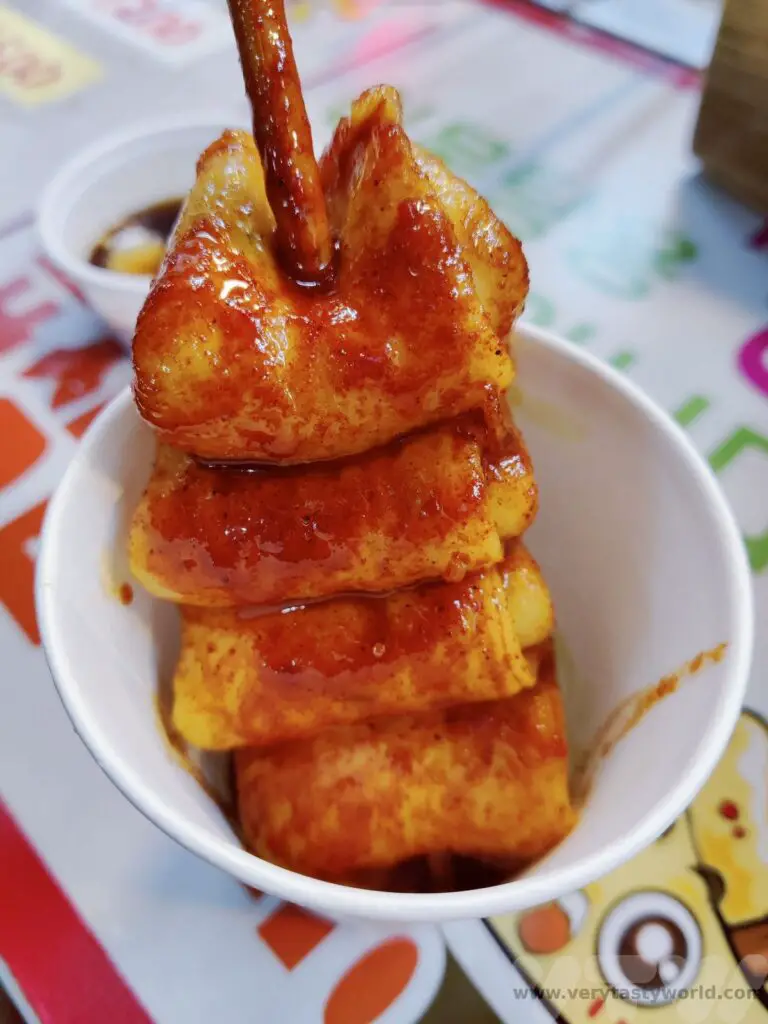
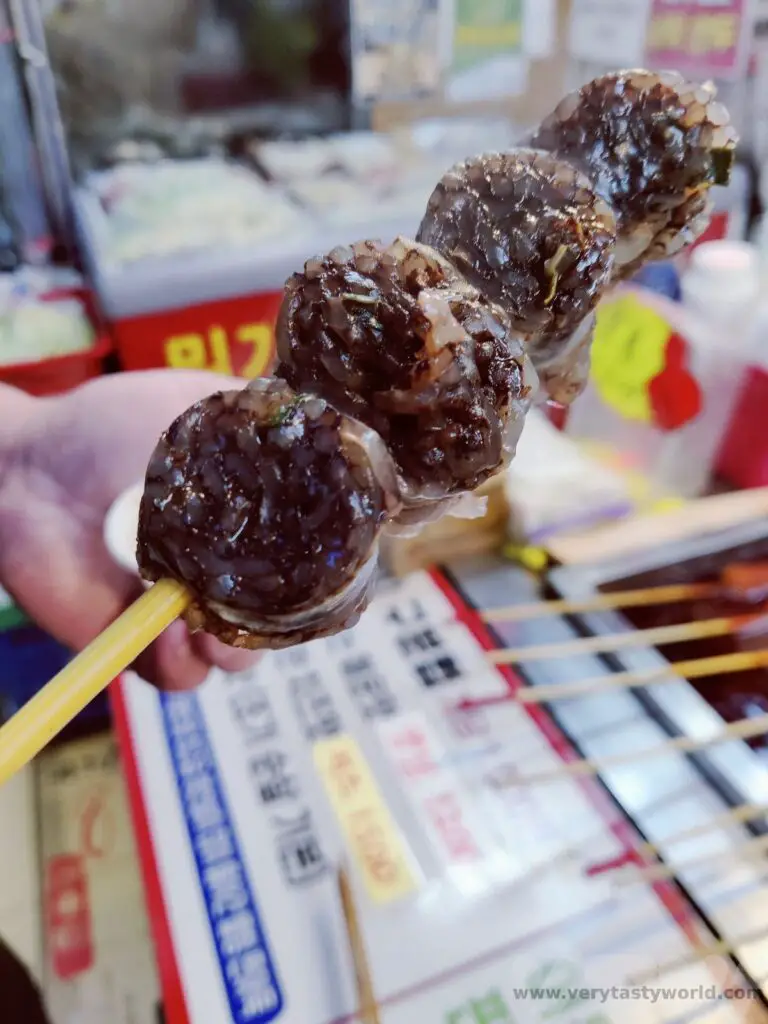
Hotteok (sounds a bit like hot-dog) is a fluffy fried doughnut filled with seeds and nuts.
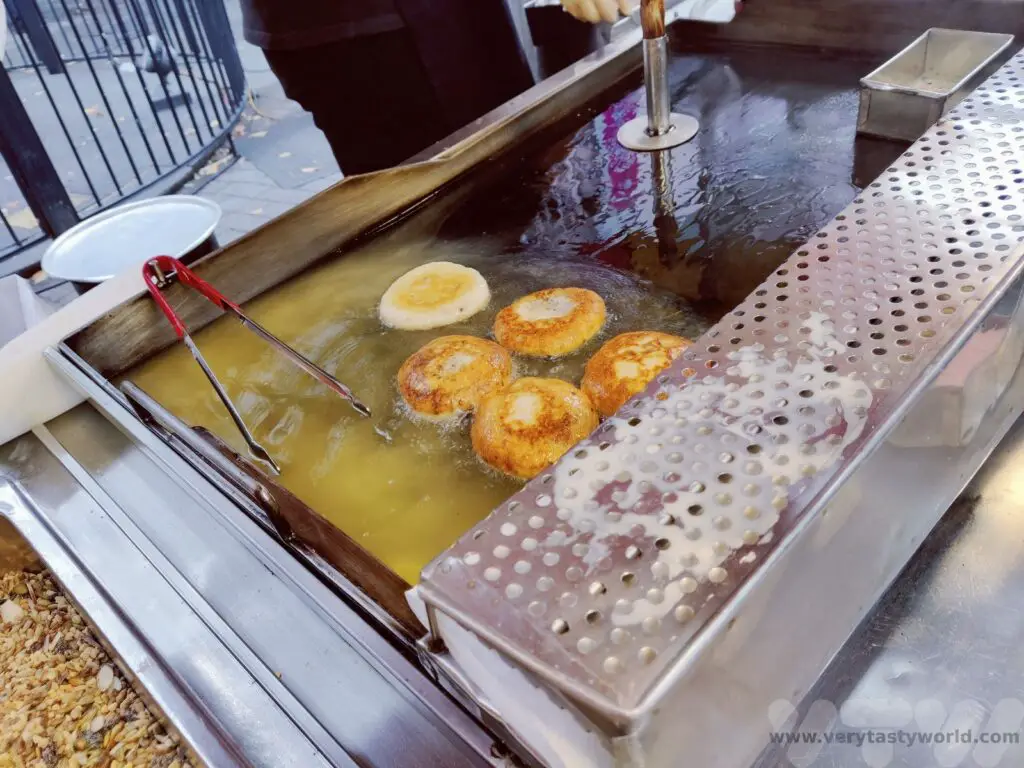
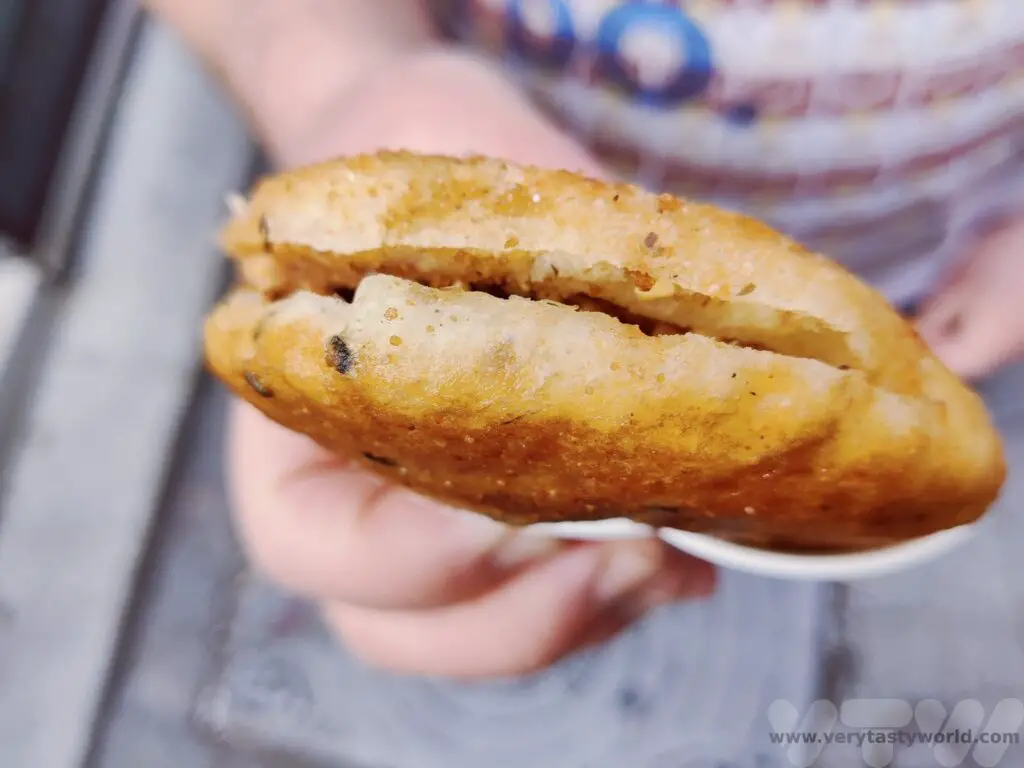
Many market stalls make pancakes fresh to order.
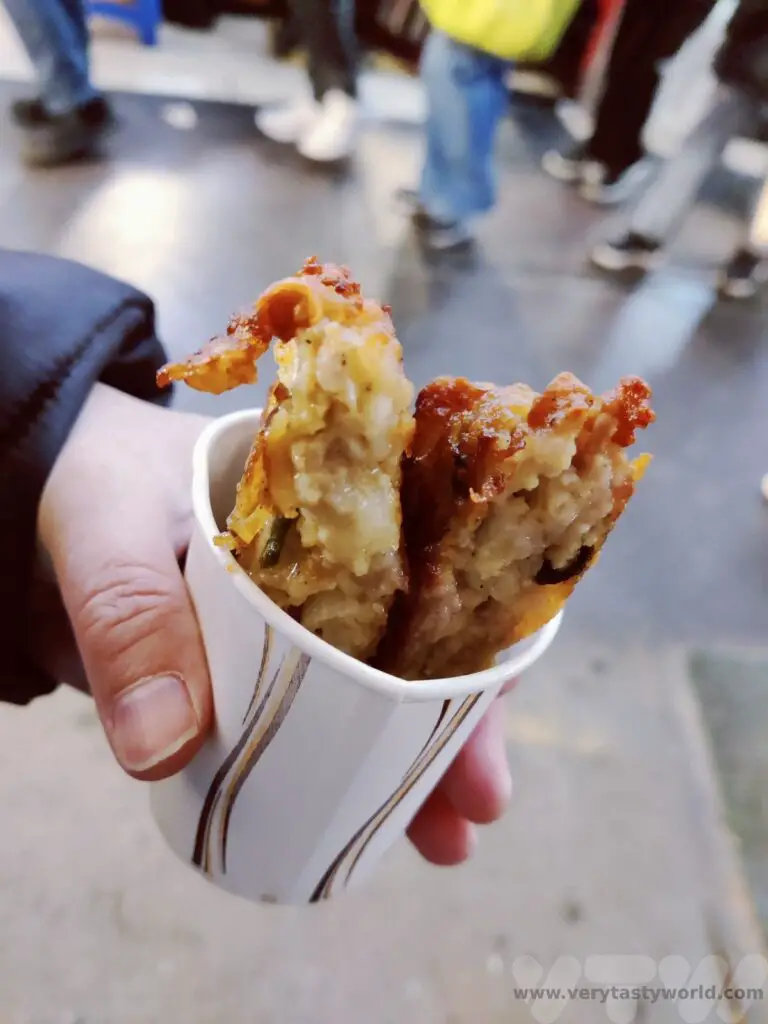
Most street food is served in paper cups.
Vegetarians/Vegans
It is not impossible to dine well if you are vegetarian or vegan. We did spot some vegan restaurants in many of the cities we visited. Veggie options will be available – e.g. tofu stews – but you might have to be careful that the base stock is vegetable based as some of these may use fish.
A menu that did make us laugh a little was a dumpling restaurant in Gyeongju. The proprietor was absolutely delightful and made awesome dumplings, plump and filling, in a variety of styles. But the menu was admirably honest about the fact that there was pork in all the savoury dumplings. Which is actually reassuring.
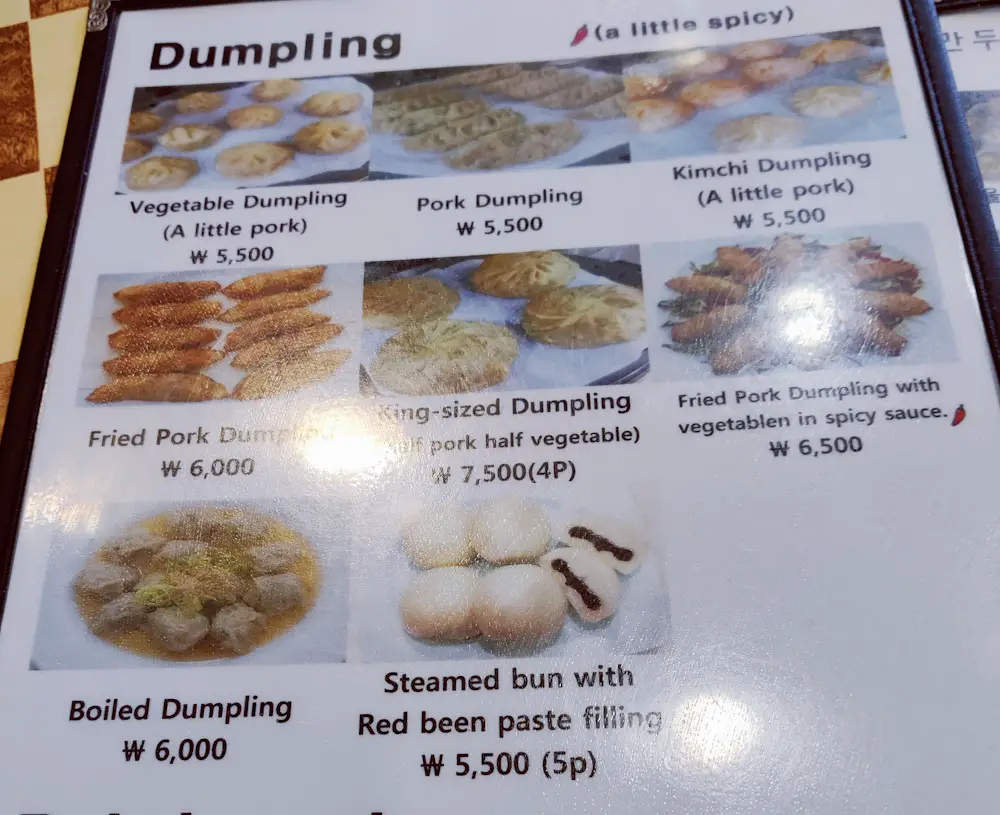
Some Useful Phrases
| Please give me | 주세요 | joo-say-yo | Say at the end of the sentence after the thing you want. e.g. banchan joo-say-yo |
| Excuse me YOU – over here | – 저기요 | juh-gee-oh | To get attention |
| People | 세명 | doo myung | 2 people. If you want a table for 2, it’s fine to just indicate with your fingers |
| Bottle | 맥주 여섯 병 | maek-ju doo byung | maek-ju (beer) doo byung (2 bottles) |
| 1 more bottle of soju please | 소주 두병 더 주세요 | so-ju hana-byung duh joo-say-yo | |
| More | 더 | Duh | |
| Please give me more kimchi | 김치 더 주세요 | kimchi duh joo-say-yo | |
| This please (pointing) | 이거 주세요 | Ee-guh joo-say-yo | |
| Delicious | 맛있어요 | mah-shis-say-yo | Saying this was guaranteed to raise a smile at the end of our meals! |
| NUMBER | KOREAN | Korean pronunciation |
| One | 하나 | hana |
| Two | 둘 | dool |
| Three | 셋 | sayt |
| Four | 더섯 | nayt |
| Five | 더섯 | duh-suht |
| Six | 여섯 | yuh-suht |
| Seven | 일곱 | ill-gope |
| Eight | 여덜 | yuh-duhl |
| Nine | 아홉 | ah-hope |
| Ten | 열 | yuhl |
| Eleven | 열하나 | yuhl-hana |
A Cookery Class
A fun way to spend an afternoon in Seoul or Busan is to join a cookery class. With a small group of fellow travellers these classes usually involve a visit to a local market to learn about the amazing produce on sale – from the familiar to some enticingly unusual foods.
Then you’ll go on to visit your host’s home to cook several delicious dishes. We made pajeon – and had great fun flipping the pancakes. Bibimbap and dakgalgi (a spicy chicken dish) were also on the menu.
Related Posts You May Enjoy

Thanks so much for reading. We hope you enjoyed this article. If you’d like to keep up to date with new posts and recipes, please subscribe to our newsletter or follow us on social media – X, Facebook or Instagram. We always love hearing from you and would be delighted to read your thoughts about this article.

How To Get From Seoul To Gyeongju by Train
Gyeongju in south-eastern Korea is often described as a ‘museum without walls.’ It’s easy to see why. It is the former capital of the Silla Kingdom which ruled a large proportion of the Korean peninsula from around 57 BCE to 935 CE. It is genuinely a treasure trove of historic buildings and artefacts. We recommend visiting this wonderful city if you are travelling in South Korea. Here’s our guide on how to travel from Seoul to Gyeongju.

Please note that this post contains affiliate links. If you click through and decide to make a purchase we will make a small commission, at no extra cost to you, which will help towards the costs of running this site.
Seoul to Gyeongju By Train
South Korea’s rail network is fast and efficient. If you want arrive quickly, we recommend using the KTX, the high-speed train service, from Seoul Station. You can reach the main railway station on lines 1 and 4 on the metro. The train station is bright and airy and the departure board will indicate the train number, time, destination and departure track in multiple languages, including English.
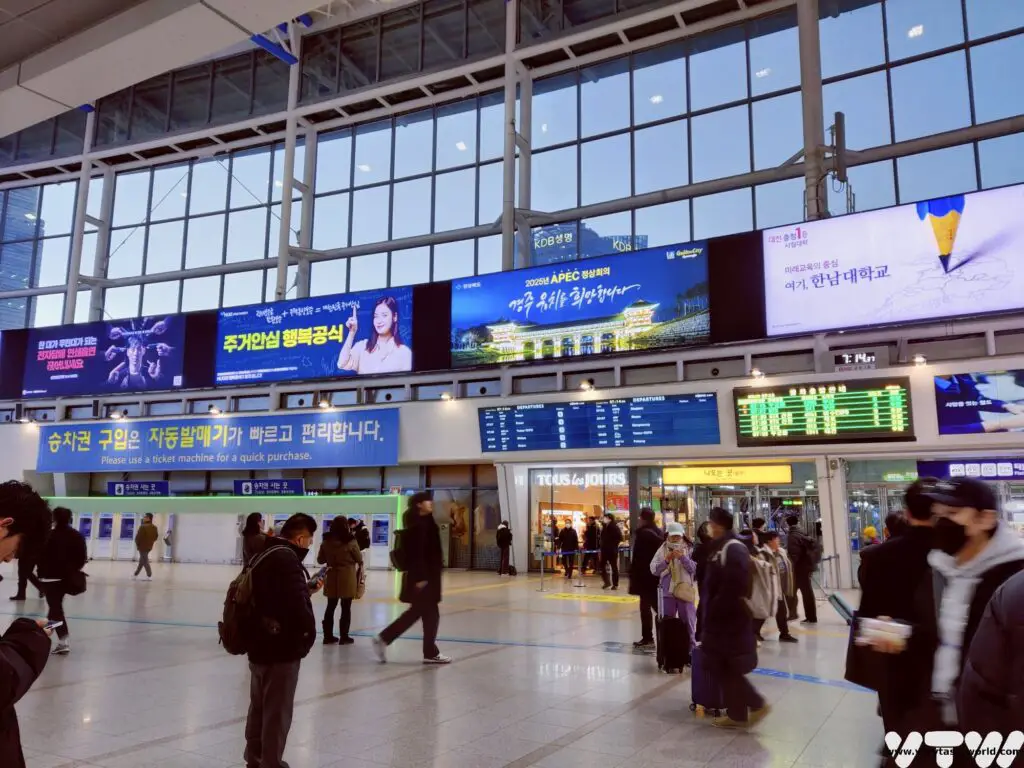
When you arrive on the platform, there will be an indication where your train’s car will be located. Your seat reservation will indicate a car and seat number. There is an overhead shelf for smaller bags above the seats inside the carriage, and a storage area for larger luggage at the end of each car by the doors. The train journey takes around two and a half hours from Seoul to Gyeongju.

However, the KTX does not reach Gyeongju centre. The train will stop at Singyeongju station which is located a few kilometres out of town. It’s the city’s newest station and was opened in 2010.
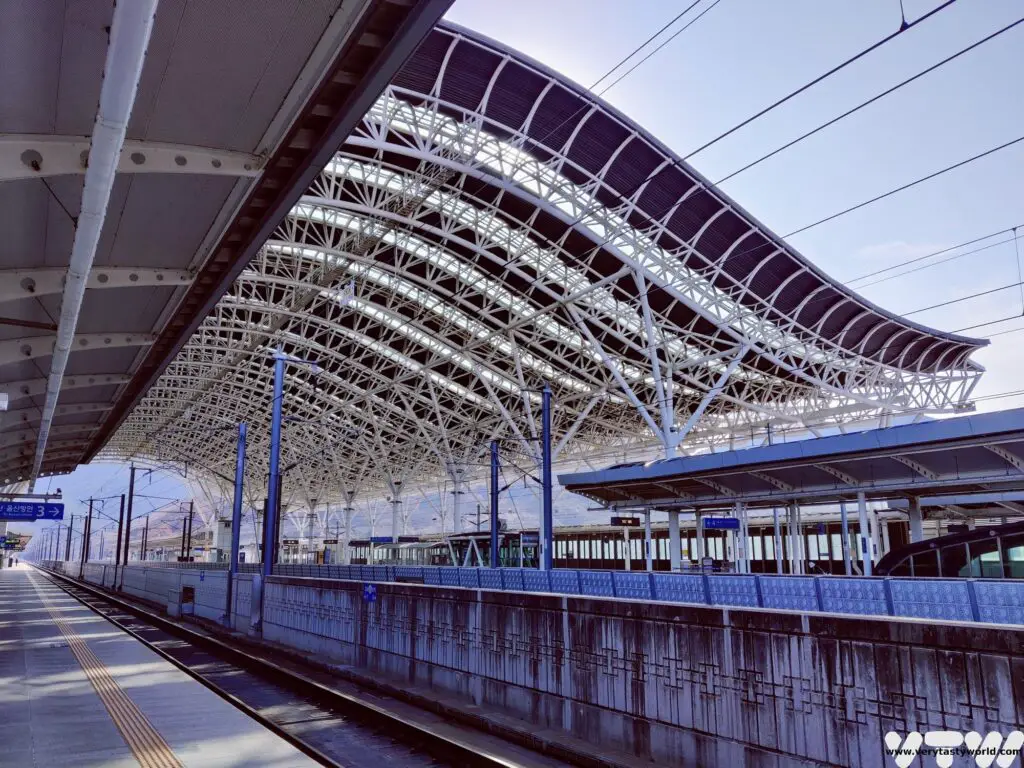
You will need to catch a bus or take a taxi to the city centre.
Taxis are definitely easier. They take around 10-15 minutes and cost between 15,000 and 20,000 Won (around $11-15 at current prices). You can also put your luggage into the boot/trunk of the taxi. There are plenty of taxis waiting at the station.
The bus journey takes around 25-30 minutes. Bus numbers 50, 70 or 700 run to and from the station regularly and will take you into town. The cost is 2,500 won (2023 price).
If you have a T-money card you can use this to pay for your bus fare. Just tap your card on entering the bus at the front by the driver and don’t forget to tap out when you exit at the middle of the bus.
We recommend getting a T-money card when you arrive in South Korea which you can pick up on arrival at the airport. They are so convenient for paying for public transport and other services. You can charge them with cash all over the country, including at convenience stores. (N.B. you can only charge them with cash)
One thing that’s worth noting is that when a train comes in there may well be a lot of passengers, so getting a seat on the bus might not be easy. We were the last ones on and had to stand. Not a problem except…
…well, Gyeongju does have a popular theme park but you can truly experience the thrills of a rollercoaster simply by travelling on the bus. Our journey into Gyeongju city was ‘enhanced’ by a driver who was either in a hurry or was a sadist who enjoyed watching hapless tourists in his rearview mirror, loaded with luggage, clinging to the handrails whilst trying to avoid flying around the bus, as he sped up, hurtled around corners and slammed on the brakes.
We think this was a one-off – our bus ride back to the station was much more sedate.
Train Travel Tips
If you are planning to travel by train through South Korea you might want to consider buying a KoRail Pass. These are passes that allow foreign visitors unlimited journeys on the rail network on particular days. There are various options available:
Consecutive Passes: You can use these on either 3 days or 5 days in a row – useful if you are travelling on consecutive days.
Select Passes: You can use these on any 2 individual days or any 4 individual days within a 10 day period. These are useful if you are travelling around Korea and want to spend some time at different locations before moving on.
You can buy the pass within 31 days of travel and you need to know which day you plan to activate the card.
The pass can be ordered online and printed off. You need to carry the pass with you and it is linked to your passport.
The pass can represent good value if you are planning on travelling to lots of locations in South Korea. We recommend checking prices to see whether the cost of a rail pass is cheaper than buying individual tickets.
Tip: If you know your travel dates, book your KTX seats early, several days in advance if possible. Seoul’s railway station has a ticket office where you can purchase tickets and book seats. We went to the office to validate our rail passes and book our seats. We planned to travel on a weekday, three days after our arrival, and had difficulty getting seats together on the train. It meant that we had to leave really early in the morning to catch a train, which turned out to be a blessing as it meant we had more time to explore Gyeongju.
The Korea Trains website has information about timetables and ticket booking.
If you are travelling on the train using a pass you will need to carry a printout of the pass, the seat reservations and your passport to confirm your identity – which should match the name on your pass. We were never challenged during our journey through Korea but the terms of the pass state that you must be able to produce this documentation if requested.
Alternative Ways to Travel From Seoul To Gyeongju
It is possible to catch the express bus to Gyeongju. The price is cheaper and the bus will take you directly into the city centre. The total journey time is around three and a half hours.
The bus leaves from Seoul Express Bus Terminal which is located in the Banpo-dong part of Seocho district. You can reach the bus terminal via metro lines 3, 7 and 9.
You can check the bus route information and ticket availability at the express bus website.
If you want maximum flexibility you can hire a car. The journey time will take around 5-6 hours, depending on where you are travelling from in Seoul and how congested the traffic is. A car would also be very useful when exploring Gyeongju as many of the historic attractions are located a few kilometres from the city centre.
Getting from Busan to Gyeongju
Gyeongju is also a popular day trip from Korea’s southern city of Busan. It’s an hour away on the train. Once again you can use a KTX pass to reach Singyeongju.
Alternatively, there are companies that offer day trips to see the main sights. Although we realise that time can be tight when travelling, we loved Gyeongju so much that we recommend staying in the area if possible. There is so much to see, a day trip would only really scratch the surface.



RECIPE: How To Make Kimchi
Kimchi is a fundamental part of society in Korea. It is Korea’s national dish and is usually eaten with most meals there. In fact, kimchi making has been assigned as a UNESCO cultural heritage and even has its own day – 22nd November. Kimchi is great fun to make and we have a recipe for how to make kimchi. It isn’t a traditional Korean style but it’s easy to make, is ready very quickly and we reckon it’s much more delicious than shop-bought.
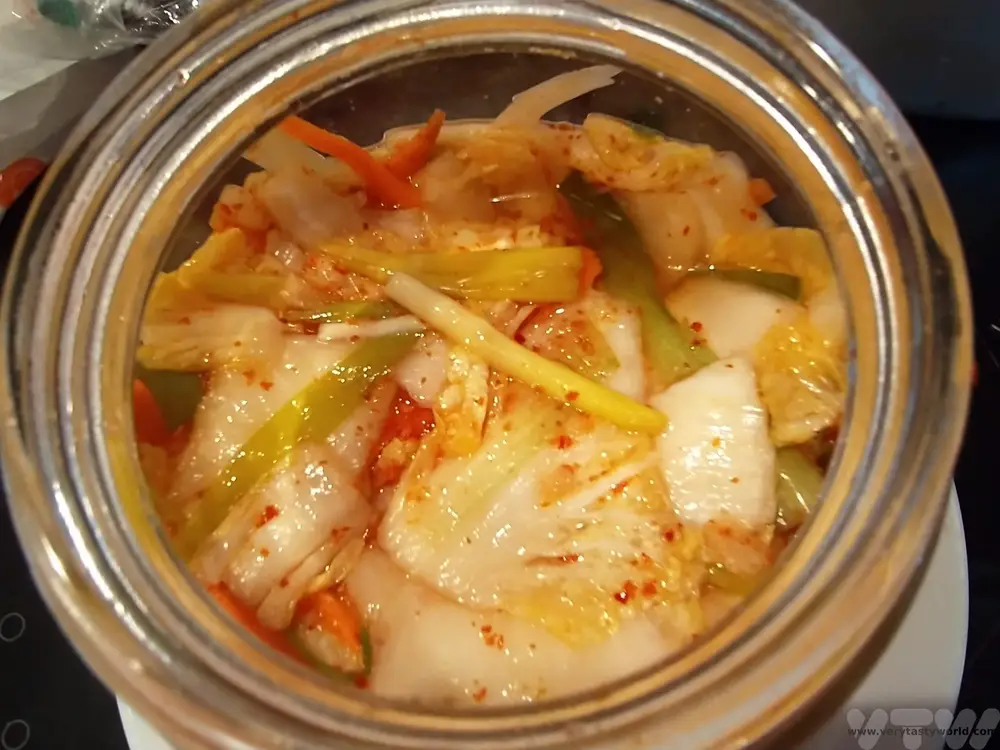
We first tried kimchi over 20 years ago and it was love at first bite – sour, spicy and crunchy, it has a unique flavour. Being a fermented food it is also purported to have properties that are beneficial for your gut health but, far more importantly, it’s delicious.
It’s surprisingly easy to make but it does take a while to ferment and you do have to watch out for potential explosions but that is what makes it so exciting! (Don’t worry, we’ve been making it for years and have never had an explosion – we have some advice on the best equipment to use at the end of this post.) We have tried fermenting lots different foods over the years, including miso, and it’s a very satisfactory process.
Kimchi is made via a lacto fermentation process whereby good bacteria, known as lactic acid bacteria, convert the sugars in vegetables into lactic acid. The joy of fermentation is that it isn’t a precise art. You need a bit of patience while the bacteria do their thing but once fermentation is complete, the finished product will last for many months, if not years – that is, if you don’t eat it straight away!
Ingredients For Making Kimchi
1 Chinese leaf cabbage (also known as Napa cabbage)
1 carrot
2 spring onions (green onions)
A carrot’s length of daikon white radish, also known as mooli (optional)
2 fat cloves of garlic (3 if your garlic isn’t portly enough)
1 tbs fish sauce (vegetarians can use soy sauce, but use less – 1/2 tbs)
1 thumb-sized piece of ginger
1 tbs Korean chilli red pepper powder known as Gochugaru (you should be able to find this in Asian stores and even supermarkets these days). A variation is to use Korean chilli paste, known as Gochujang. Gochujang is traditional but we prefer the chilli powder for this kimchi.
3 tbs salt. You want to use a salt that doesn’t have anti-caking additives. Table salt isn’t recommended. Equally you don’t really want to use really posh salt. We tend to use Himalayan pink salt.
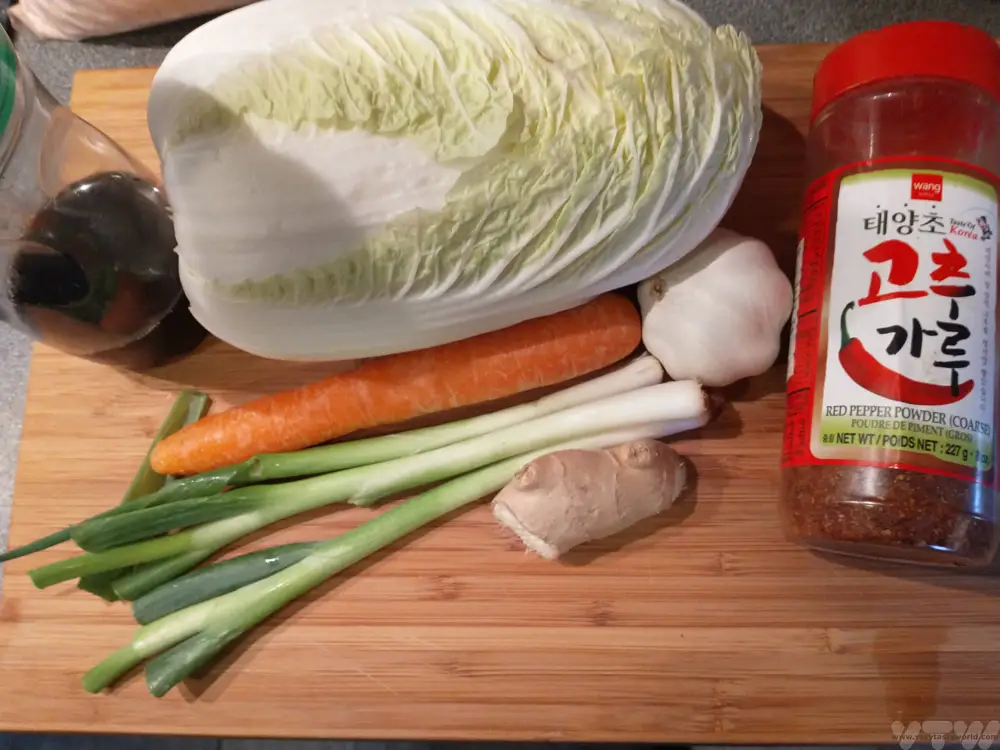
How To Make Kimchi: Method
Slice the cabbage into chunks. You want to have easily pick-upable bite-sized pieces. One of the nice things about the Chinese leaf is that it has a lovely broad ribs which retain their crunch when the kimchi is finished which makes a nice contrast with the softer leaves.
Place cabbage into a bowl and sprinkle with the salt. Massage the salt into the cabbage and wait a couple of hours. It is a lot of salt but you will be washing it through later.
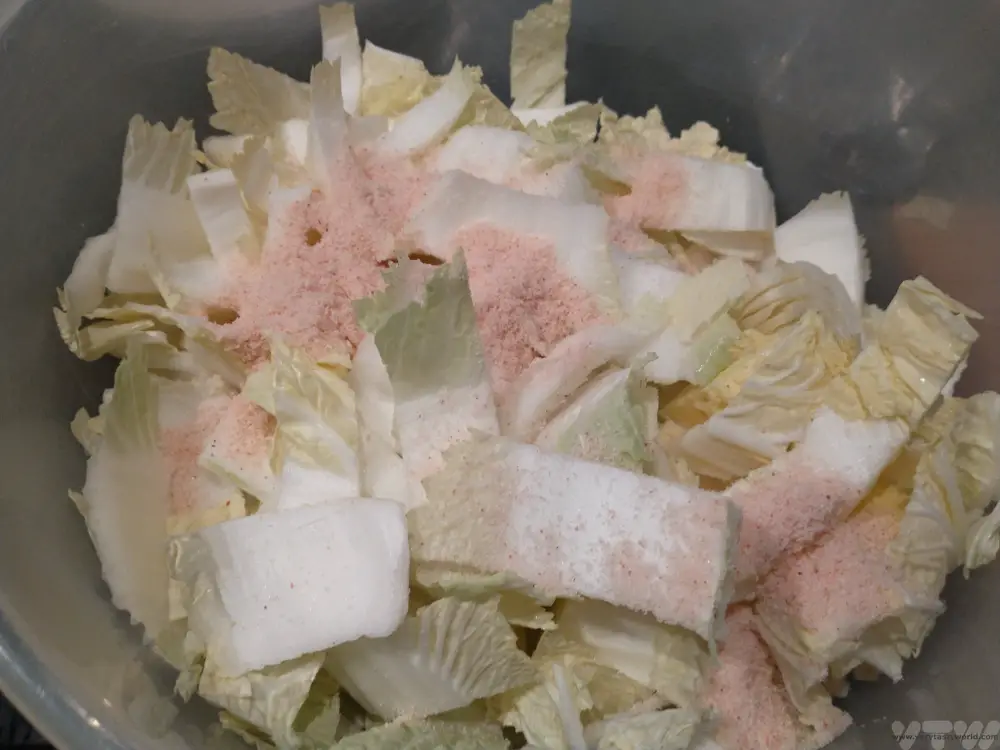
Prepare your fermentation jar. The size of the jar is important. You want to fill the jar up as much as possible and not have too much headspace. The jar size that suited our cabbage was 1.4 litre capacity. We recommend clip top Kilner jars as they have a good seal to keep air out but also let the liquid escape. There are some types of jar specifically designed for fermentation. We’ve had greater success with some than others.
The jar needs to be clean. We find the best way to clean the jar is to wash it in warm, soapy water and rinse. Then we boil a kettle and fill the jar (not forgetting the lid) with boiling water. After 10 minutes, drain and let the jar cool down. Some people put the jar into the oven on a low heat for 20 minutes but we haven’t found this step to be necessary for this type of fermentation.
After some time has passed, give the cabbage a quick rinse with water. Have a taste – it should taste salty but not overpoweringly salty. You don’t need to pat the cabbage dry.
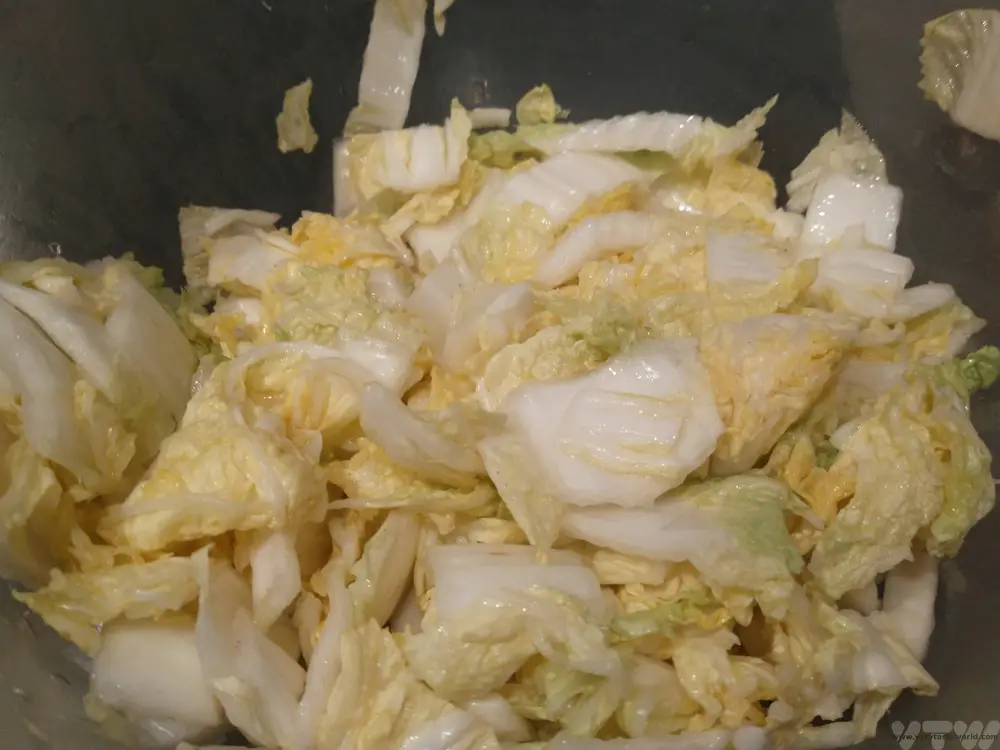
Julienne the carrot and daikon, if you are using it, slice the spring onions lengthways.
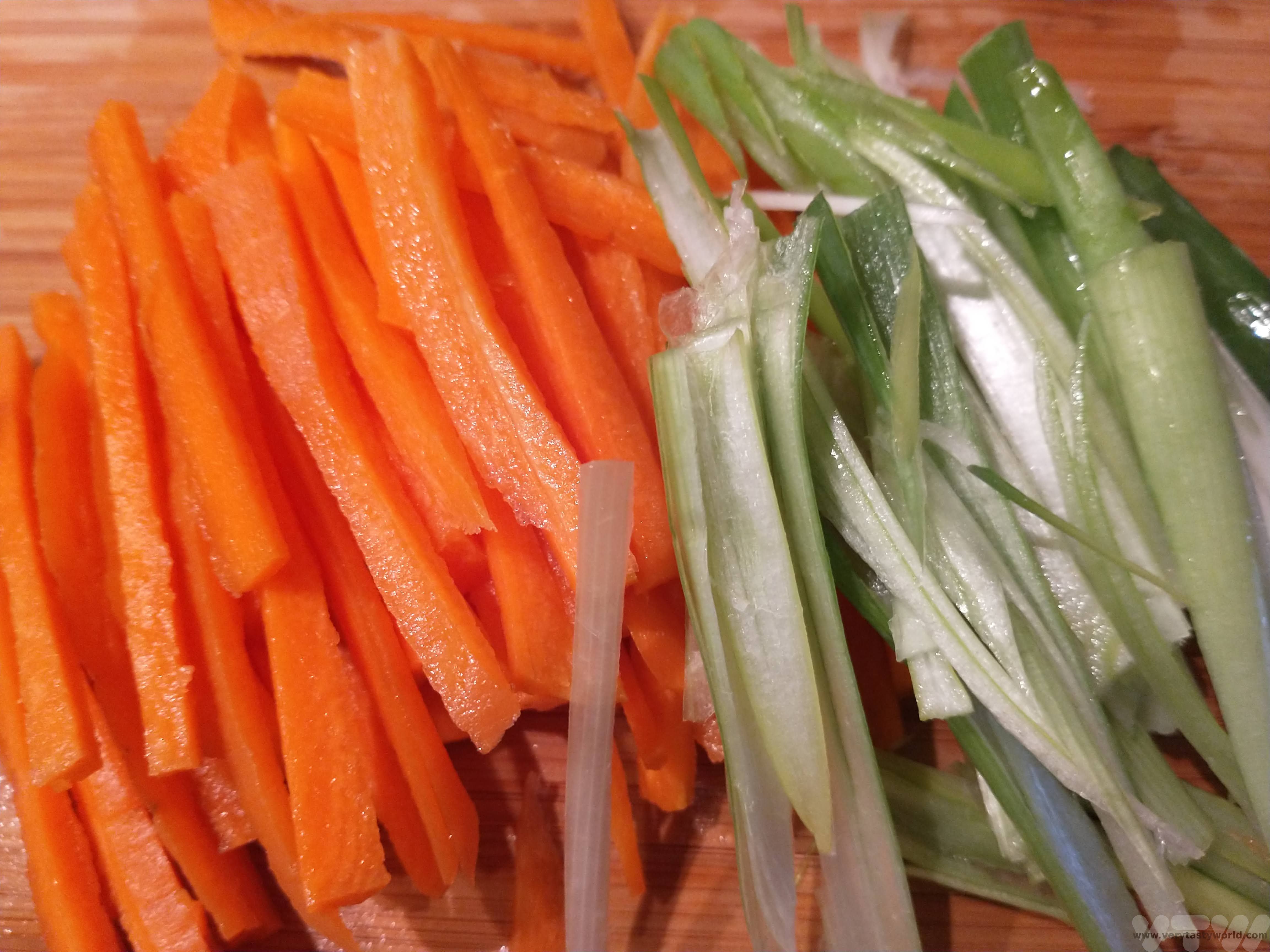
Put the garlic, ginger and fish sauce into a pestle and mortar and grind them together to create a paste. It will have quite a liquid consistency.
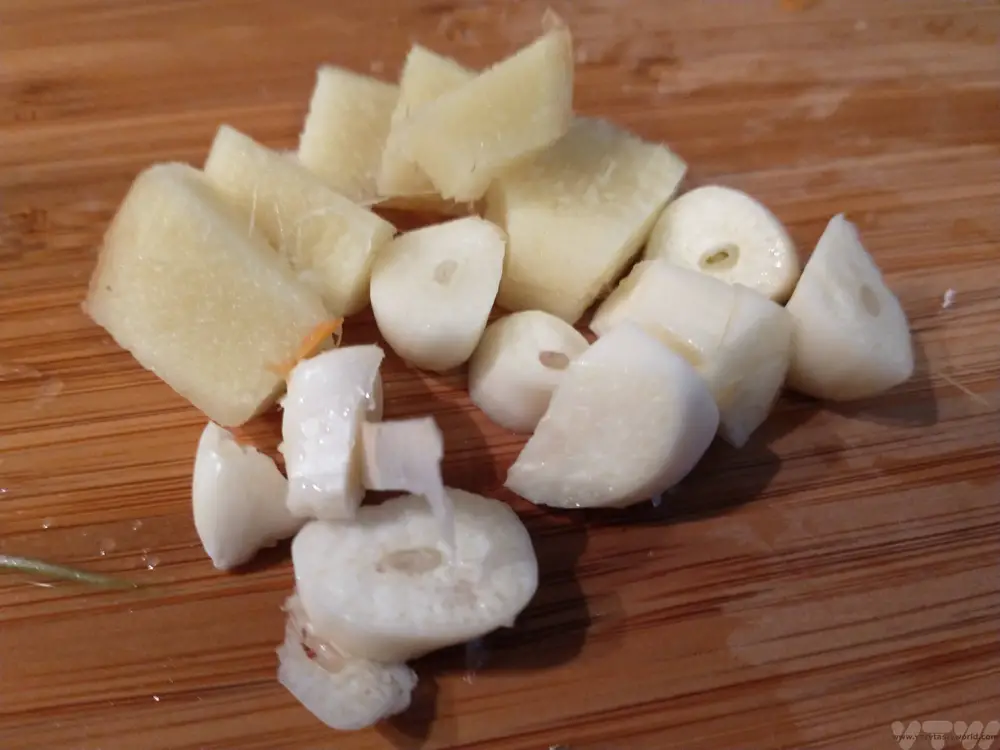
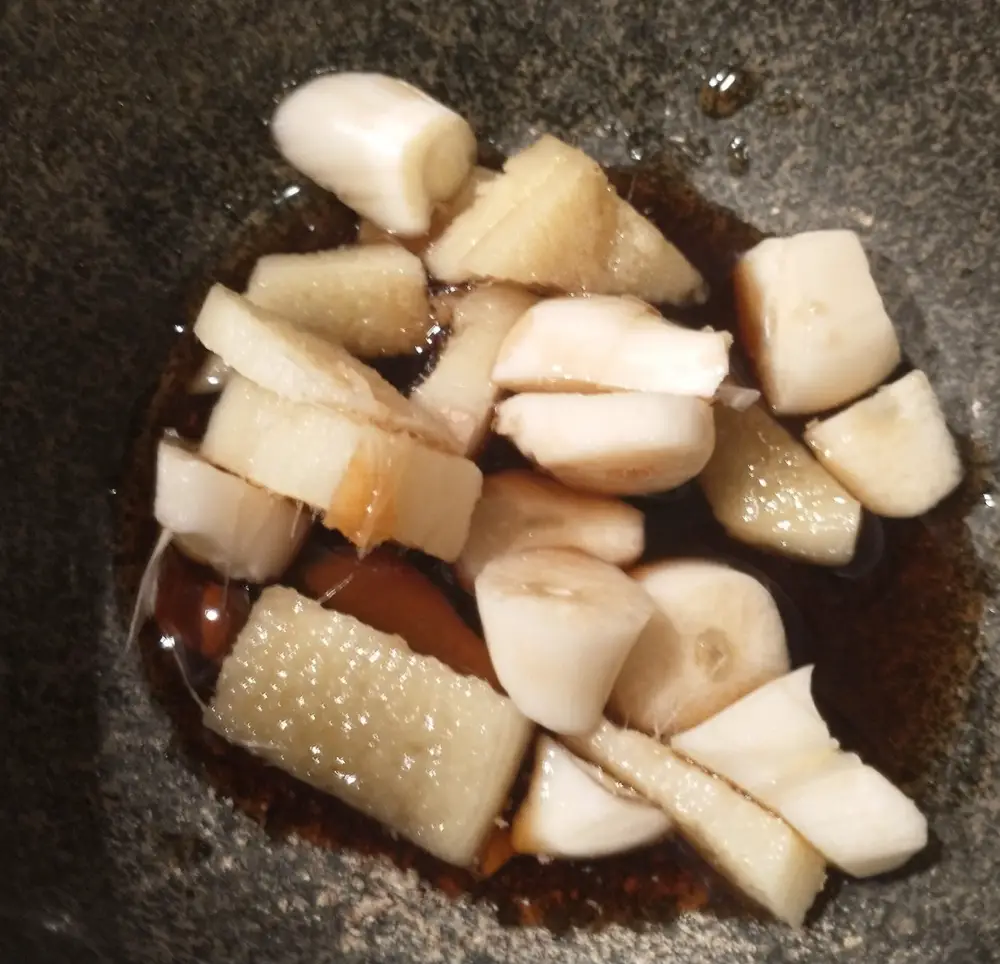
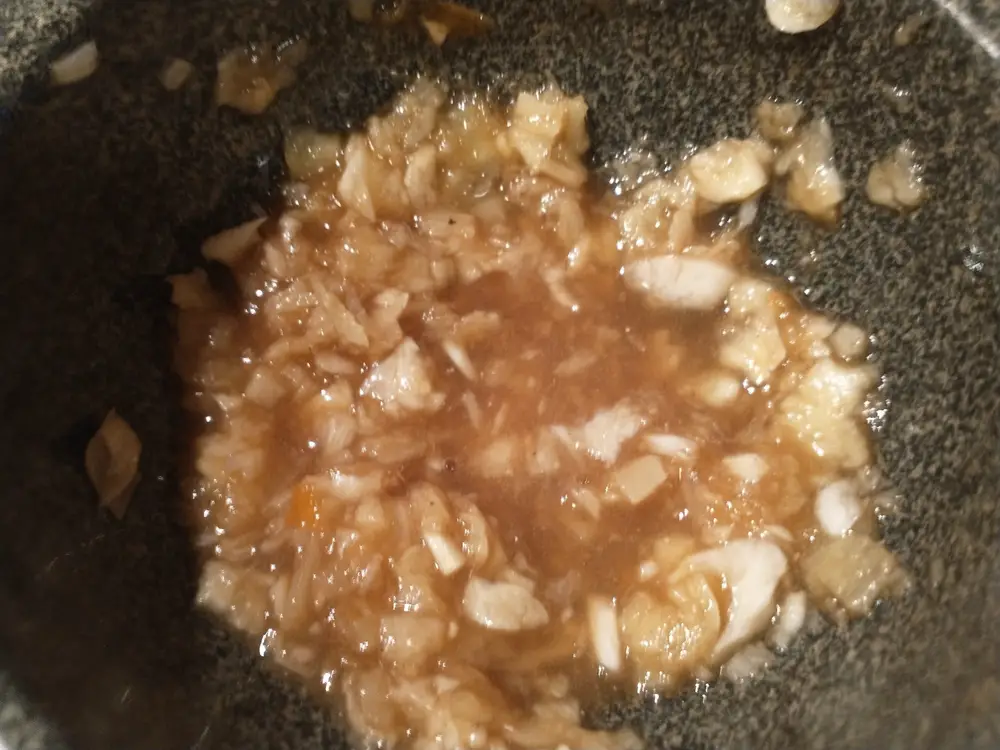
Add the vegetables to the cabbage.
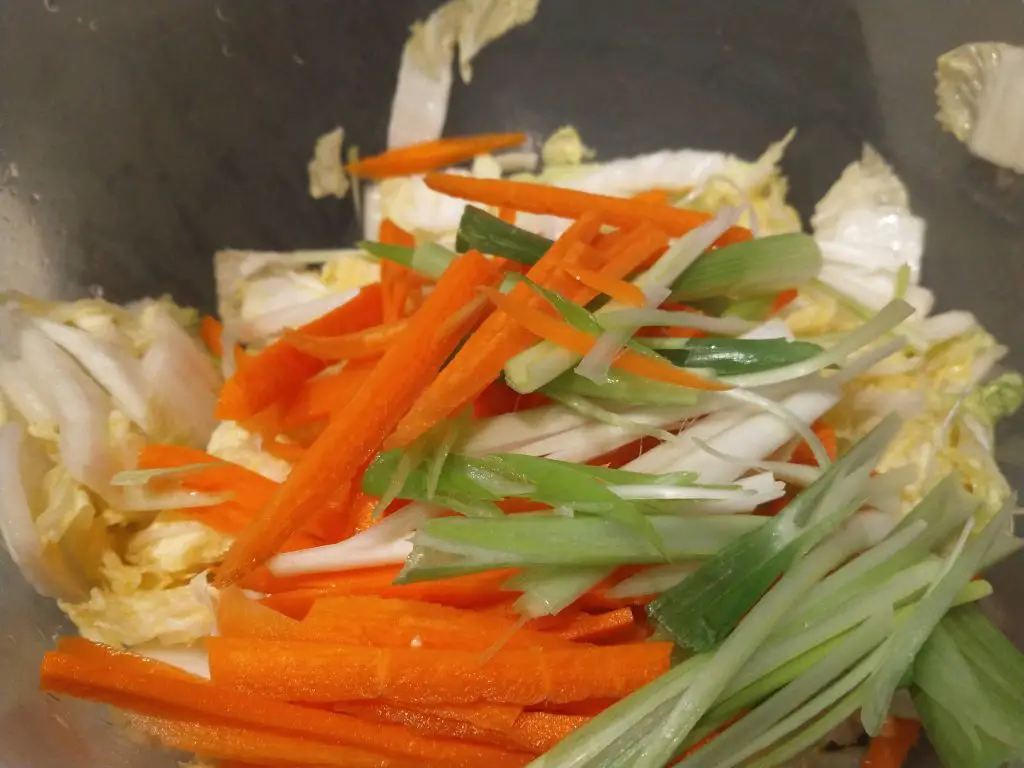
Pour over the garlic-ginger-fish sauce paste and sprinkle the chilli powder over the cabbage and veg. Mix well. We find it’s easiest to do this with our bare (clean) hands.
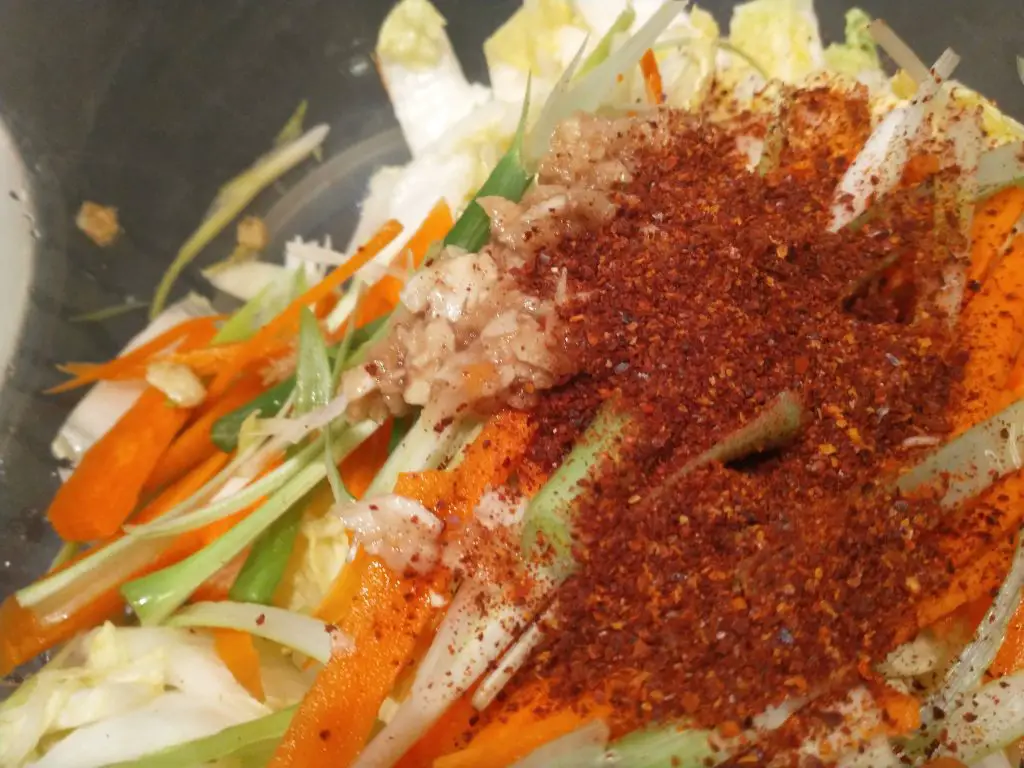
Then you need to pack the jar. Pick up handfuls of the cabbage mix and place into the jar, pushing down to squish it in – really pressing hard to make sure there aren’t any air gaps.
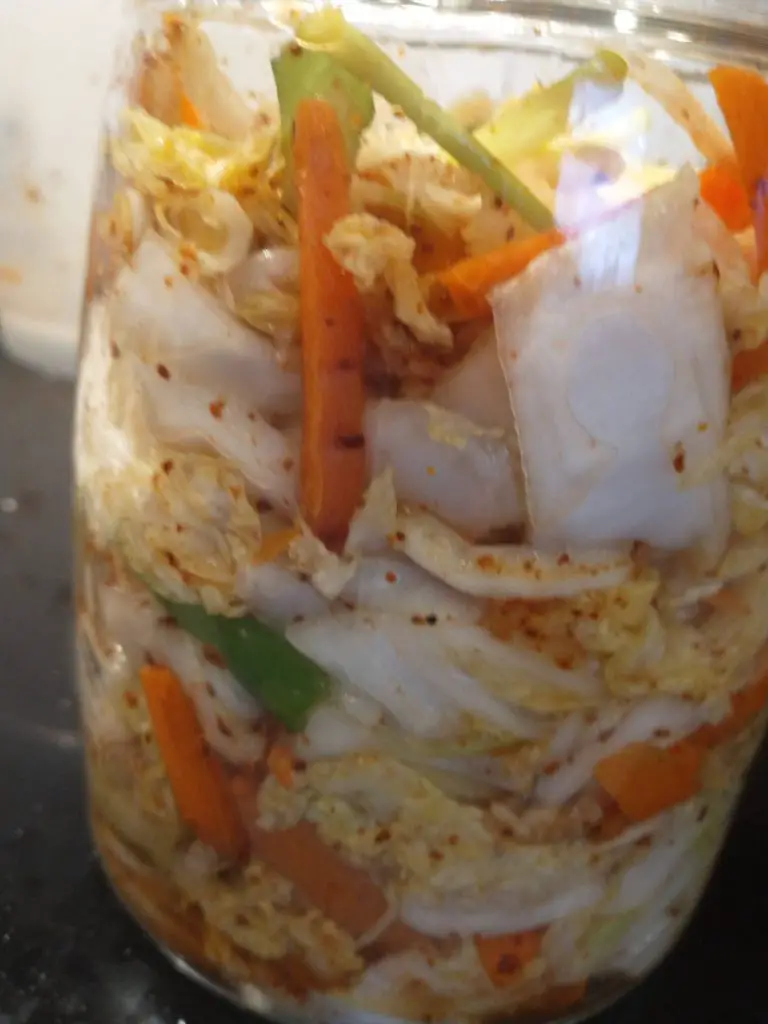
You should try and aim for minimum headroom at the top of the jar to reduce the air space. You also want to make sure the cabbage mixture remains pressed down. You can get all sorts of weights but a glass dessert ramekin type container (e.g. Gu) works well or, cheaper and less calorific than eating a chocolate dessert, fill a small plastic bag with water, tie at the end and squish into the top of the jar.
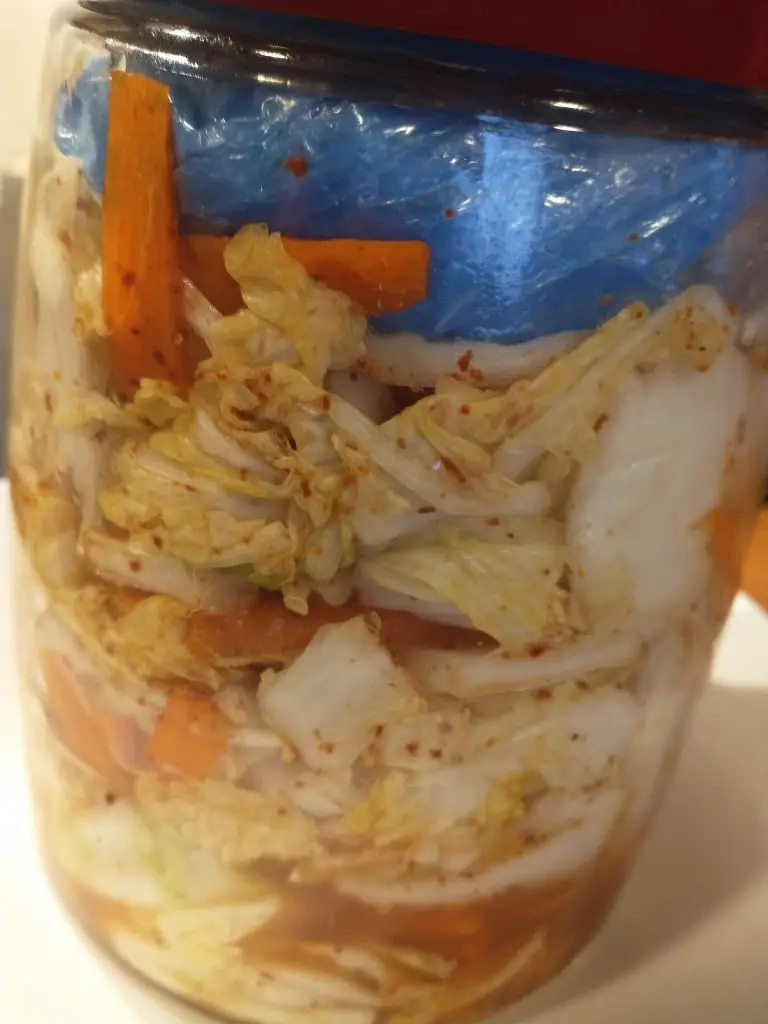
Close the jar and place the jar on a deep plate or in a bowl to catch any liquid escaping.
Check The Ferment Over Several Days
Over the next few days the cabbage will begin to ferment. The time it takes will depend on how warm the ambient temperature is. You’ll see a liquid start to form in the jar and cover the cabbage and the lactic acid bacteria will start to form lactic acid and C02. It is because of the C02 that you need to keep an eye on your ferment. If you are using a specific fermentation jar you should be fine. If you are using a conventional jar you will need to ‘burp’ your ferment, at least once a day. Open the lid – very briefly – and close immediately, just to let the C02 out. This will ensure that the pressure doesn’t build up. If you don’t burp there is a risk of the jar exploding. We’ve never had a glass jar break but there have been numerous occasions when I’ve burped the jar and ended up with a brine shower!
The kimchi should be ready within a week to 10 days. You can leave it longer if you wish and this will ensure further development of the flavours.

When the kimchi is ready you can store the jar in the fridge or decant it into smaller jars (just go through the process of cleaning them, then adding boiling water and letting them dry). The kimchi will store in the fridge for months as long as it is airtight.
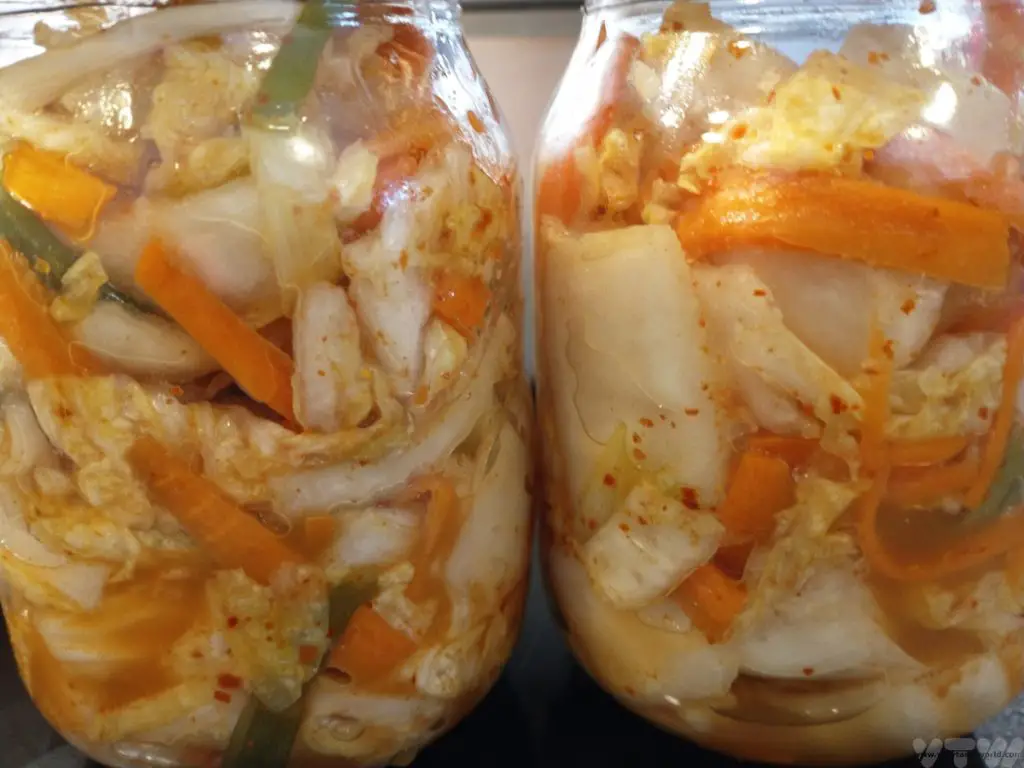
Beware
The two greatest issues with fermenting food is risk of explosion (which can be reduced/eliminated if you use the right equipment) and mould. When the ferment is exposed to air there is the potential for mould to develop. If you open your jar and see fuzzy mould of any colour you should discard the ferment. It’s heart-breaking but the safest thing to do as the mould could make you very ill. (It’s not advisable to scrape off the mouldy bits – by the time the fuzz has appeared the spores will have permeated the whole jar.) Obviously this creates something of a dilemma – you need to open the jar to burp but don’t want to let the air in. So, the key is to open the jar very quickly to release pressure then close immediately. With some types of fermentation jar you don’t need to worry.
Some Notes On Fermentation Equipment
You don’t need too much specialist equipment to ferment food. A kilner jar with a metal clip lid ‘self-burps’ – it allows CO2 to escape whilst not letting air (which can contain mould spores) in. You can get various fermentation vessels in varying sizes.
Salt should not have anti-caking properties.
You can get chilli flakes or gochujang in Asian supermarkets.

- RECIPE Oyakodon Donburi
- Zero Waste Recipes Before Your Holiday
- RECIPE: Vegetable Biryani Tamil Nadu Style
- RECIPE: Vegan Wild Garlic Pesto
- Recipe: Venetian Pasta Sauce
- RECIPE: Biryani Raita Recipe
- RECIPE: How to Make Costa Rica’s Gallo Pinto
- Recipe: Japanese Simmered Pork Belly – Buta no Kakuni
- RECIPE: How to Make Umeboshi
Please note that this post contains affiliate links. If you click the link and decide to make a purchase we will earn a small commission, at no cost to you, which helps towards running this site.
Noodle Review: Nong Shim Kimchi Ramyun Noodle Soup

Brand: Nong Shim
Flavour: Kimchi Ramyun Noodle Soup
Type: Instant
No. Of sachets: 2 – Dried Vegetables and soup sachet in red packet
Weight: 120g
Country: Korea
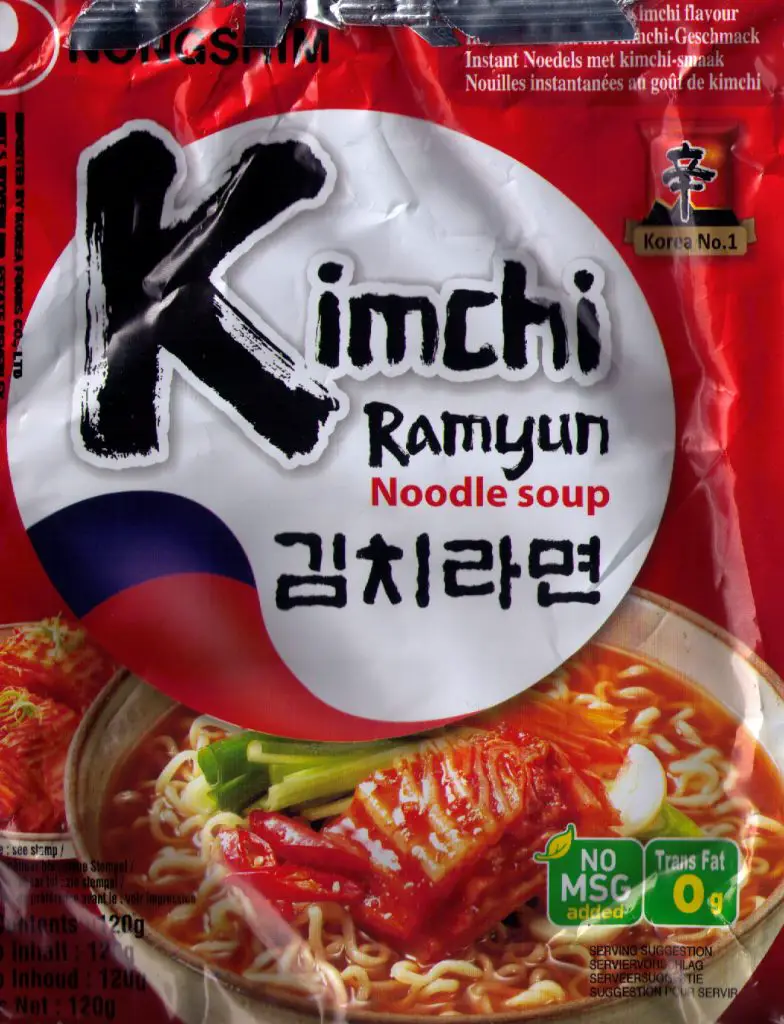
You may, or may not, know about a particular instant sachet of foodie fun, the Nong Shim Kimchi Noodle Soup set. But, fellow ramentics, the difference lies with the name, for the product on offer here is Nong Shim Kimchi Ramyun Noodle Soup. Note the six extra letters, but weight-watchers might also notice six extra calories giving a total of 426cal. But does the taste produce extra flavour even though the net weight of the product is the same and the net weight gain on you is different?
The soup sachet is distinctly different in appearance and description to its companion ramen: the green sachet on the Nong Shim Kimchi Noodle, marked with a yellow font declaring kimchi, was notably 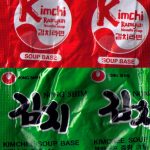 different to the extravagant red sachet which incorporates those extra words and a different font-to-background colour to emphasise its provocative declaration of ramyun flavour enhancement over the traditional option.
different to the extravagant red sachet which incorporates those extra words and a different font-to-background colour to emphasise its provocative declaration of ramyun flavour enhancement over the traditional option.
Well, the kimchi taste is still there and has a highly satisfactory flavour essential for a soup based kimchi noodle. The issue with many kimchi ramen lies with the flavouring which, when well implemented, is just what you want but there’s something manufacturers sometimes don’t get quite right with the texture of the noodles. Also, instant versions of products often have trouble properly realising the dried vegetables, particularly cabbage, which are essential in providing that kimchi familiarity. Here the vegetables rehydrate beautifully and even become crunchy. The soupiness is notably soupy when the correct amount of water is used. The real difference with the Nong Shim Kimchi Ramyun Noodle Soup is a distinctly pleasant, almost smoky, taste compared with the Nong Shim Kimchi Noodle Soup, which makes for a delightful subtle surprise. Even if there are those additional calories.
For reviews of other varieties of Nong Shim noodles you can follow this link.

Related Posts You May Enjoy
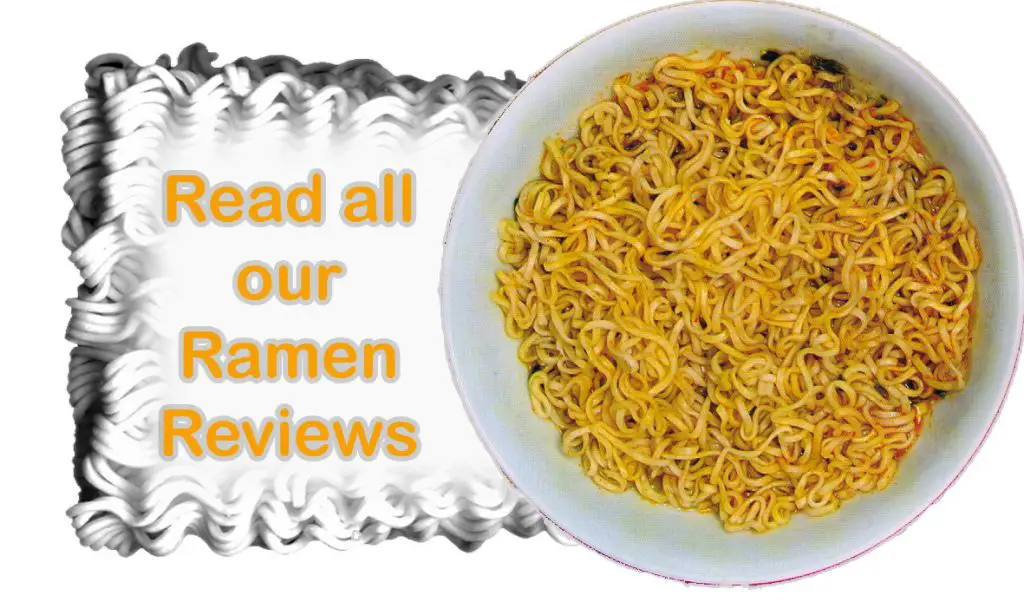
- Noodle Nirvana at the Yokohama Ramen (Raumen) Museum
- Noodle Review: Samar Noodles
- Noodle Review: Nongshim Instant Noodles
- Film Review: Ramen Girl (2008)
- Noodle Reviews: Myojo Noodles
- Noodle Review: Nissin Instant Noodles

